Odyssey of the Dragonlords by Libertad!
every day is one step towards uncertain doom
Original SA post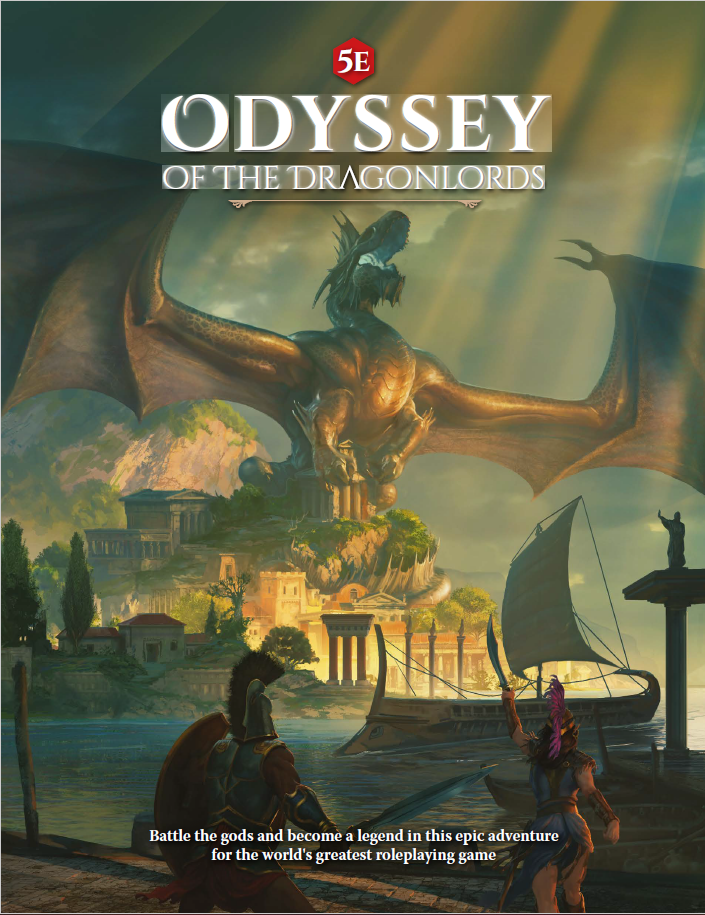
Greetings everyone, and welcome to my next Let’s Read! I know that I said I’d review SIGMATA, but I found myself feeling a lot more passionate about another book. As such undertakings take quite a bit of time and effort on my part, I felt it best to do the ones that fill me with the most excitement and energy.
Back in the 90s and early Aughties, Bioware was the most prominent studio that brought the Dungeons & Dragons rules to the realm of video games. Even their much-acclaimed Knights of the Old Republic used rules derived from the Star Wars D20 System. Although Bioware moved on to its own Intellectual Properties over time, the company brought countless gamers to the Forgotten Realms seeking to learn more about the vaunted cities of Neverwinter and Baldur’s Gate.
In a way, it wasn’t too unsurprising when the lead designers of said games (as well as Dragon Age: Origins) wrote up a 5th Edition-compatible adventure for their account of Baldur’s Gate. But that was not their only delve into tabletop; last year they advertised a very successful KickStarter for an original setting.
Odyssey of the Dragonlords is part setting, part level 1 to 20* adventure path that takes heavy inspiration from Greek mythology. The continent of Thylea is dominated by two divine pantheons, the Five Gods and the Titans, who settled into an uneasy Oath of Peace for 500 years. But the Oath’s magically-binding duration is coming to an end, and the PCs are spoken of in a prophecy to be Thylea’s only hope. As the wicked Titans muster their forces to bring ruin and devastation, every day is one step towards uncertain doom.
*the book advertises 1 to 15 but it got extended as a stretch goal.
Introduction
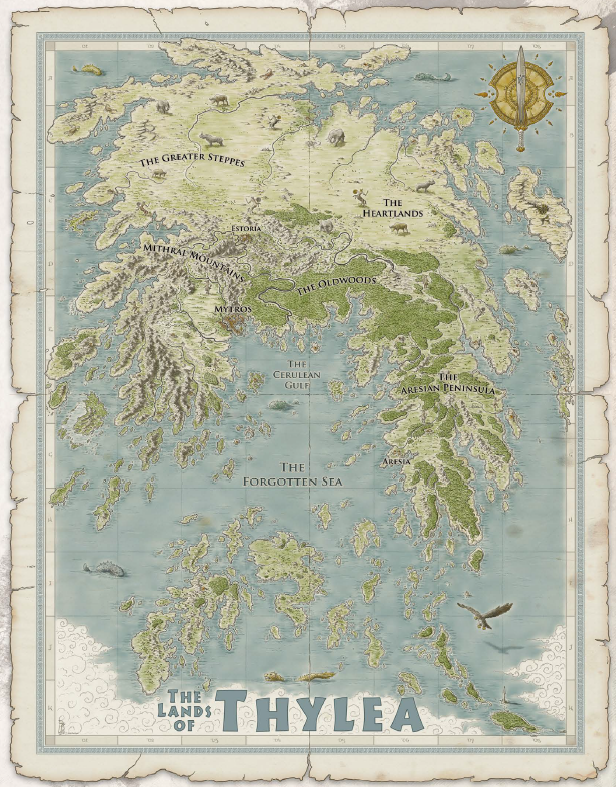
Our book opens up with a discussion of distinguishing tropes to make Odyssey stand out from the typical D&D faire. For one, the plot has high stakes: even at level 1 the PCs are assumed to be well-known and accomplished heroes with a few mighty deeds already under their belts. At low levels the rulers of city-states are calling upon an audience with them, and at higher levels they can even challenge the gods themselves who have convenient stat blocks for such a purpose. Oaths are powerful and cosmically-binding, and accruing fame from deeds nets you followers and power represented by a Fame score. Fate and prophecies are a gift and a curse which even the gods cannot defy, and the lives of mythic heroes have elements of comedy and tragedy.
The fate part is subverted in the adventure path proper, as some visions that can be averted and there are multiple ‘timelines’ the major Oracle character can witness. The comedy/tragedy thing isn’t really something one can do save based on the subjective tastes of the group. The adventure likely has potentially tragic moments (cities being destroyed, NPCs suffering cruel fates, adventure plots and backstories revolving around past injustices, etc), but more comedic and absurdist elements aren’t really present from my initial reading.
The World of Thylea: Thylea is an island-continent located in a remote section of the known world, guarded from the rest by the actions of the local gods. Ample islands and peninsulas reach off its southern shores, lush forests and valleys occupy much of the central area, while wild steppes in the far north are ill-explored save by nomadic bands of centaurs, cyclopes, and various monsters. Thylea’s recorded history stretches back 2,500 years, when much of the continent was home to fey races such as nymphs and satyrs, and the ur-cyclops race known as gygans* ruled a mighty empire. Two deities, the Titans Sydon and Lutheria, reigned supreme over the land and received worship and sacrifice by mortals. Over time, various refugees, sailors lost at sea, and other people from unknown lands found themselves on Thylea’s shores, where they had complicated relationships with the native races. Sometimes such conflicts were violent, and they beseeched Sydon and Lutheria for protection. Which they received, but not enough that they were capable of building civilizations beyond some meager far-flung villages.
*a smaller yet more intelligent subrace of six-armed cyclops.
This all changed when a group of warriors astride mighty bronze serpents known as the Dragonlords set wing and foot upon Thylea’s coasts. They helped the settler races build great cities and repel the worst of the centaur and gygan raids, and soon the Titans grew jealous at their status. The First War was waged, causing great devastation on both sides. As the last of the Dragonlords fell, a new pantheon of Five Gods came down from heaven to prevent the Titans from destroying all. Eventually an Oath of Peace was brokered between the old and new pantheons; the details were vague, but for 500 years Sydon and Lutheria swore not to take revenge upon Thylea’s mortals and in exchange they would continue to receive honor and tribute in the form of temple maintenance and daily sacrifices.
But as of the campaign’s beginning, it is mere months before the Oath of Peace ends, and the famed Oracle prophecies the Doom of Thylea. Where even the gods die and the mortal races are wiped off the face of the earth. The PCs, notable heroes in their own right, are summoned by her to find ways of averting this dire prediction.
Powers, Factions, & Mortal Kingdoms of Thylea: These next three sections discuss religion and politics of the setting. Beginning with the deities, it is known that the gods and goddesses of Thylea are not the only ones out there, although foreign gods from the wider world leave Thylea largely untouched and their worshipers are few in number beyond some storm-tossed foreigners. The two major pantheons are the Ancient Titans and the Five Gods, although there are Forgotten Gods whose names and power grew few to the point that they are rarely honored outside of specific groups. With a few exceptions the gods do not dwell in separate planes of existence, but live in the Material Plane so as to keep a closer watch on their mortal charges. For example, Sydon spends much of his time in the lighthouse-fortress Praxys, while Pythor and Vallus are the ruler and wife of a ruler, respectively, in two of the larger city-states. Narsus, the God of Beauty, is not technically ‘forgotten’ but is the patron god/prisoner of the city-state of Aresia.
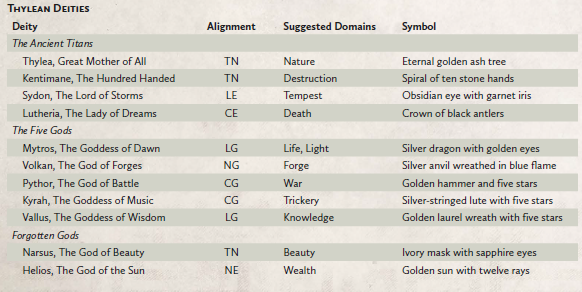
As you can see by the above, the Titans are the more ‘natural,’ cruel, and tempestuous of the pantheons. Thylea is the oldest titan, for it is said that the very continent is her body, her limbs extending as deep roots throughout the earth. Kentimane is Thylea’s husband, a gigantic being who stands taller than the highest mountain and regularly patrols the seas around the continent so as to guard his wife’s tomb from outside threats. The twins Sydon and Lutheria are the two surviving children of Thylea and Kentimane, their siblings long since murdered or imprisoned at the hands of their wicked kin. Sydon is a tyrannical deity in control of the seas and storms, and he longs for a world where all bow to his feet. He brooks no worship of any other entity besides his sister Lutheria, and even then only grudgingly. Lutheria is a cross between Hades and Dionysus, a harvester of souls and granter of insanity who encourages her followers to care about nothing but themselves and take what they will without consequence. Unsurprisingly the squickier elements of Odyssey shine through involving her or her worshipers; most NPCs who are sexual predators are loyal to her, and the goddess herself is a rapist in the “use enchantment magic to make people have sex with each other” kind of way.
The worship of Sydon and Lutheria is a controversial one among mortal society; people make sacrifices to Sydon more out of fear than loyalty and for safe voyage, and many find Lutheria’s doctrines disgusting. But Lutheria has devotees among some noble houses, her followers control the wine trade, and they host some of the larger public holidays which makes her a tolerated evil.
The Five Gods are the new pantheon, and unlike Sydon and Lutheria their acts of folly extend more to irresponsibility and lapses in judgment than outright sadism or malice. Mytros is the Goddess of Dawn and for whom the largest city-state is named. She is now back in the celestial realms after a battle with Sydon and Lutheria, and is by far the most common deity for clerics among the settler races to worship. Volkan is the God of Craftsmanship and invention, and is also the Santa Claus equivalent of the setting where he travels during the winter solstice as children await his gifts and sweets. Pythor is the God of War and has ruled over the city-state of Estoria for centuries after overthrowing its tyrannical king, and while popular his impulsiveness and alcoholism has dulled his ability to make wise decisions. Vallus, the Goddess of Wisdom, was once a traveler of the world and a collector of lore. Now she serves as the wife to King Acastus of the City of Mytros, and is prayed to for those seeking wisdom in overcoming some dilemma. Finally, Kyrah the Goddess of Music is a cross between Hermes and Apollo, known for being a quick-stepping trickster who provides inspiration to musicians and artists of all stripes.
Thylea has Mortal Kingdoms but no true nation-states or empires in modern times. Generally speaking, society is divided into two groups: the three major city-states and smaller settlements under their protection, and various independent tribes and villages who are scattered yet self-sufficient. The native races largely fall into the latter category barring a few exceptions such as the satyrs who are fond of visiting larger settlements.
The city-state of
*Apologies for not knowing what Greek City-State it’s based on.
We get a look at the ten major factions of Thylea, organizations who are either tied to a political or religious group or a power in their own right. Many of them check off typical fantasy trope boxes: the Cult of the Snake is a notable Mytrosian thieves’ guild, the Academy of Mytros is the foremost center of learning where philosopher-wizards hang out to share spells, the Order of Sydon is a paramilitary organization taking increasingly violent action against temples of the Five, the Centurions* of Mytros are said city’s standing army, and the Druids of Oldwood worship Thylea and make sacrifices to her to atone for the ‘original sins’ of the settler races’ presence on her land. The Temple of the Five and the Temple of the Oracle are institutions dedicated to the Five Gods and Versi the Oracle respectively, and only the former gets involved in secular politics with the Oracle being more removed from mundane affairs. The last three factions are monstrous in nature: the remnants of gygan tribes band together in small families and seek vengeance against the settler races, the centaurs of the Steppes war upon each other and the city-state of Estoria when they’re not partying and stargazing, and the Raving Ones are maenad worshipers of Lutheria who dwell in caves and shadowed glens, ambushing unlucky travelers to rob, torture, and sacrifice to their patron.
*hey, that’s a Roman term!
The inhabitants of Thylea are collectively referred to as Mortals, even those among the native and fey races to distinguish them from the more monstrous and divine entities. The ‘native races’ include the more classic Greek mythology creatures: centaurs, the various cyclops subraces (who are sadly non-playable), medusae, minotaurs, satyrs, and sirens. The ‘settler races’ include the standard PHB stock, and are pretty much assimilated wholesale into greater Thylean society beyond a few rare exceptions: orcs do not exist on Thylea so the half-orcs are a small community in Mytros, while tieflings are referred to as “Stygeans'' and live in Mytros’ ghettos due to a believed association with Lutheria. Dragonborn are virtually non-existent, and if one were to show up the average Thylean may think them to be either a monster or a scion of the Dragonlords.
The inclusion of the non-human PHB races is perhaps the most obvious case of ‘square peg round hole’ for importing D&D tropes into Odyssey. Most NPCs who aren’t of the native races or monsters are humans, and there’s no real place in the world for elves or dwarves that makes thematic sense. I find that the native races more or less fill most of the PHB races’ roles: centaurs and minotaurs are strong warrior guys, nymphs are nature-loving magical people, medusae are the cursed and shunned outcasts, and satyrs and sirens have Dexterity bonuses and racial features which are good for subtle distractions and/or mobility. The only real thing missing is a half-elf ‘jack of all trades’ or Small-sized races like gnomes and halflings.
We briefly get into the Laws and Oaths of Thylea. They are magically-binding aspects of the world which virtually all native Thyleans know, and even the gods can be limited by them. Generally speaking if a person swears to do or not do something, then they suffer some persistent misfortune should they intentionally break the oath. The Furies, who are not gods but very powerful beings, are three women tasked with interpreting and enforcing said Oaths. They dispatch erinyes to take the more egregious Oathbreakers to their own special hell in the afterlife known as the Island of Oathbreakers.
The most common types of Oaths are Guest Friendship (hospitality to those who invite you into their home) which is used for neutral meeting grounds and periods of peace even between sworn enemies; an Oath of Peace, where the swearer promises to commit no violence against them or their servants; an Oath of Protection, a one-time promise to come to a person or group’s aid in times of crisis; and an Oath of Service, where someone swears to perform one task on behalf of an individual. This last one is the most rare for said task is open-ended and the beneficiary of the Oath can ask them to perform dangerous, suicidal, or even wicked deeds.
We also get a list of sample curses for those who break Oaths, but can also be for those who otherwise anger the gods or commit some other great crime. They are persistent conditions which worsen over time and are typically only cured via powerful magic or rectifying the original misdeed. Curse of the Harpy and Curse of the Medusa transform the victim into the aforementioned monster types, while Curse of the Graverobber makes all food non-nourishing and slowly starves the tomb-robber to death.* Finally, Curse of the Treacherous causes the Furies to dispatch a trio of erinyes devils with special spells and equipment (entangling ropes, plane shift, etc) to kidnap the unfortunate soul and take them to the Island of Oathbreakers.
*this is only inflicted on those who steal from holy sites; otherwise the average adventurer would be in deep shit.
Epic Paths
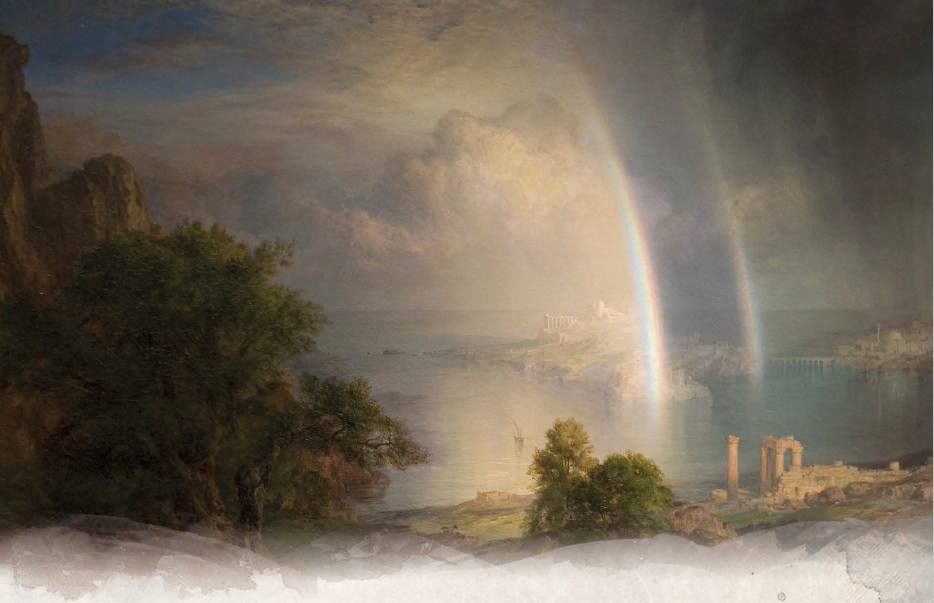
Epic Paths are one of the larger aspects of Odyssey of the Dragonlords. Added on in addition to standard backgrounds, they are aspects of a PC which tie them into the larger plot. There are certain points in the Adventure Path where a relevant Epic Path will provide an alternative means of solving a task, bonus quests and rewards, fosters a relationship with an existing important NPC, and in some cases explains what the PC was up to before the start of the campaign.
Barring one exception they are all mutually exclusive, so every PC must have a different Epic Path than the rest of the party. Additionally, each Path has a Divine Boon of some sort where the PC can be rescued them from death for free only once in the campaign. It may take the form of a notable NPC coming to resurrect them, fate turning things in their favor at the last moment, the spirit of a loved one possessing their body to bring them back from the brink of death, and so on and so forth. Furthermore, there’s a Divine Blessing which is gained via completion of the Epic Path’s overall story, and some can end earlier than others on the Adventure Path.
The Paths’ entries outline the various milestones encountered during the adventure, but said adventure sections in the appropriate chapters also make callbacks in handy little sidebars for user-friendliness. For said reasons I won’t cover them here but instead during the review of relevant chapters.
Demi-God: The PC is one of Pythor’s many bastard children, and the god feels in his heart that their progeny will succeed where he failed and maybe take his place as the God of War.
Vanished One: The PC is the last surviving Dragonlord, but the Oracle Versi became obsessed with them and jealously took them as a favored pet/implied concubine a la Odysseus and Circe. Her magic helped the Vanished One be virtually ageless, but ephemeral time spent in a secluded cave has dulled their abilities.
Doomed One: Lutheria has a thing for murdering children, and sacrificing babies is one of her cult’s most infamous rites. The PC parents were part of her cult but refused to offer up their only child for slaughter. This earned their death at the hands of the goddess’ many servants. Lutheria’s minions have tormented the PC ever since and making their life hell, the goddess viewing the whole affair as incredibly funny.
Unlike the other Paths, the PC can be resurrected immediately twice upon death, but the third time they remain dead forever unless or until Lutheria is destroyed.
The Haunted One: The PC had a happy idyllic life with a loving family. But a prophecy foretold that the PC will find a way to overcome death itself, thus posing a threat to Lutheria’s dominion. So she used her powers to gather the souls of the PCs’ loved ones in her scythe. But she made one mistake: the PC somehow escaped her clutches thanks to Mytros shielding them and erasing all memories of their legacy from reality. But the PC remembers what they lost, if not necessarily the deities involved.
The Gifted One: Like the Demi-God the PC has a divine bloodline, but as one of Sydon’s grandchildren. The cruel god murdered his mortal wife, but was unaware that she gave birth to a daughter, who is in turn the PC’s mother. Said PC is destined to restore the glory of the Dragonlords and defeat their grandfather.
The Lost One: The PC is the survivor of a shipwreck from a foreign realm outside of Thylea, and more than one PC can choose this Epic Path. This one has the last least ties to the adventure path, and its main goal is to find a way back home.
The Dragonslayer: The PC’s village was wiped out by a dragon raining flaming breath down upon hapless innocents. Said ‘dragon’ is actually Helios the Sun God (something not known immediately), and the Epic Path revolves around hunting down and slaying the one who took everything from them.
The Cursed One: The PC hails from a family or tribe who carry an ancestral curse from the Titans’ wrath. The PC has faced a life of difficulty, and their brethren are fated to die off within a generation if a means of lifting the curse isn’t found.
Guidelines are provided for the DM to make their own Epic Path; the advice focuses mostly on how to ideally space the magic item rewards based on level, making granted special powers equivalent to Epic Boons from the DMG, NPC mounts and companions should be of CR 3 or lower, Divine Blessings follow the guidelines for Supernatural Gifts (Blessings unsurprisingly) under the DMG’s Other Rewards section, and the Divine Boons should involve a key NPC from the plot riding in as the cavalry to save the PC’s now-dead bacon.
The remaining sections are short entries which can be better summed up in future chapters: an Adventure Overview outlining the plot in bite-sized chunks as well as recommended Fame and Experience Levels for the major Chapters, advice on Session 0 prep and how the PCs came together, and sample advice for role-playing the more notable and recurring characters of the Adventure Path (most notably the gods). The last part of our chapter is a picture of the Thylean alphabet which is similar to the one of Ancient Greece’s.
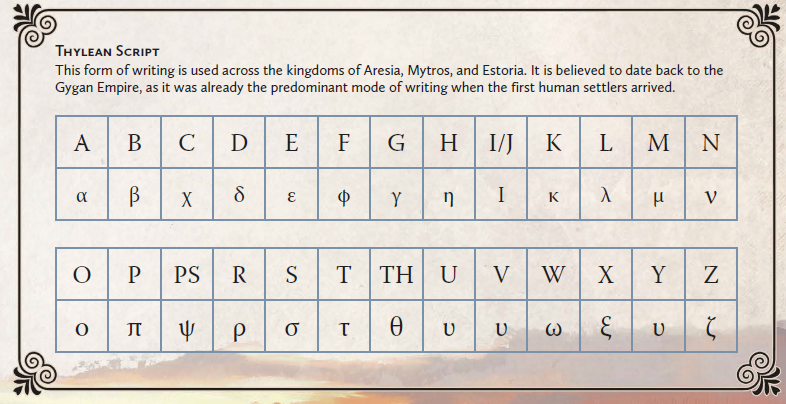
Thoughts So Far: I feel that this is overall a rather good introduction to the world of Thylea. We didn’t get into any deep detail or new mechanics and rules, and some of the entries feel like they’d be more appropriate in later sections on account that they show up much later in the book. I do find it rather funny how the city-state with the God of War as ruler is not the one ripping off of Sparta, though.
The mechanics-facing aspects of the Epic Paths show up in the appendix, and speaking of which they’re a mixed bag. Some of them have more pertinent ties into the world and larger plot, such as the Demi-God and Haunted One. Others feel more like side-plots at most such as the Cursed One, Lost One, and Dragonslayer. The Vanished One being captive by an incredibly possessive character has quite a few warning bells,* and given that the Oracle is meant to be a major patron and the person who summons the call to adventure for the party in the first place, it is the kind of thing that may require a social contract or Trigger Warning for the gaming group to clear beforehand. Additionally, the Doomed One and Haunted One are too close in concept (Lutheria took away your family) and their relevant plot points are also the same. I understand that trying to make enough potential paths which have differing consequences echoing throughout an entire campaign can be difficult, so my criticism on the sameness front is a bit muted.
*like making the PC swear an oath to return to her cave when all is said and done, trying to murder characters they fall in love with, and also restoring said PC to life via a kiss as the Divine Boon.
All in all, I feel that this is a good introduction, but some things can be ordered better.
Join us next time as we cover new options for PCs: races, class archetypes, spells, equipment, and the rewards and Divine Blessings for the Epic Paths!
Creating Heroes
Original SA post
Creating Heroes
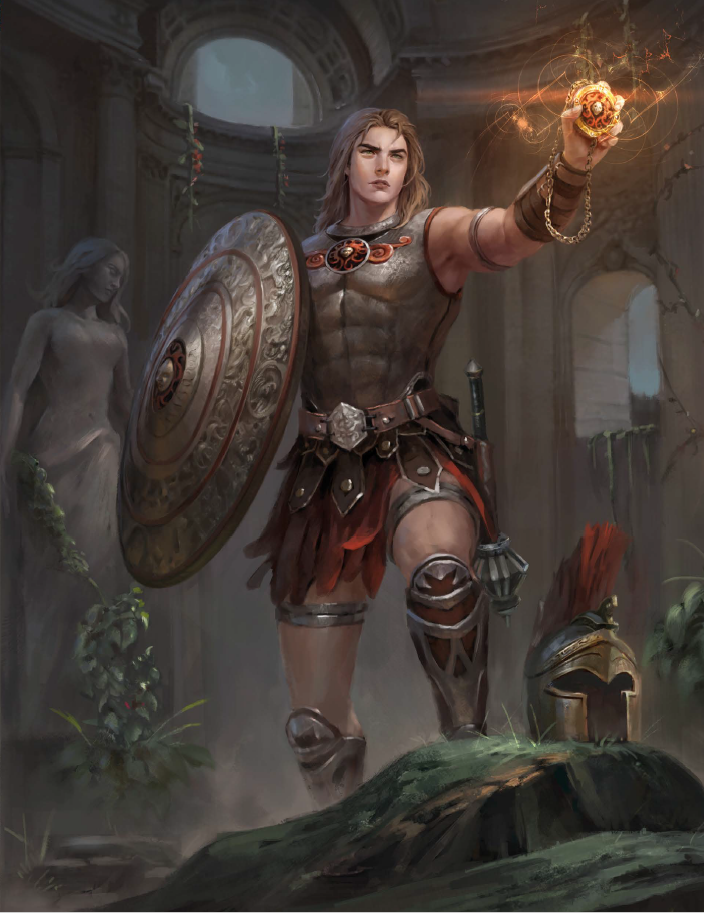
Technically speaking these sections are part of the book’s appendices, but they are featured in a free PDF Player’s Guide meant to help players create characters. It also covers important details for a few of the races which are expanded upon in the adventure path proper, so here I am doing it first!
This part of the book goes over things repeated in the Introduction, but adds that dragonborn are descended from one of the bronze dragons who flew the Dragonlords to Thylea. Thylean names have a predictably Greek flavor, although ones from other cultures may be present such as family lineages from a settler races’ homeland. Recent arrivals to Thylea have trouble fitting in, partially on account that certain cultural expectations are presumed to be common knowledge on par with “don’t throw salt on your farm soil” and thus never really explained to foreigners.
Technology is at a Bronze Age level. Iron, mithral, and adamantine are incredibly rare and typically reserved for making magic weapons and armor, and things like platemail and crossbows are cutting-edge technology made only by the most learned artisans and Volkan the God of Forge. Most of the city-states’ standing armies outfit their soldiers in spears, shields, and shortswords with leather armor and gather them in phalanx formations. The spear is the only common polearm, and other heavy two-handed weapons are looked down upon as something only barbarians use. There’s some new weapons available, such as the kopis and xiphos (shortsword variants), the chakram (can be used in melee and as a thrown weapon), the dorata (thrown spears that come in pairs), and the makhaira (curved longsword with greater stopping power on horseback).
We have rules for Fame which are rated on a scale from 1 to 20 and come with increasing benefits. At lower levels of 1 to 10 they include things such as free service at local establishments, advantage on social skill checks during festivals, and higher chances of being recognized in population centers. 11 to 15 you become a household name in Thylea: people build statues of you, politically powerful figures give you minor magic items, and small shrines bearing your likeness are tended over by priests who can forward wealth to your holdings gathered as tithings. 16 to 20 you have huge temples, rival gods fear your power, and at 20 you become immortal and qualify for the Theogenesis ritual which can turn you into a god!
The Epic Paths’ magical items and Divine Blessings are outlined here. The amount of magic items differs a bit, ranging from 2 to 6, although in the case of the Gifted One and Vanished One they can get a dragon companion and eventual mount as part of reviving the legacy of the Dragonlords. Most of the Divine Blessings are constant defensive boons, such as the Cursed One gaining immunity to all curses, diseases, and poison, the Demi-God gaining +2 Constitution (max 22), or the Lost One gaining a 1/long rest ability to reroll any d20 roll but must keep the new result. Many of the magic items are broadly useful: the player can pick from a small list of items to be the reward for the quest/treasure vault/etc. so they don’t end up ‘locked in’ with an option that is class-restrictive. I rather like this choice, for it encourages player agency and better allows said PC to get useful and thematic rewards.
Playable Races
Greek myths contain some of the most iconic monsters in fantasy gaming, and it’s only appropriate that some are upgraded to PC-worthy material. A few are expected, such as the Centaur, but we get some odder choices such as the Medusa. Unlike their original myths none of them are gender-locked: satyr ladies and siren men exist, and while it’s in the later “monster appendix” the book says that nymphs can also be both or neither gender.*
*no mention of nonbinary identities is made for other races or elsewhere in the book, though.
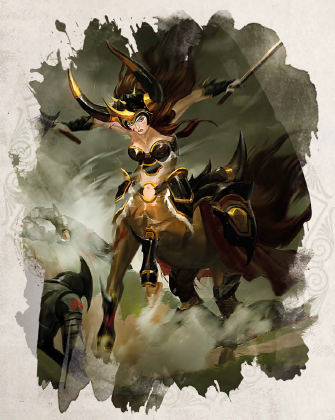
Centaurs are proud nomadic people who live in the northern steppes and shrouded woodlands of Thylea. They claim descent from a now-unknown god of war and expect others to give them the proper respect due to this. Centaur tribes are loyal to the titans, preferring Sydon or Lutheria, and bear a grudge against the Dragonlords and Five Gods for the violence inflicted upon them during the First War.
In terms of game stats they emphasize strength and mobility: +2 Strength and +1 Wisdom, speed of 40 feet, a special charge action that grants bonus damage, and the ability to allow a willing bipedal ally to ride upon them for 1 round as a bonus action on the centaurs’ part. They are Medium, and their equine frame means that they treat unfavorable terrain as difficult; they can still climb and walk up stairs, it’s just harder to do so. Overall a fine race, if a bit one-note.
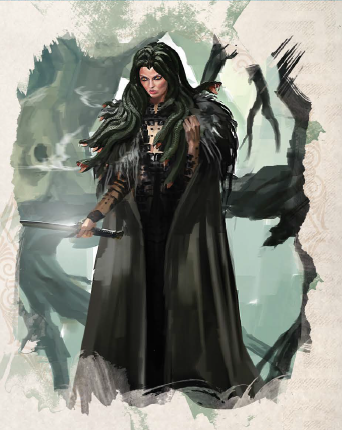
Medusae are mortals who made a bargain with a dark power or broke an oath, afflicting them with the Curse of the Medusa. Legends speak that the first among their number was a greedy woman who desired wealth and spurned the native races of Thylea during her travels. The Fates granted her wish, to turn all she witnessed to stone so that thieves would not steal from her, her hair became as snakes “to always have company as cold as your own.” Although the circumstances are different for each individual medusa, Thylean society at large distrusts and fears them for their powers and unspoken misdeeds.
Medusa have +2 Dexterity, +1 Intelligence, darkvision 60 feet, and have a natural weapon with snake-hair that can grant the poison condition if the target fails a Constitution save. They have advantage against poison effects of all kinds and at 5th level they gain a paralyzing petrification gaze which can permanently petrify a target if they fail their Constitution save 3 times. Unlike other features the petrification DC is not modified by ability scores or proficiency bonus, starting at a mere DC 8 and growing to a maximum of DC 14. Still, the poison condition is a very useful status effect to inflict upon enemies, and further attempts at petrification on the same target in battle are bonus actions and the save is made at disadvantage, and 3 failed saves even from different medusae cause instant petrification. A party of medusa have a good chance of ‘stun-locking’ an opponent, so they’re a pretty good choice as a race.
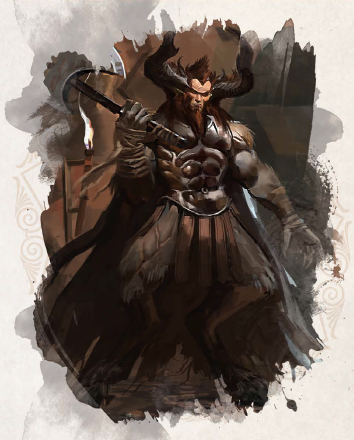
Minotaurs had ancestors that were human once, but it is said that their people became like bulls due to being cursed by Sydon because they chose instead to worship a magical bull on account of said bull tilling the soil with never-ending strength to help them survive a winter. The God of Sea and Storms made them like said draft beast, forced to pull plows which carved labyrinthine canyons until they broke free and could walk upright...yet remained forever changed.
In modern times Thylean society (both native and settler races) view the minotaurs with disdain, as unthinking brutes useful only for manual labor. In Mytros they are victims of a legal slave trade and sometimes used as sacrifices, especially by Sydon’s worshipers. In Aresia things are more tolerant, and they’re given the same rights as citizens of other races.
Minotaurs as a race are geared for pure martial pursuits. They have +2 Strength, +1 Constitution, 40 foot base speed, advantage on Perception checks via smell, traversing maze-like environments, and dealing with maze-like puzzles. They have 60 foot darkvision but are colorblind and can only see in shades of red and grey. At 5th level they can transform into a bull as a bonus action 1/long rest, and a dire bull at 9th level (with handy-dandy stats in a sidebar!). As damage absorbed in Polymorph mode does not carry over unless you drop to 0 HP in said form, minotaurs are another strong option for martial types.
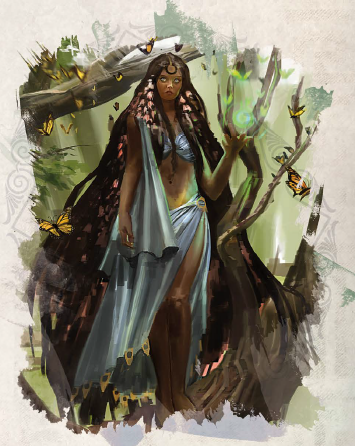
Nymphs are fey spirits forged from the natural foundations of the world. Although they prefer the wild reaches of Thylea, they are fascinated by the affairs of other races and it’s not uncommon for them to visit villages and cities for short visits. They are a bit hard to get along with, as they’re more prone to seeing non-nymphs as favored pets to be watched over rather than as a friendship of equals.
Legend speaks that the natural features of the land gained questions, wondering what separated them from each other: the snow on the mountains wondered if they were like the rivers and streams, who in turn wondered if their winding paths were like the roots of trees. Thylea granted their questions meaning, allowing them to become the first nymphs and find the answers for themselves.
Statwise nymphs have a base race and five subraces themed after specific natural features. The subraces gain advantage on Survival checks when in such favored terrain and cast certain bonus spells at 3rd and/or 7th level every short or long rest. All nymphs gain +2 Charisma, +1 Wisdom, are proficient in Persuasion, and can cast Charm Person 1/rest. Aurae are spirits of the sky and air, gaining Darkvision 60 feet and the faerie fire and levitate spells. Dryads are people of the forest, can speak with animals and plants at will, and can cast Goodberry and Barkskin. Naiad are river fey bearing a deep bond with rivers and are thus the subrace that is closest to mortal settlements: they can hold their breaths for 1 hour, have a 40 foot swim speed, and can cast Create or Destroy Water and Control Water. Nereid are of the seas and like Naiads adapt easily to civilization but are rarer; they can breathe underwater indefinitely, have a 40 foot swim speed, and can cast fog cloud and water walk. Finally oread were birthed from the mighty mountains and are peerless hunters; they have darkvision 60 feet and can cast the hunter’s mark and misty step spells.
Nymphs gravitate more towards a spellcasting roll, and their spells are useful for a variety of situations. Given that a rather large portion of the campaign takes place at sea and in one case beneath the waves, the naiad and nereid subraces are very good options on account of their swim speed.
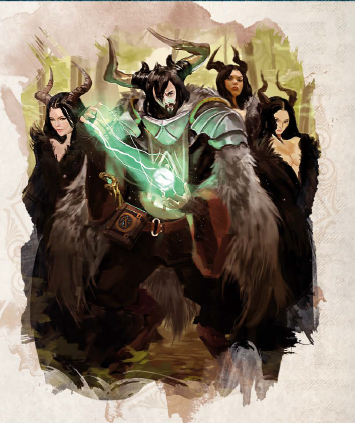
Satyr are fey that come from the woods, but are just as comfortable living in settlements and all the pleasures they bring. They have better relations with the settler races than other native kindred, and can be found in quaint villages and even the great city-states. They are fond of wine, song, and sex, continuously seeking various kinds of emotional heights to avoid boredom.
Satyrs are built to be bards and little else. They have +2 Dexterity, +1 Charisma, advantage on effects which impose charmed and frightened conditions, and cannot be put to sleep. They are proficient in a single musical instrument of choice, gain advantage on all Performance checks with said instrument, and can perfectly memorize and perform any song after hearing it once. They know the minor illusion cantrip, and at 3rd and 5th levels they can cast sleep and suggestion once each per long rest, provided they use an instrument with which they’re proficient in the casting of the spell.
While in line with their mythology tropes, I would have preferred if they gained abilities useful to a broader variety of classes
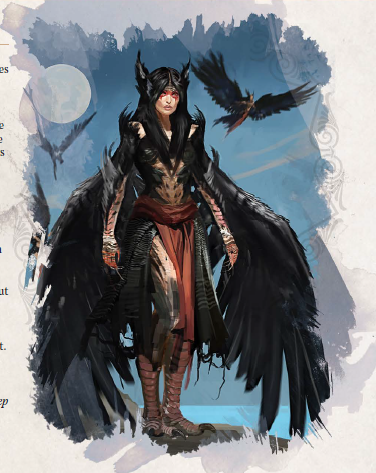
Sirens concept-wise are a cross between harpies (who are cursed transformed monsters in Thylea) and the sirens of Greek mythology. Appearing as winged humanoids with bird-like claws and talons, they live among the islands, ports, and coastlands and are famed for their mournful songs which have magical properties. The sirens once lived in a brilliant city whose name is forgotten to time where they sung praises to Sydon. The cruel god was unmoved, viewing every attempt at supplication as a failure: “were they truly grateful, they would not build their towers to rival mine. Were they truly repentant, they would not sing so brazenly but meekly offer the proper sacrifices in place of songs.” The sirens were saddened that their efforts were for naught, and so they became mute, their city crumbling and fading beneath the waters in a great storm conjured by the cruel god. Lutheria found their suffering to be funny, and kidnapped, tortured, and transformed some of them into wicked beings, bringing the first harpies into the world.
The Titans’ injustice and loss of their city dominates siren culture. As a race they suffer from mood swings between sorrow and joy. Sirens find ample work among the races of Thylea as winged scouts and messengers, although the circumstances of their being means that they can only take flight when joyful.
As a race sirens have +2 Charisma, +1 Dexterity, have advantage on Performance and Persuasion checks with their voice, and can hold their breaths for up to 1 hour. Every short or long rest the player (or DM in case of NPCs) chooses whether the siren is filled with joy or sorrow as a dominant emotion. Happy sirens gain a flight speed of 30 feet provided they’re not wearing medium or heavy armor, but when sad they can sing mournful ballads which can cast charm person at 1st level, enthrall at 3rd level, or hold person at 5th level once each per short rest.
The fly speed alone makes sirens a very powerful racial option. Furthermore, they among the native races have the best-role-playing incentives to take part in the adventure path. Unlike the centaurs, medusa, and minotaurs they have roles in settler society and don’t face must systemic discrimination. I can guarantee you that sirens are going to be one of the more common options among Odyssey players for both role-playing and CharOps reasons.
Class Archetypes & New Spells
Original SA post
Class Archetypes & New Spells
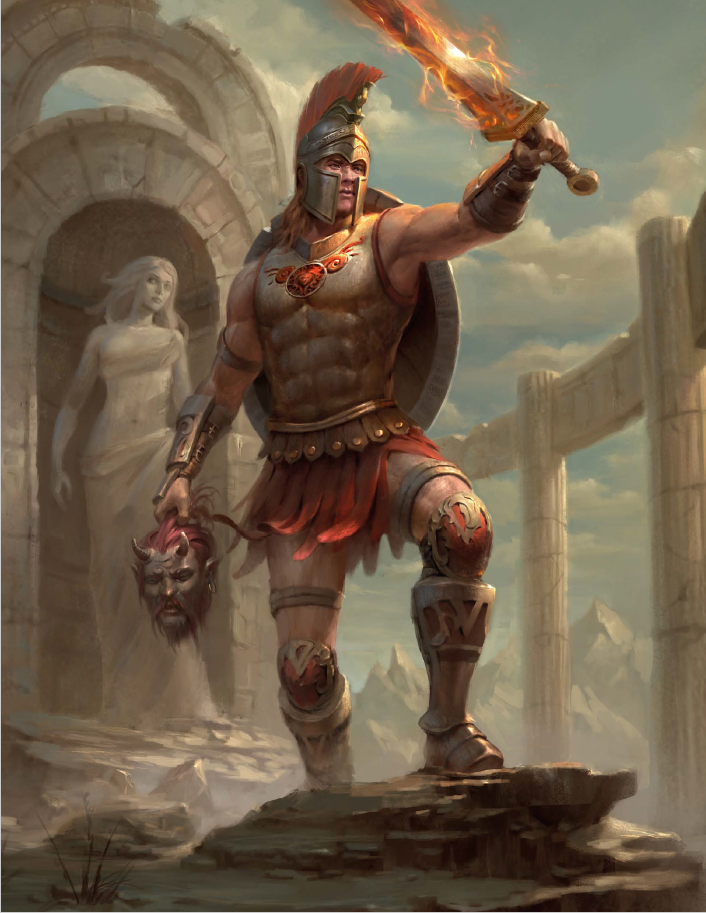
Every core class has one new thematic archetype, and several of them tie the PC into the world at large in a direct manner. The Demigod Origin for Sorcerer makes the PC the child of one of the gods, while a Ranger who’s an Amazon hails from the island of Themis and belongs/belonged to said society of warrior-women.* The Fates are not just a Warlock Patron, they are characters you can meet in the Adventure Path, work for, and yes even kill! Fortunately none of the class features mandate that the game be set in Thylea, so they can be ported into other settings with suitably Greek themes.
*or is the daughter of a warrior who left said island.
Herculean Path (Barbarian) is for those warriors blessed with seemingly impossible strength. Maybe you have distant divine ancestry, are a member of a naturally powerful race, or the source of your power is unknown but you know for sure that you have HUGE MUSCLES. You are proficient with the Athletics skill, can initiate a grapple as a bonus action, grapple creatures up to 2 size categories larger than yourself, and can attack with a two-handed weapon in one hand while grappling. Later class features include the ability to use weapons regardless of size category, substitute Strength for Dexterity for all ranged attack and damage rolls, cast thunderwave (AoE sonic) on projectiles you throw/shoot, gain increase rage damage bonus the longer you rage, and can smash the ground and generate an earthquake AoE that can break concentration spells and knock targets prone.
I like this archetype, more for the Rule of Cool factor than anything. I kind of wish that it allowed one to grapple opponents regardless of size, but Enlarge/Reduce spell on a Medium target will allow the Barbarian to wrestle even the mighty kraken and Kentimane the Hundred-Handed (Gargantuan, largest size). Generating sonic booms, earthquakes, and using Strength for ranged attacks are all pretty nice features too.
College of Epic Poetry (Bard) are those storytellers obsessed with making a Magnum Opus to live on down the generations. They can add Verses to their Epic Poem over the course of a campaign, reciting prior events to grant boons and banes to allies and enemies. Verses are added in one of four ways and reflect a theme (Comedy is when someone rolls a Natural 1, Tragedy is when someone’s reduced to 0 HP, etc). As the bard gains levels the amount of verses improves their Bardic Inspiration, such as granting a minimum result value on the dice, advantage on certain saving throws, +5 to passive Perception, and the like. Other class features include gaining proficiency with medium armor, regaining a Bardic Inspiration die when you compose a verse about an adjacent ally’s action, and can expend a Bardic Inspiration die to be that number of hit points when an ally is reduced to 0 hit points.
The concept is cool, but it has a lot of book-keeping and the GM needs to approve if a verse is appropriate, which turns the archetype into “Mother May I.”
Prophecy Domain (Cleric) allows a priest or priestess to see into the future via divine insight. Holy water, which is boiled and breathed as fumes,* allow the cleric to enter a trance. The domain grants mostly divination spells as bonus spells, proficiency in Perception, and can restore hit points to allied creatures whenever you cast divination spells. Their Channel Divinity is a trance state lasting 10 minutes, allowing them to replace a d20 result made during this time with one of two stored d20 rolls which are rolled immediately when the trance is entered. Higher-level abilities include the ability to take a reaction to move up and cast a beneficial spell on an ally hit by a harmful effect, restore bonus hit points on healing spells you cast equal to your Wisdom modifier, and a capstone perfect foresight where Channel Divinity can choose a result between 1 to 19 as well as seeing invisible objects and environments in darkness.
*this is flavor text, you don’t need holy water to use your class features.
This is a pretty good domain, especially the reaction-casting which is tailor-made to save the party’s bacon.
Circle of Sacrifice (Druid) represents an order known as the Keepers of the Old Ways, druids who channel magic from the Astral Plane into mistletoes and understand that offerings must be made to keep the universe in balance. Initial class features include learning the Produce Flame cantrip and adding one’s Wisdom modifier to the damage. They can also light a target on fire as a bonus action when reducing them to 0 hit points,* gaining the benefits of a Bless spell as the slain target is offered as a sacrifice to the gods. Later class features include the ability to imbue magic into mistletoes, being able to cast a limited amount of minor spells** (cure wounds, detect magic, etc) without using a spell slot by offering the mistletoes in place, sacrificing mistletoes to do your burning sacrifice when allies slay an opponent, and the capstone ability to create a Teleportation Circle within a ring of standing stones.
*for any attack, not just Produce Flame.
**ones of higher magnitude can be cast as you gain levels.
The Druid is a strong class, although the power of the Moon Druid means that other archetypes have trouble standing out as worthy choices. The Circle of Sacrifice grants you more effective spell slots, but the spells it allows are relatively limited in comparison to the utility of transforming into all kinds of dangerous animals and elementals.
Hoplite Soldier (Fighter) are the backbone of Thylea’s armies. Using heavy shields and one-handed weapons they gather into shieldwalls of phalanx formations, holding strong against encroaching enemies. We have a bonus fighting style (Hoplite) that 1st level fighters can choose, allowing them to make an opportunity attack as a reaction against creatures who attack an adjacent ally. The archetype itself grants a 1/long rest Shield Wall ability, giving a net +3 AC to allies standing adjacent to each other while wielding shields. Further class features include upping the damage die and range increments of spears, tridents, and javelins; adding their proficiency bonus to an adjacent ally’s AC as a reaction; can either disarm an enemy shield or do a bonus d6 damage on a critical hit; and the capstone ability where they can spend one of their Attacks to make a single attack roll against all enemy targets within 5 feet. As a Fighter has bonus attacks, you can do this multiple times a round.
This archetype is situational on most party members and allied minions being proficient with shields. While the AC bonuses are nicethe close grouping the style encourages makes characters vulnerable to AoE effects. The pseudo-Whirlwind Attack* as the capstone ability comes too little, too late to make up for the rest of the archetype’s features.
*A 3.5 feat for you young’uns.
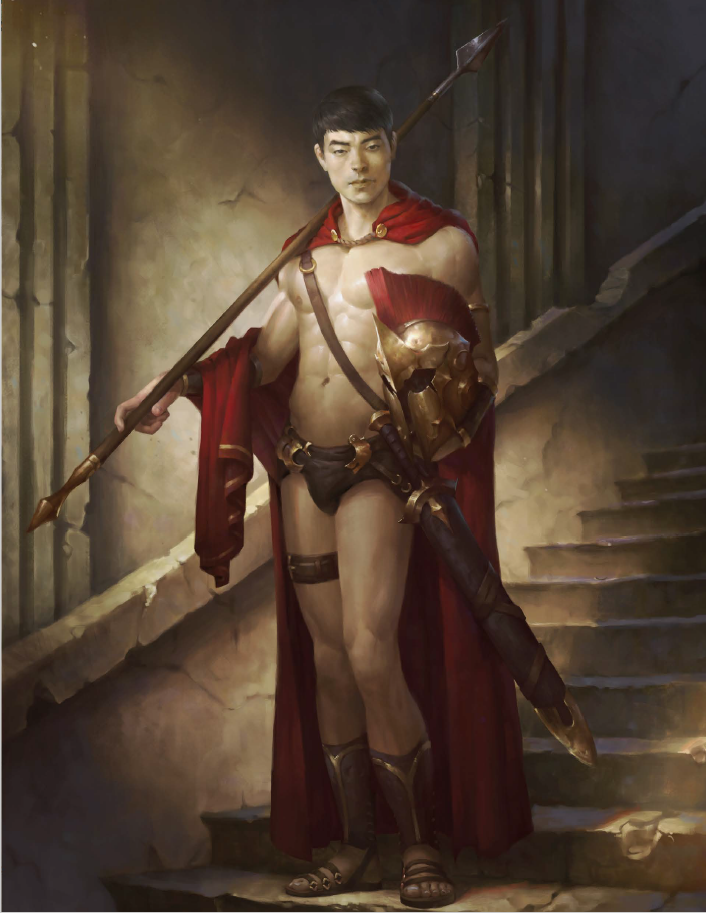
Thylean monks are hotter and sexier than ones found in other campaign settings.
Way of the Shield (Monk) is one of the fighting styles taught by Aresia’s warrior academies.* Your style encourages the use of shields and polearms over armor to serve as your offense and defense, and billowing red cloaks are your unofficial uniform. You initially gain proficiency with shields, they do not interfere with your Monk class features, can ‘catch’ projectiles with a shield instead of a free hand, and opportunity attacks are made with disadvantage against you as long as you have a shield in hand. Further class features include spending a ki point to vault large distances and make an attack with advantage, using a reaction to attack an opponent who misses you with an opportunity attack, spending a ki point to gain +3 AC, and a capstone ability where you have advantage on attack rolls and immunity to frighten and paralysis effects of Huge and Gargantuan creatures.**
*Fun Fact: the various official Monk archetypes (both OGL and Product Identity) are presumed in Thylea to be an Aresian warrior society and have their own academies in said city-state.
**Who in the adventure path become very, very common at this level and higher.
The Way of the Shield is much more offensive than the default monk archetypes in the PHB, and the shield can add some much-needed AC to this unarmored class (even moreso with a Hoplite Fighter). Several of its abilities are prescient upon triggering opportunity attacks, and the capstone ability is highly situational but very useful if you’re playing the adventure path as is.
Oath of the Dragonlord (Paladin) represents a warrior who seeks to find and bond with a dragon. As such creatures were long-extinct since the First War, and the only person trying to reclaim the Dragonlords’ legacy (King Acastus of Mytros) is a Lawful Evil guy, you more or less have to find a dragon egg of your own. The book also says that PCs with either the Gifted One or Vanished One Epic Paths should not take this archetype as the “gain a dragon companion” major features overlap.
Your bonus paladin spells are themed around air and mobility (fly, haste, freedom of movement, etc), and you can gain a pseudodragon familiar tasked with helping you find an appropriate dragon egg (any metallic save gold). Your Channel Divinity options include mimicking a dragon’s frightful presence or knocking prone and disrupting concentration while intoning the Dragonlord’s Oath.* Later class features include your discovered dragon egg hatching, being able to cast the Dragonlord-related spells upon said dragon (detailed in the next section) without material components, said dragon growing from wyrmling to young age category regardless of their true age, and as a capstone ability said dragon gaining multiattack and having their breath weapon recharge normally** as well as being able to reroll a failed saving throw 1/long rest.
*Dragonlord’s Oath to a bonded dragon posted:
I CANNOT POSSESS YOU,
for you belong to yourself.
I CANNOT COMMAND YOU,
for you are a free creature.
WE SHALL SERVE EACH OTHER
in the ways we both require.
WE WILL INCREASE OUR WEALTH
by righteous means.
WE WILL ACHIEVE HAPPINESS
and harmony through knowledge.
WE WILL AID THOSE OF OUR BLOOD
to achieve their great destinies.
WE WILL AVENGE THOSE OF OUR BLOOD
who have been done harm.
I AM BLOOD OF YOUR BLOOD,
and bone of your bone—forever.
Try saying that in six seconds or less (a 5e round)!
**A Dragonlord-bonded dragon loses Multiattack and their breath weapons recharge based on short/long rests.
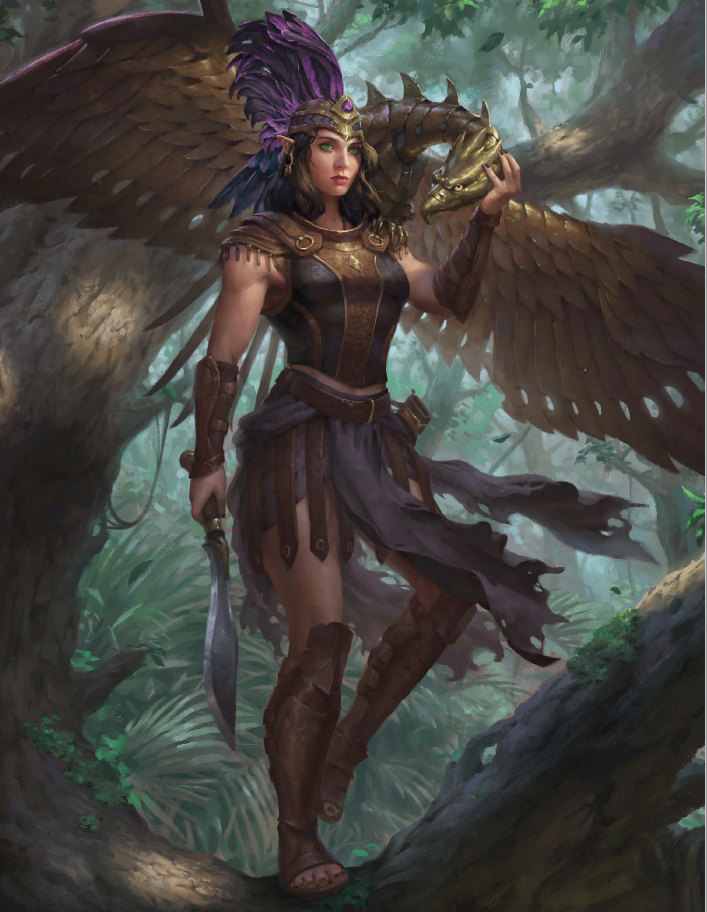
Amazonian Conclave (Ranger) is not just a class; it’s a culture from which your PC hails. The Amazons are a matriarchal society who retreated from Thylea’s mainland during the First War after seeing the violence and poor decisions wrought by men on both sides of the conflict.* Most of their number lives on the island of Themis, although smaller bands made ventures to other islands. Men are allowed to live in their society, but in small, easily controlled, and segregated numbers and generally viewed as unsuitable for warfare, rulership, and ‘important occupations.’
*What I find odd is that the setting as a whole doesn’t mention whether or not Thylea was a patriarchal society or not in the past. While Amazons are an iconic Greek trope, they were spawned out of a misogynistic hellworld which initially was “lol wouldn’t it be funny if women ran things?” to a deconstructed “maybe the Amazons retreated from society due to how badly women were treated” in future tales. The Amazons can still make sense as an isolated cultural holdover, but otherwise Odyssey of the Dragonlords is pretty mum in discussing setting gender roles.
The Amazon archetype grants a mixture of bonus spells ranging from mobility (find steed, haste) to wearing at the opponent’s willpower (command, confusion, mislead). They gain a stimfay as an animal companion, clockwork birds which are built by a resident cyclops artisan who is being held prisoner by the Amazons. Stimfay can scout areas in a 1 mile radius, communicate with its companion via a secret code-tongue only its owner understands, adds your proficiency bonus to attacks/saves/damage/ability save DCs, and can be repaired if destroyed. Unlike the terrible Beastmaster Ranger they act on their own turns!
Amazons also start play being able to do a Battle Cry a number of times per long rest equal to their Wisdom modifier, which grants advantage vs favored enemies and against becoming frightened or paralyzed, as well as resistance against bludgeoning/piercing/slashing damage for 1 minute. Further class features include using a pair of bracers Wonder Woman-style to gain +5 Ac as a reaction to an attack, the ability to ricochet a thrown chakram to targets not in your line of sight and/or within 10 feet of the original target, and a capstone ability where a number of times per short/long rest equal to your Wisdom modifier you can make a special melee attack to hit a target’s pressure point and paralyze them for 1 minute on a failed Constitution save.
We get a sidebar stat block for stimfays: they are tiny constructs capable of fast flight (80 feet), gain advantage on Perception checks based on sight, and can carry a single potion to administer to allies and stabilize dying creatures it touches. Creatures attacked by it cannot make opportunity attacks for 1 round, and they can shoot out pins and scream an ear-splitting cry as 2 kinds of ranged attacks. Not exactly a great offensive fighter, but handy for healing allies and battlefield control.
The Amazon archetype is pretty good, containing a nice mixture of offensive, defensive, and utility features. The bracer-block’s AC bonus is very useful given 5th Edition’s bounded accuracy allowing even weak opponents the chance to hit a plate-covered warrior, while the right selection of favored enemies can make the Battle Cry’s advantage attack feature very useful. The resistance against physical attacks effectively doubles your HP in certain circumstances for a battle’s duration, given most fights rarely last longer than 10 rounds. The pressure points are a multi-use save or die, which is pretty powerful given said condition’s rarity in comparison to 3.5, but at 15th level there’s already a lot of spells and abilities (coughholdpersoncough) that can replicate its effects.
The Odyssean (Rogue) is a cunning mortal who appears at first glance to be an ordinary warrior, but whose cleverness pulls them out of many hairy scenarios. Odysseans, by choice or by circumstance of fate, find their way into legends worthy of quill and song as they survive against all odds. The archetype initially grants shield proficiency and proficiency with spears and tridents as finesse weapons, reflecting training as a seeming common soldier. They can also use a bonus action to formulate a clever plan against one target but only 1/encounter: if the Odyssean succeeds on a Deception vs the creature’s Insight, they and their allies gain advantage on all attacks for 1 round. Further class features include shutting down opportunity attacks from enemies who are aware of the Odyssean but cannot see them, imposing disadvantage on concentration rolls to maintain a spell when damaged, adding Charisma to initiative on top of Dexterity, and can spend a bonus action to regain hit points equal to one’s Rogue level via tenacious survival (limited use per short/long rest equal to Charisma modifier). The capstone ability grants the Odyssean a free ranged attack with advantage against a creature if one of their allies makes an opportunity attack against said target. This ranged attack costs no action, so in ideal circumstances they can sling a flurry of projectiles.
This is a pretty good archetype, although it’s highly reliant upon the actions of your allies to be fully effective. This isn’t really a bad thing given the team-focused nature of D&D, and it’s a superior archetype to the pissant Assassin from the core book. The defaults Thief archetype gives it a run for its money with features at later levels, such as Supreme Sneak and Use Magic Device.
Demigod Origin (Sorcerer) means that you have a deity as a distant ancestor or even close parent! Your heritage makes you naturally strong and beautiful, and you can cast 2 spells associated with your ancestor’s Domain* once per short/long rest without using spell slots. You add double your proficiency bonus on Charisma checks when interacting with gods or celestials, are proficient in Strength saving throws, and you add your Charisma modifier to melee and attack damage rolls. Further class features include spending a sorcery point to increase a spell’s level by 1 (non-stackable), choose to succeed on a failed saving throw 1/long rest, and as a capstone ability can spend as many sorcery points as you have when increasing your spell’s level.
*only 2 such spells are available this way per domain: things such as Entangle and Healing Word for Nature, Charm Person and Hideous Laughter for Trickery, etc.
I like the ideal of a naturally strong sorcerer, but the class’ lack of armor and shield proficiency combined with their low Hit Die means that other options are superior for gish types. Auto-succeeding at a saving throw is nice but comes into play rather late. Unfortunately the lack of spell slots used for domain spells means that ones dependent on the level of said slot such as Cure Wounds (Life domain) are in a grey area of the rules for how effective they are when cast this way. I’d rule they’re as powerful as the highest-level slot the Demi-God has access to, given their limited use.
Patron: the Fates (Warlock) are a coven of wicked hags who can see the destiny of all, provided that they weave a person’s future via a magical loom to bear witness. The warlock PC with them as a patron swore service to them in exchange for power. This archetype grants bonus spells of a diverse assortment* and can cast one divination spell at the end of a short or long rest without expending a spell slot, and gain temporary hit points when doing so. Further features include rolling a d20 and being able to replace a future result for themselves or a creature you can see between the next short or long rest, regain an expended spell slot up to two times per long rest whenever you kill or knock out a creature, and a capstone ability where you can compel a creature to move towards another (bound by fate) on a failed Wisdom save while also dealing them psychic damage.
Interestingly it is possible to kill the three Fates** during the adventure path, but the book does not say one way or another how this affects a Warlock with them as their patron
*mostly divination such as detect evil and good and see invisibility, but also ones like levitate, call lightning, and planar binding.
**and possibly some of the gods, which is similarly quiet as to how this would affect cleric spells.
Academy Philosopher (Wizard) hail from the greatest center of learning in Mytros, adhering to a chosen philosophy as a means of understanding their spells and the nature of reality. A wizard with this archetype chooses from one of 8 philosophical schools which grants an appropriate boon: Cynics halve gold and time requirements for copying new spells and can substitute up to 50 gold pieces worth of material components by foraging through junk, Epicureans can impose disadvantage on creatures that attack them a number of times per rest equal to their Intelligence modifier, Hedonists add double their wizard level to hit points restored when they are healed from a spell or ability once per rest, etc. Further class features allow them to change the dimensions of their spells via mathematical equations, such as making ‘safe pockets’ for targets within an AoE, can change an enemy spellcaster’s target to someone else within range once per rest provided they’re a rules-legitimate target, and the capstone ability allows the wizard to automatically avoid losing concentration on a spell a number of times equal to their Intelligence modifier every long rest.
The philosophical schools are versatile and thematic, although the choices in question vary in usefulness. Cynics’ ability to substitute expensive material components has abusive potential, while the Sophist does something a Bard or Rogue can do better with Expertise: double proficiency and becomes proficient in Persuasion, along with learning the friends cantrip. The Eclectic school grants an underwhelming single bonus language, but at 5th level grants the effects of a second school of your choice as a supposed trade-off. But every new wizard PC starting at that level and later will be taking said school, as the waiting period is no weakness at all!
But beyond the imbalanced schools, the Academy Philosopher is optimal for blasters and battlefield controllers, and the ability to change an enemy’s target without a chance for them to resist is amazingly useful.
New Spells: The section on spells is downright quaint in comparison to the wealth of race and class options preceding it. Animal Polymorph turns a creature into a small, harmless being for concentration duration; Bond of the Dragonlords permanently bonds a newly-hatched metallic dragon to the caster, allowing them to act and move on your initiative in battle and are controlled as if they were a PC. In exchange the dragon gives up multiattack and can only use its breath weapon once per long rest. Dirge of the Dragonlords can resurrect a dead bonded dragon (not just your own) to life at the low low price of a 3rd level spell slot. Fatebinding is cast simultaneously on 2 targets and lasts for an hour if both fail their saves, making them take and restore the same damage if one is affected by an ability. Seeds of Death summons three minotaur skeletons who follow the caster’s orders for concentration duration or 10 minutes, whichever comes first; Sleeping Draught is a higher-magnitude Sleep spell equivalent which merely rolls more dice worth of hit points for creatures to be affected; Sword of
Said benefits are part of an Appendix all its own, but will show down here for ease of use:
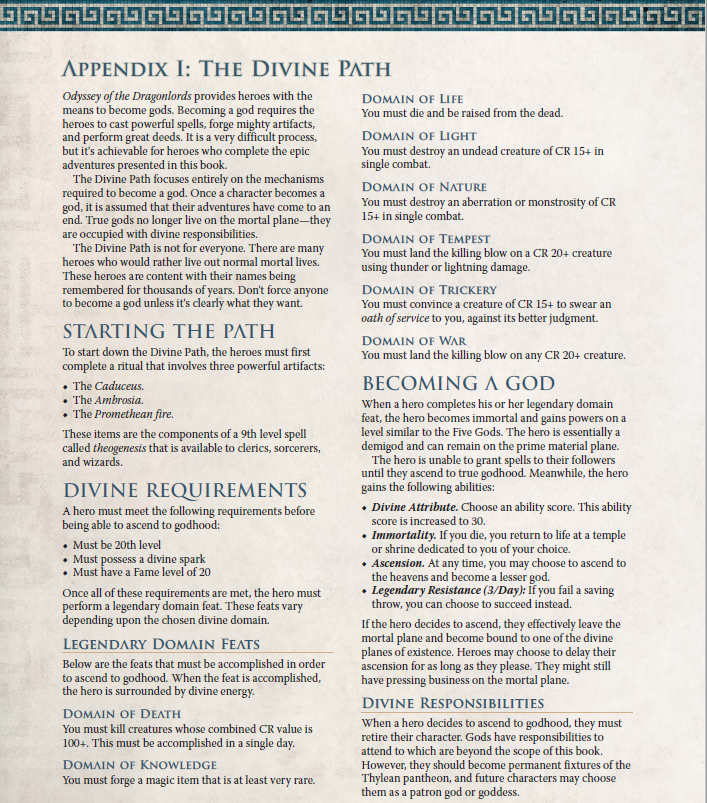
As you can see, it’s a great spell for story purposes, but not the kind of thing you’re actually going to cast during a real campaign. It’s more the kind of thing that happens at the end of an epic tale, and in Odyssey of the Dragonlords this is one of the potential “Ending Sequences” to use video game terminology.
Thoughts So Far: There are many strong and thematic options for players to choose from here. The races, while highly appropriate for the setting, feel a bit samey in places. The satyr and siren both have magical musical abilities, with the siren gaining a better sense of other features and a history for interesting role-play. Centaurs and minotaurs are geared heavily towards martial classes, and the usefulness of the medusa’s abilities increase the more of them there are in the same party. The class archetypes were overall rather good save for a few underwhelming options (Circle of Sacrifice, Hoplite) and I can see players choosing them rather than just sticking with the PHB and Xanathar’s Guide options. The spells, both in brevity and in some of their plot-centric natures, were the weak point of these sections.
Join us next time as we start this adventure path off with a bang in Chapter 1, Heroes of the Prophecy!
Trope Alerts
Original SA post
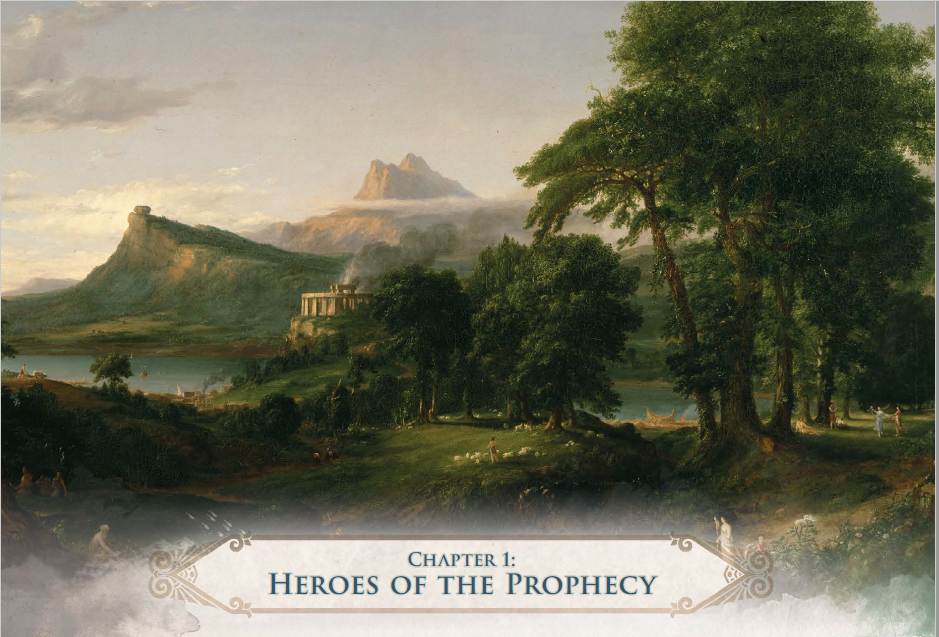
The first chapter of the adventure path is a sort of “tutorial session” in the sense that you have helpful exposition outlining the basic facts of the setting. Additionally, the PCs have some wiggle room in fights should they mess up. It is here and in further chapters we will see some clear influences of Sky and Ohlen’s prior work in the form of
 Trope Alerts.
Trope Alerts.We also get sample quest-based experience awards and milestone points for each Chapter based on what method the DM prefers best:
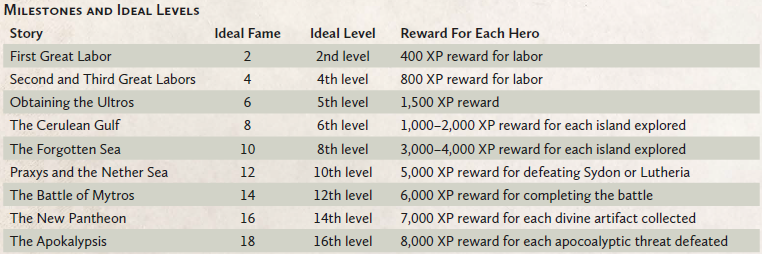
We start our tale with some boxed text telling the players how their heroes have been summoned to the Heartlands as the Oath of Peace nears its end, and how the Oracle fears for the Doom of Thylea. The DM is encouraged to ask the players to write down their PC’s name at the top of three note cards along with rumors about their past deeds. One of them is mostly true, the other two are fabrications or exaggerations but not marked as such. The cards are all given to the DM, who then hands them out to the other players and that’s what their own PCs heard about their traveling companions.
Our first scene literally opens up in a tavern where they meet a bard by the name of Kyrah, who is actually the Goddess of Music in a rather poor disguise. She tells them about how a Titan-corrupted boar is destroying crops and killing villagers and how previous heroes died against it. Should the PCs find and kill it, they can gain fame and power if they offer it to the gods as a sacrifice.
 Trope Alert: Tutorial DMPC: Kyrah tags along as a helpful guide, explaining the basics of Thylean society if necessary while also helping them indirectly in combat via HEROIC SONGS. She’s not the only god who joins the party on the Adventure Path, although due to the Oath of Peace they cannot “assist the PCs in battle” against Sydon, Lutheria, and their allies. However, there are quite a few encounters where the party is fighting monsters and people not loyal to the Titans. This will bring the inevitable question of what happens if the party asks them for aid in such instances. While the book says to not have them overshadow the PCs, her stats are well…
Trope Alert: Tutorial DMPC: Kyrah tags along as a helpful guide, explaining the basics of Thylean society if necessary while also helping them indirectly in combat via HEROIC SONGS. She’s not the only god who joins the party on the Adventure Path, although due to the Oath of Peace they cannot “assist the PCs in battle” against Sydon, Lutheria, and their allies. However, there are quite a few encounters where the party is fighting monsters and people not loyal to the Titans. This will bring the inevitable question of what happens if the party asks them for aid in such instances. While the book says to not have them overshadow the PCs, her stats are well…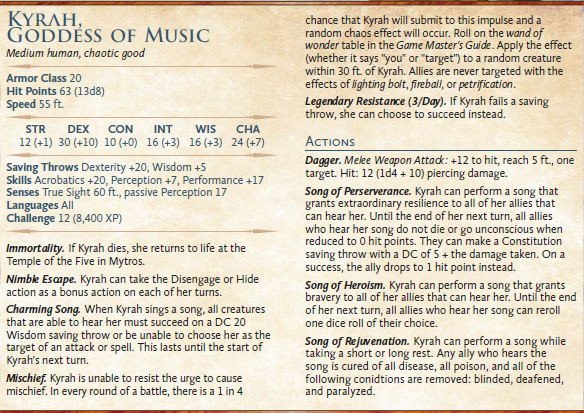
...godly in comparison to the party. You see, every god in Odyssey of the Dragonlords has one or more ability scores at 30 in reflection of their portfolio, and Kyrah can deal damage with a dagger on par with a greatsword-wielding barbarian. Her 63 HP puts her leagues above the rest of the party, and her Songs are quite clearly meant to alleviate the highly-lethal nature of 1st-level gaming. Her lolrandom Mischief ability, even if generally nonlethal, has the chance of causing the party to drive her off in case something like Stinking Cloud or the blinding lights put a PC in greater danger. She will use a Raise Dead scroll on a PC to bring them back to life, which compounded with the fact that said PC will likely have used their Divine Boon can end up making players feel that they’re being bailed out too easily.
The prelude to the boar fight involves hunting and searching for clues, along with being able to set traps for the boar once it’s found. There are some good rules outlines for things like rope snares, camouflaged pits, and the like to help turn the tide in the party’s favor. When the boar is found, it already is quite injured from many weapons sticking out of it and suffers one exhaustion level a round. This means it will die in 6 turns even if the PCs get nary a scratch. Before it breathes its last, the boar speaks of how the end of Thylea is nigh.
At this point Kyrah suggests that the boar’s body be burned as a sacrifice to one of the gods. Deities are jealous beings and as such you can’t dedicate it to more than one or a pantheon as a whole. There’s a table for different gods and goddesses and their boons, and some are more useful than others. For example, Pythor will swear an Oath of Service to the party and Volkan will grant them one random magic item once the party meets them, and whose usefulness is mostly in the broadness of potential options. Kyrah will confess her identity and swear an Oath of Protection...which given she’s traveling with the PCs for a while, is a bit superfluous. Thylea grants immediate aid in the form of a Charm of Vitality* for every PC and animals in every forest will aid the party to the best of their ability from here on out. Kyrah advises against sacrificing to Sydon or Lutheria given that sacrifices increase a god’s divine power, but choosing to do so will involve staying their wrath in a single one of their predetermined future encounters. Choosing not to sacrifice to any of the gods causes hurricanes and earthquakes to sweep over the land, turning the PCs into goats for 24 hours.
*one-use ability to cure all exhaustion, poison, disease, and roll max value when spending Hit Dice to heal.
Temple of the Oracle
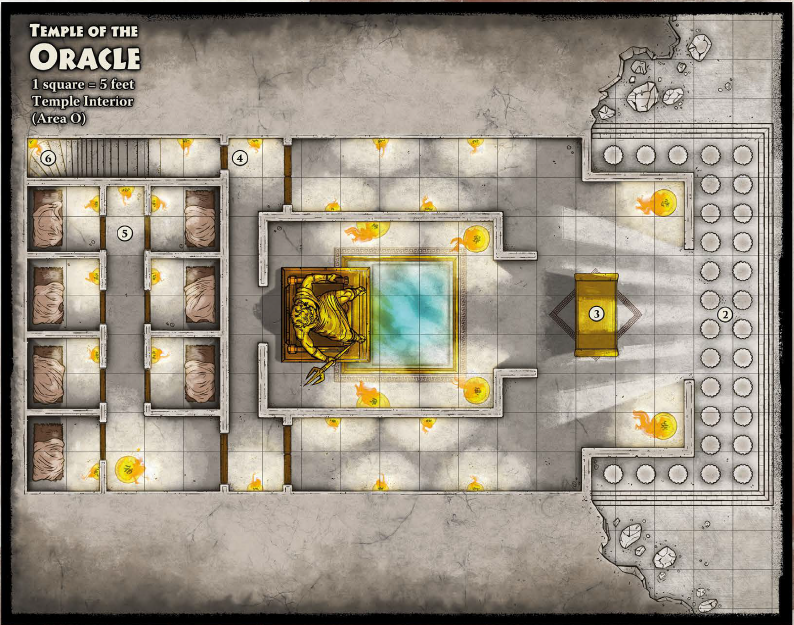
Now that the PCs got a taste of divinely-flavored roast boar, they must make their way to the Oracle’s temple. Although the party’s already received summons, Kyrah will encourage them onward if they seem to dilly-dally. Nobody’s heard from her otherwise in two weeks, so Kyrah fears the worst.
She is right to be worried, for several of Sydon’s minions invaded the temple, slaying and taking hostage most of its inhabitants. As the Oracle is the god’s daughter,* Sydon wants her taken back to the tower of Praxys alive. The PCs are not so lucky, and his forces will try to kill them before they get too famous and powerful.
*This is public knowledge, and she also acted as the arbiter between the gods for the Oath of Peace.
The Oracle’s temple is a relatively short 8-room, 2-level dungeon located above a series of hot spring caverns. Sydon’s forces are led by the sea hag Heleka and include a mix of monsters* and human soldiers. The rooms part of the natural caverns have boiling steam geysers which deal damage to those crossing or pushed into them, while the surviving acolytes can heal the party with their spells if rescued. Heleka herself is mocking Versi in the final room, who is held hostage in what looks like animated tendrils of water (a water weird which will overwise flee once the sea hag is slain).
*Steam mephits, animated flying swords and rugs disguised as furniture, and a mimic disguised as a door with an ‘animated’ face.
Versi will at first grieve for the dead once rescued, but understands the needs of the PCs and speaks to them of their fate: they must sail the seas in order to face the Titans and bring peace to Thylea, but before this they must accomplish three Great Labors to better ready themselves. The legendary Mithral Forge must be brought to working order again so as to build powerful instruments of magic and war. They must also visit the tombs of the Dragonlords in the Necropolis and claim their weapons, and are given a Burnished Dragonlord Coin to pay a toll of safe passage to the guardian of this dread realm. Finally the party must drink from the Horn of Balmytria, a holy silver dragon horn held in an Estoran shrine, to gain an as-yet unknown vision. These three Labors comprise the next chapter, and can more or less be done in any order. But there is a certain point in the plot where a dilemma can be optimally solved should the PCs bring the Mithral Forge to working order early for a specific magic item.
Kyrah will tell the PCs in a rather unsubtle way about the perks of the Fame system (it can potentially make you immortal), suggest that the party swear an Oath of Fellowship* among each other to encourage good teamwork, and challenges the party bard to a ‘poetry battle’ to see who can make the best Homeric epic once their quest is done.
*an Oath not really outlined in the Introduction. It basically allows the party to share all gains from their Fame equally and to not turn against each other.
Epic Paths: Versi can help point the heroes in the right direction for their individual destinies. The Demi-God is encouraged to meet their father Pythor in Estoria. The Vanished One is asked to meet privately with her and to swear an Oath to return to her cave once the prophecy has been fulfilled, and only then will she tell them to retrieve their famous armor and Crown of the Dragonlords from the Tomb of Xander in the Necropolis. Tthe Doomed and Haunted Ones are told about Versi’s evil sister, Demeteria, in the Mossy Temple who either has knowledge of their fate or a lost family artifact respectively. The Gifted One is given a locket containing the soul of their sorceress grandmother who will speak through it, promising that if they take revenge upon Sydon they can restore the order of Dragonlords. The Lost One is promised a way home should they find the Lost Treasure of the Dragonlords, which is truly Lost and not found in the Necropolis. The Dragonslayer is destined to be the scourge of evil dragons and is told to seek out the Forgekeeper of the Mithral Forge. The Cursed One must seek the Necropolis’ guardian to learn about the nature of their curse.
Once the PCs leave the temple, Lutheria shows up in a collective dream, mocking them as she chops up an unknown old man alive. This forces the party to make a DC 20 Wisdom save or gain a short-term mental illness. Unless they dedicated the boar sacrifice to Lutheria, in which case they don’t need to make the save at all.
Thoughts So Far: There are parts of this chapter I like and don’t like. 1st level is way too low-power and gritty for PCs to begin an Adventure Path when they’re supposedly famous Greek heroes. The adventure tries to rectify this with Kyrah’s aid and neutering the boar monster with exhaustion, which kind of takes the wind out of any high-stakes sails. I do like how the Oracle’s various prophecies all tie into the future quests in some way, and the conceptual power of sacrifices is nice inspiration fodder even if the rewards are not exactly balanced. Sadly there are no future encounters in this style where burning the body of a great foe gives further rewards, which is wasted opportunity.
The Oracle’s Temple is just the right length for a starting dungeon crawl, although given that time appears to be of the essence the PCs may be reluctant to take even a short rest after any battles. Although the sea hag is still in the process of searching for a potential route to the sea within the caverns and thus isn’t going to flee with Versi anytime soon, the party does not have a means of knowing this unless they interrogate one of the minions.
Join us next time as we cover the three Great Labors and their adjoining quests!
Starting at Higher Level
Original SA post
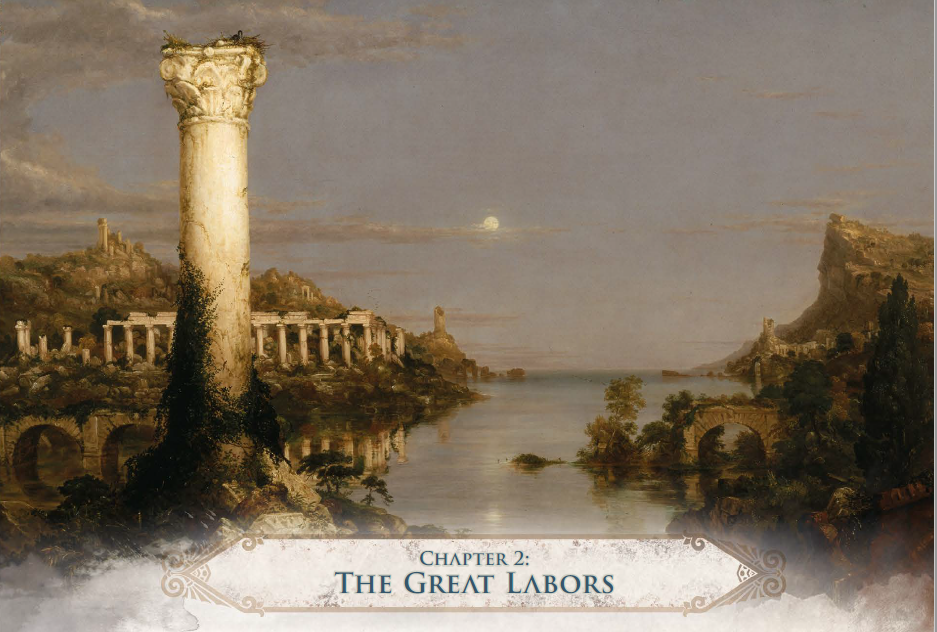
Starting at Higher Level: For those pointing out the incongruity of 1st-level PCs being underpowered for the legends they’re famed for, the book suggests that gaming groups unsatisfied with their “famous heroes” starting out at 1st level can begin at 5th. In this case the DM should skip two of the three Great Labors, with the relevant deeds/treasures/etc already performed and retrieved.
The Great Labors are all in different locations, but conveniently the city of Estoria is within reasonable traveling distance of all three. Chances are the PCs may be headed there to speak with the god Pythor for their Epic Paths anyway.
Estoria is not in a good location by the time the PCs arrive. Sydon is extorting farmers to make daily sacrifices of one cow a day, keeping all of it for himself and not doing the “burn the best parts and let the mortals eat the rest” that is typical for more reasonable gods. Even worse, centaur, gygan, and cyclops forces loyal to him are gathering in large war parties across the river. Sydon promised to pull them away from Estoria should Pythor offer his daughter Anora as a sacrifice on the next night of the full moon, else the assembled armies shall invade. A sacrifice her father is unwilling to make.
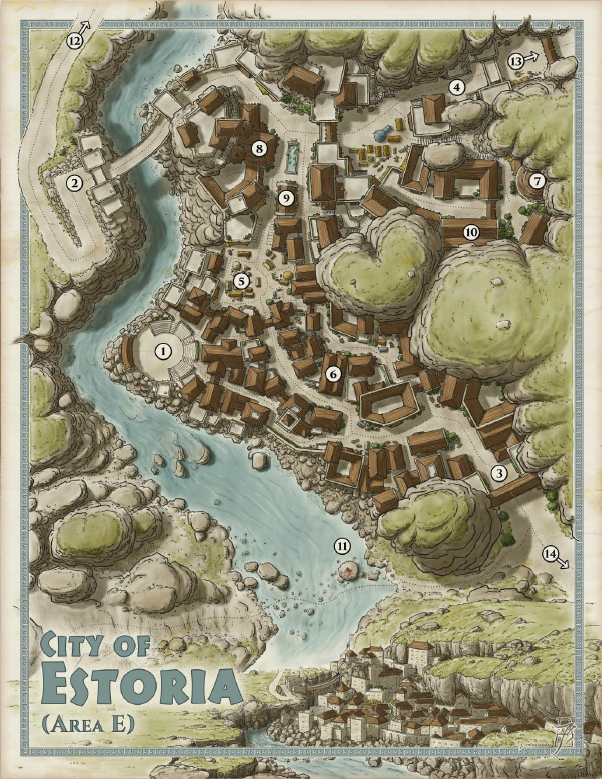
Estoria is a fair-sized city with 14 major sites to explore and 10 potential random encounters: most of the encounters are just set dressing, but a few involve fights or danger such as a bunch of barrels breaking off a cart and heading in the party’s direction.
 Trope Alert: Side Quests: One of Odyssey’s strong points is that while it has a main plot, a lot of encounters and locations are optional or can be found off the beaten path should the PCs go out of their way to explore the cities and islands of the adventure path. As completing said side quests usually nets the party more Experience and material rewards than if they bypassed them, gaming groups of a more completionist mindset will have an advantage in future encounters due to being more powerful.
Trope Alert: Side Quests: One of Odyssey’s strong points is that while it has a main plot, a lot of encounters and locations are optional or can be found off the beaten path should the PCs go out of their way to explore the cities and islands of the adventure path. As completing said side quests usually nets the party more Experience and material rewards than if they bypassed them, gaming groups of a more completionist mindset will have an advantage in future encounters due to being more powerful.So what sidequests do we have in Estoria? Well there’s…
...a Wine Festival where the party can watch mythological and historical plays expanding on Thylea’s world-building. One of the actress is a disguised green hag who will try to seduce a PC to meet her alone so she can eat their heart.
...a grave robber who stole a Necklace of Fireballs from the Necropolis and is starving to death due to the curse for his sin. The only way for him to end the curse is to sell the necklace to someone who knows that he stole it from a grave. It will teleport back into his possession otherwise.
...meet some dwarves in the Dragon’s Tooth, a local tavern. They will pay the PCs 10 gp for each dwarven skull retrieved from the Mithral Mines. The skulls are needed to bury their kin, and their race once operated the Mithral Forge. This one’s a subtrope all its own!
...meet a man and his husband in the local vineyards, whose daughter Corinna went missing. She is encountered at the Mossy Temple, one of the many teenagers who joined Demetria’s cult of Lutheria. Returning her safely home nets the PCs a Javelin of Lightning from the grateful fathers.
...convince a simple-minded yet good-intentioned cyclops that a group of poachers he’s running with are bad news, as they’re only his ‘friends’ due to the muscle he provides and nothing else.
The PCs can also visit the local tavern where they can roll on a d8 table to learn of plot-relevant rumors, several of which hint at future chapters or interesting locations in town: the local dwarf artisan Volkan claims to be the God of the Forge, a massive hurricane is approaching Mytros’ coast, etc. PCs who visit the Dragon Shrine to drink from the Horn of Balmytria will learn that some thieves broke in and stole it. Following the trail whether by Survival or Detect Magic (cuz powerful artifact) leads the PCs to the Mossy Temple deep in the Oldwoods. Finally, Volkan’s Hall is home to the God of the Forge, but most of the locals think him to be merely an eccentric dwarf. He’ll give the PCs a magic item if they sacrificed the boar to him, and even if they did not he promises to help them craft magic items if they get the Mithral Forge working again.
The King’s Daughter
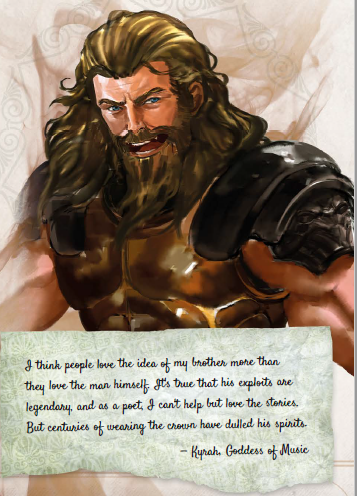
But before the PCs can go gallivanting around town, the city guards at the gates will mention that King Pythor is aware of their presence and issued a summons for them. They won’t force them there, but will encourage the party to make haste given that their ruler would not issue this order on a whim.
Pythor’s an alcoholic even on his better days, but given the recent troubles his worse side is out as he’s found smashing statues in the main hall. He’ll gain enough lucidity once Kyrah talks some sense into him, and he explains the above troubles regarding Sydon. Although Pythor has dozens (if not hundreds) of children, Princess Anora is very dear to him. The sacrifice in question demanded by Sydon involves tying the captive to the aptly-named Rock of Sacrifice on the river where they must remain until sunrise. It is known that a pair of basilisks will petrify and consume any offerings left there, so even though the wording does not demand death it will be almost certain. Caught between sacrificing one of his own vs the people of the city, he cannot directly fight Sydon’s forces without violating the Oath of Peace, so he begs the PCs to find a solution. The next full moon is a few weeks away, so the PCs have a generous window open to act and also do any Great Labors and various sidequests to Git Gud to fight the basilisks/centaur chieftain/etc.
How does Anora feel about this? She’s willing to sacrifice herself, but Pythor will not allow it and locked her away in the palace dungeons to prevent her from sneaking out.
One might be asking how Sydon’s forces can raze a city without breaking the Oath of Peace. Well, that’s a good question. In fact, any in-game text of the Oath proper is never revealed, although it’s heavily implied that not attacking Thylea’s major population centers is one of the terms with which the Titans must abide based on later events in the book. Which makes one ask why Estoria’s the exception. While we know that the gods’ devotees can fight each other without breaking the Oath (otherwise this AP would be impossible), the vagueness of the Oath is something the PCs will be asking about in times like this.
The PCs could challenge the centaur chieftain in ritual combat, where he and a number of his best soldiers will face the PCs in equal numbers plus one cyclops. This will be a very difficult battle given these are Centaur Heroes with better stats than the base Monster Manual kind, and Kyrah will advise against this. She will resurrect the PCs in one week’s time at Pythor’s palace rather than wasting their Divine Boons should they lose. The other option is to approach the representatives of the Order of Sydon, led by Commander Gaius who is a bit of a recurring villain in this campaign. Pythor’s offer of fifty oxen to replace Anora will be turned down, for Gaius is a Lawful Evil jerk who wants the Five Gods to suffer. He’ll only accept the PCs as an entire party as a worthy sacrificial substitute.
The PCs can look for the basilisk’s lair and kill them ahead of time, although this will result in an unforeseen yet still manageable complication. Sacrifices, be they the PCs or Anora, will be led to the Rock of Sacrifice and chained by their feet (but still retain their equipment). A dozen centaur will watch the proceedings, as well as three harpies who will use their songs to lure any escapees back to the rock. The chains limit their movement, and the basilisks will attack after twenty minutes...but if the basilisks are dead, then hours will pass and Sydon’s followers will grow increasingly worried and impatient. The harpies will be the first to break down, where they will attack the sacrifice(s) but will not be joined by their landbound comrades should the PCs retaliate. As the terms of the sacrifice do not mandate death (only a certain time limit), the centaur chieftain will grudgingly disband his army should it go awry.
Completing the quest where Anora survives will make Pythor very happy. He will give one of the PCs (ideally the Demi-God) his famous hammer, which in addition to being a great weapon can be used to craft special kinds of weapons at the Mithral Forge. If Anora dies, Pythor will drink himself into unconsciousness and be invalid for a week.
Epic Paths: Pythor has relevant information regarding the destinies of the Demi-God and Lost One, but won’t aid them until they resolve the sacrifice quest. He’ll tell the Demi-God that their mother was kidnapped by the dragon Hexia who is believed to lair in the Forgotten Sea. Volkan will give said PC the blueprints for one of Pythor’s unfinished weapons, which is one of the magic weapons for this Path and must be crafted with his hammer at the Mithral Forge.
For the Lost One, he’ll mention that Estor Arkelander, one of the Dragonlords, knows where the lost treasure of the order is, but he is now an undead captain of a ghost ship which hasn’t been seen in generations.
The Mithral Mines
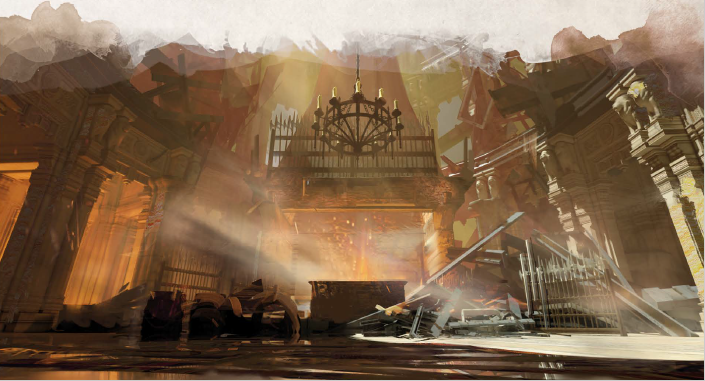
The Mithral Forge is interesting in that it’s one of the few aspects of Thylea which directly ties the PHB races to the world’s history. The dwarven settlers found a rich mithral vein with some adamantine extending for miles beneath the mountains; the largest in the world in fact. Most of Thylea’s greatest arms and armor were crafted here, and it was this vaunted fame that made Lutheria unleash a Cerberus hound in the mines to slaughter the dwarves. The infernal beast gave birth to many children known as death dogs, meaning that nobody has yet returned it to operating order.
As can be expected, the Mithral Mines are a classic subterranean dungeon crawl. The PCs can see four massive statues in the shape of hands which are actually one of Kentimane’s many limbs, a bit of foreshadowing to the Titan’s omnipresent nature across Thylea. They can also come upon some wary centaurs who if not attacked will warn the party of a troglodyte band in the mines who kidnapped their companions. Said companions are a Side Quest where the tribe will award the PCs 3 potions of heroism for rescuing them.
The Mithral Mines are a 2-level, 22-room dungeon. Troglodytes from the Underdark sought the mines’ upper reaches as a safe haven from an undefined threat further below the world’s reaches, but ended up involved in a devastating war with the Cerberus’ death dog children. A battle which the troglodytes gained the upper hand in once they bred some cockatrices to petrify the hounds...and in turn the cockatrices started attacking their caretakers, and are thus a third pseudo-faction in the dungeon. The mines have some creepy ambience of multi-headed doglike statues, a few of which come to life shortly after the PCs enter or go on to the next room.
PCs who fall in battle against the troglodytes will not be killed, but imprisoned (granting them a Short Rest) and brought to their king. Said king wears a Headband of Intellect which has made him rather miserable upon realization that he lives among idiots. He will be initially nonviolent to the PCs and offer a game of riddles, and should they win or prove otherwise useful to him he’ll tell them the password to bypass the elevator trap leading to the lower levels.
The way to the second level is an intricate dwarven elevator with a trap. Unless the right password is uttered, dragonhead spouts will pour oil into the elevator while flaming jetstreams farther below come to life. The PCs have 3 rounds to somehow prepare or avoid this before the entire elevator is lit on fire. The damage alone from this trap can result in a TPK. The second level itself is hotter, home to a Salamander kept imprisoned by a cold-generating bronze sphere that douses her with freezing ice should she go a certain distance away from the room’s center. She was a metalsmith who helped maintain the Forge, but can tell the PCs how to restart and upkeep it should they find and give her the contract binding her (also in the dungeon). She will stay in the Forge for one year voluntarily, helping craft items.
But nothing in life is so straightforward. If the trogloydyte king is still alive, he’ll hear the loud sounds of the forge coming to life and lead a war party of 16 of his subjects down the elevator to kill the PCs, the salamander, and any surviving death dogs in order to claim the Forge for himself. The PCs have several rounds to prepare, and can also set up 4 traps in squares of their choice in the forge room to activate when someone enters. Said traps are overhanging cauldrons spilling molten metal, blast vents that shoot out boiling steam, etc.
Although the PCs have traps and a fiery monster to aid them, the potential 17-monster combat is highly lethal to PCs who are likely 2nd to 4th level. But I do like how it’s suitably climactic for the end of a dungeon, and cutting back the troglodyte numbers may be best.
Epic Paths: The Forgekeeper will give the Dragonslayer one of their wish list magic items, and explain that the gygans of Yonder Island once knew the secrets to building an even greater weapon suitable for fighting dragons.
The Mossy Temple

This one’s another dungeon crawl, this time of the decaying vine-covered ruins kind. A group of goatlings stole the Horn of Balmytria so as to prevent the PCs from opposing the Titans’ plans, although they did not do a good job in covering their tracks. Said goatlings are part of a cult of Lutheria, led by the evil dryad Demetria. The cult has been tricking teenagers into thinking they’re joining a cool secret society but in actuality will become either maenads (for the women) or sacrifices (for the men).
Goatlings and Maenads: With the absence of orcs, goblins, and kobolds, other monsters serve similar thematic roles in Odyssey of the Dragonlords. Centaur and Gygans more or less replace orcs and ogres as the “strong warrior race of raiders” trope. Maenads and goatlings are two new monsters in Thylea. Maenads are evil monstrous women transformed after a loved one tricks or betrays them as part of a ritual to Lutheria. Maenads are more or less always Evil and live to kill: the union of a maenad and satyr produces a goatling, who are Small-sized monsters with goat heads who are fond of taunting people in combat.
The Mossy Temple is slightly shorter than the Mithral Mines, being 16 rooms. The PCs also have more opportunities to encounter potential allies, such as an insane gnome who remains wildshaped in squirrel form whenever possible. There’s also a non-evil pair of satyrs* and a dryad who are ambassadors for the non-evil fey unsuccessfully trying to convince Demetria to stop kidnapping and torturing people. Two of them cannot provide direct aid in combat, but can tell them a bit of the dryad’s backstory: the Dragonlord Estor Arkelander cut down her sister’s tree to help build his ship, which is why she’s now evil. Finally there Corinna, one of the teenage revelers who can talk sense into her friends.
*One of the satyrs, Loreus, is not like others of his kind: he prefers the fanciful fiction of stories and poetry, and happens to be big fans of the PCs thanks to their exploits. He’ll fall in love with the party member who is the nicest to them, and if possible will covertly follow them and use his pan pipes to put to sleep a foe who begins to get the upper hand in combat.
The Temple’s dangers are nicely varied, ranging from animated root traps, camouflaged oozes in a stagnant pool, nonflying gargoyle statues that come to life if an offering is not left in a sacrificial bowl, and violently drunk goatling and maenads. The treasure has some non-standard options: two gardens can be harvested for non-magical Goodberries, truth serum, and poison to those with the proper proficiencies
Demetria and her gygan bodyguard are in one of the temple’s last rooms, hosting a feast for four girls. She is wary of the PCs but will try to engage them in conversation to buy herself some time. In reality the meat of the meal is the flesh of several murdered teenage boys, and she told the four girls that they’re away in the forest to explain their absence. The PCs can convince the girls of the truth if they visited the kitchen and found out what the meat was made of, if the crazy gnome is still with the PCsand will point this out, or if Corinna is with them and trusts the party. Otherwise, the girls will transform into maenads as they dig in, and will attack the PCs along with Demetria and the gygan. If the party convinces the girls of the truth, they’ll automatically pin down Demetria for 3 rounds but will die if the PCs don’t protect them from the gygan.
Also, some of the squickier elements of this chapter: the troglodytes and goatlings have babies among their number who can walk upright, the former case will attack the PCs and which the text explains as a ‘moral dilemma.’ Child-killing is a recurring plot element in this adventure path, albeit in most other cases is a thing done by villains rather than the heroes. Demetria has also been having sex with the teenagers offscreen. Although their ages are never stated, it’s still a creepy and predatory behavior given her intentions and the power differentials even if they all happen to be 18-19 years old.
Once the Horn of Balmytria is recovered and drunk from, the PCs will enter a collective trance where they imagine themselves upon the deck of a trireme ship rowed by undead oarsmen, a strange bronze construct in their hands. PCs skilled in the ways of visions or a suitable NPC can interpret their dream as being on the deck of the Ultros, an infamous ghost ship once commanded by the Dragonlord Estor Arkelander. Only one of his descendants would know the location of the ship: King Acatus, ruler of the city-state of Mytros. Acastus’ ancestral legacy is common knowledge in the setting, so it should be trivial for the PCs to find out about this.
Epic Paths: Demetria recognizes the Doomed One on sight, will tell them that they are destined to die at the grace of Lutheria, and say that only the Fates can say more. If the PCs happen to be the “kill first, ask questions later” this information will be revealed to them once they drink from the Horn.
She also possesses one of the Haunted One’s wish list magical items. Once attuned, they will hear the voice of a family member’s soul, explaining that the other family artifact is in the hands of the Amazon Queen.
The Necropolis at Telamok
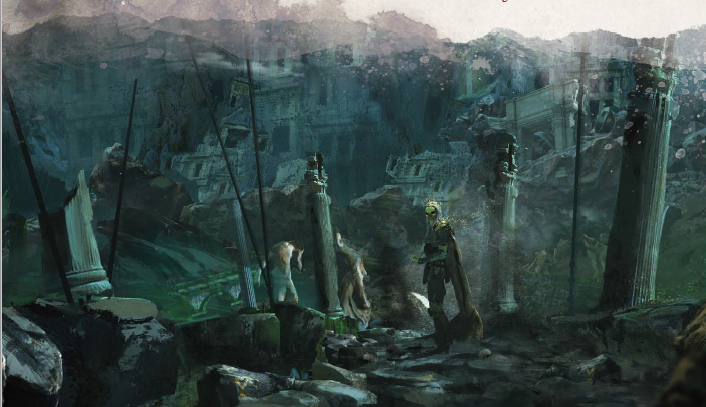
Cave Dungeon? Check. Ruins Dungeon? Check. Graveyard Dungeon? Checkaroony! Rounding out our Great Labors is a place where the party Cleric can go Turn-happy. But unlike the typical graveyard, the Necropolis is located outside any major population center and is forbidden to all but a select few. It is where the Dragonlords’ bodies were laid to rest, presided over by Damon the lich undertaker. This undead archmage is on the lookout for grave-robbers, necromancers, and general-purpose defilers. The PCs will pass more of Kentimane’s arms on the way here and also get accosted by harpies who will try to use their songs to make them fall off the cliffs. The Necropolis itself is a mist-shrouded valley where undead will be endlessly summoned should the PCs try to climb or fly past its edges.
Several bridges (all but one of which are broken) are guarded over by Damon, who will let the PCs pass if they present him the Burnished Dragonlord Coin Kyrah gave to them way back during the boar hunt. He will use nonlethal magic to those who try and pass otherwise at first, becoming lethal should they persist or fight him.
Epic Path: Damon otherwise says nothing, but to the Cursed One he will give a Gem of Brightness, one of their family heirlooms. He will tell them to seek out the Lotus Witch of Scorpion Island, for she knows how to break their family curse.
A generous amount of page space is given over to the tombs of various Dragonlords, which are much greater risk than reward: although a few have some nice magic items, they’re guarded by some nasty traps. Even if the PCs successfully abscond with the goods they’ll be afflicted with the Curse of the Graverobber which will slowly starve them to death. Kyrah is uncharacteristically quiet in the tomb of Estor Arkelander; she has some bad history with the Dragonlord, and regrets the atrocities he committed during the First War but will not wish to speak of it to the PCs. One of the Dragonlord tombs houses one of their number who converted to Sydon as a symbolic gesture of peace: trying to rob it will teleport one of the offending PCs to Sydon’s throne room in Praxys, where he will most assuredly kill the offender.
But there is one tomb they can purloin without (much) negative consequence: the Tomb of Xander, which houses the treasure needed for this Great Labor! It’s a mazelike dungeon patrolled by the insane minotaur Graxis the Butcher, whose tribe were cursed to be the Necropolis’ guardians at the end of the First War. His brethren became skeletons which are one of the more common monsters encountered here, but he managed to not become undead through SHEER WILLPOWER. Graxis can be encountered either at the end of the dungeon or as a random encounter, and the maze has a few traps, such as the classic “spiked walls closing in” that can be disabled via pulling a lever or opening a portcullis.
If Graxis is still alive, he will confront the PCs in the true tomb, getting there via Plotportation. During the battle the resting Dragonlord will raise as a wight and hand one of the PCs his Axe but otherwise not intervene in combat. Once victorious, the PCs can claim the magical breastplate and mundane (but very pretty) shield from the tomb. The Axe and Shield are damaged and thus must be repaired at the Mithral Forge.
Epic Path: Xander will mention that Commander Gaius, the leader of the Order of Sydon, has stolen the Vanished One’s armor and keeps it safe in a fortress at the Isle of Yonder. Xander also has a Crown of the Dragonlords to give to said PC (or the Gifted One) in addition to the existing treasure. If the party includes both the Vanished One and Gifted One, he has TWO CROWNS instead!
Inter-Labor Encounters: The world at large is not docile while the PCs are going out and about. After the first Great Labor is completed, Commander Gaius will track down the party and make a dramatic entrance on his silver dragon mount, gloating at how their quest is a lost cause and call forth a centaur warband to attack the party as he flies off.* After the second Great Labor is completed, Lutheria will give them another spooky dream the next time they rest, where they see a man with stitched-shut eyes, ears, and mouth in a beautiful valley. They must make a Wisdom saving throw or gain a long-term madness that can only be magically healed.
*I do feel that if the party has the Vanished One and the Necropolis was the first Great Labor completed, then they may misread this encounter and try to chase after Gaius even though he’s meant to be a foreshadowing of things to come.
Also after the Second or Third Labor (DM’s discretion) is completed, a trio of Mytrosian soldiers mounted on copper dragons will find the PCs and explain that they bear summons from King Acastus: Sydon has sent a hurricane to the city, and they need the PCs to come to their aid. They will plead for the heroes to come but otherwise not force them, mentioning that Acastus will punish them if they come back empty-handed. Said soldiers are part of Acastus’ attempt at restoring the order of Dragonlords, who are not looked fondly upon by Kyrah and the gods due to being a poor imitation at best.
The relevant quests and city of Mytros is covered in the next chapter all on its own. So yes, the chapters in these cases can be played out of order potentially, which I like for providing a relative sense of freedom.
Thoughts So Far: Overall I like the three Great Labors. Their main weaknesses is that they are quite lethal for such a low-level party, particularly the troglodytes and some of the room traps whose damage can easily lead to a TPK. But I do like how they are tied into aspects of Thylea’s history and grant the PCs several chances to learn of what came before. The addition of sidequests is a neat concept, but the ones here feel a bit simple (retrieve dwarven skulls, rescue these NPCs, etc) in comparison to ones we see later in the adventure path.
The demanded sacrifice of Pythor’s daughter is a bit of a low point, if only due to the fact that it has a rather restrictive expected outcome in that the text presumes the PCs will offer themselves up as sacrifices. It also highlights some of the plot holes in this adventure path regarding the Oath of Peace’s vagueness. Additionally, Pythor feels more like a Thor expy than an Ares: his red hair, the image of a drunken bon vivant, and using a signature hammer as a weapon feels more Norse mythology than Greek mythology.
Join us next time as we visit the Big Olive in Chapter 3: Summoned by the King!
The foundations of Mytros
Original SA post
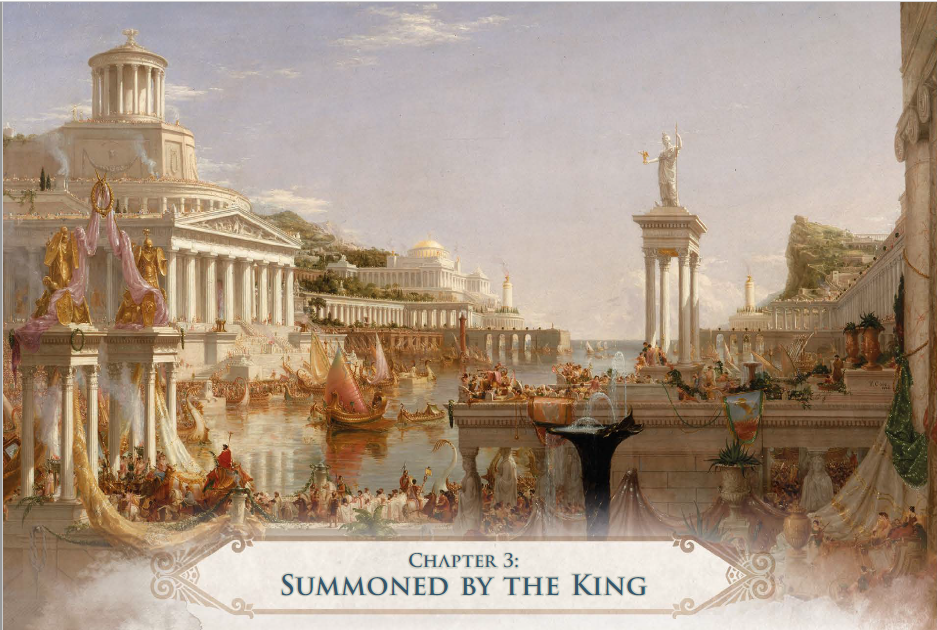
The foundations of Mytros would be beautiful, were it not for the howling winds and storm clouds hovering over it. Peering out from the hurricane is the face of Sydon, who will dramatically lock eyes with the PCs and throw down a lightning bolt spell at the slowest-moving hero before disappearing back into the clouds. Most citizens are shuttered in their homes, so establishments, side quests, etc are locked off from the party until they find a means to assuage Sydon’s wrath.
After the PCs are railroaded to the palace, they meet King Acastus and his royal court. Already things are amiss; although he’s married to Vallus the Goddess of Wisdom, he’s not eager to listen to her, and Commander Gaius is one of his advisors along with Chondrus, a tiefling priest of Lutheria. His court cannot agree on anything, each with their own ideas on how to dispel the storm. So Vallus declares that the PCs should be the tiebreaker.
The PCs have four (technically six) choices. King Acastus suggests that the PCs, mighty as they are, should be able to dispel the storm with magic and will express his disappointment if they cannot. Unfortunately nothing less than an 8th-level weather-based spell can work. But it is possible to do this; the Mithral Forge is capable of forging a Boreal Harp which can cast Control Weather as one of its spells, but as time is of the essence Acastus won’t wait around for the 4 days necessary to craft it (Mytros will be demolished by then). A Boreal Harp can be found as a reward in a random encounter, and also gained as the reward for a sidequest in the city. But given that said sidequests are locked off until the storm’s dealt with and the harp is not one-use, this feels like the writers retconned things at some point.
Gaius will declare that demolishing the Temple of the Five will appease Sydon. Destroying the temple will cause the Five Gods (save Mytros) to suffer a permanent level of exhaustion, not to mention cause a huge loss in faith and public support for said gods due to this weakness. Bella, the king’s concubine, suggests that a hecatomb, or sacrificing 100 oxen, will work. It will, but the city’s economy cannot support this unless the PCs forward 10,000 gp to pay for the farmers’ losses.
So I did the math of previous treasure in this AP, and discounting random die rolls on the DMG treasure table for monsters which would have to be very lucky to get that high, there’s nowhere near enough loot for this. As 5th Edition does not list prices for magic items save for crafting them, the best we have is a suggestion in the Xanathar’s Guide that adamantine versions of weapons and armor are worth 500 gp more than their base counterparts. There’s quite a bit of pre-forged mithral and adamantine weapons in the mines, but even if we assumed each were worth 500 GP each that’d only spot 65% of the required price.
Queen Vallus, if asked for her idea, will suggest gathering the other gods to the court where the PCs must convince them to surrender a portion of their collective divine powers in order to perform a miracle. This is the same result as destroying the Temple in terms in causing permanent exhaustion, but will bolster public support rather than erode it and requires succeeding on a single reasonable DC 16 Persuasion check.
The last choice is not really a choice at all. Chondrus suggests that Lutheria can intervene to talk some sense into Sydon, but only if the king demands seventy children of the city take up the black robes and be inducted into the Cult of Lutheria. Although Chondrus claims they’ll be treated well, everyone else knows that the goddess shouldn’t be let within 300 feet of a school and those present will vehemently argue against this, Gaius included. Vallus will threaten to kill Chondrus before she’ll allow this to happen, Oath of Peace or no.
If you’re wondering if sacrificing the boar to Sydon would work, it would...if an in-game week has not passed since said event. The boon of said sacrifice only keeps the skies clear and beautiful for that long; any more and the Lord of Storms is no longer beholden to making things easy for the PCs.
Regardless of how the PCs resolve the crisis, Sydon upholds his Lawful end of the Lawful Evil bargain and the skies clear up immediately. King Acastus will give the party a scroll containing the map to the Ultros as a reward, and encourage them to leave the city with haste. In reality the king is an incredibly arrogant man, fearful that the PCs’ exploits will overshadow his own. He also made a bargain with Lutheria to give him some metallic dragon eggs and some aging potions to rapidly grow said dragons in an attempt to restore the order of Dragonlords. This too is a secret he fears the PCs may also find out in time. The party can also meet Queen Vallus in the palace, who will vaguely warn them that her husband’s intentions are less than altruistic. Should the PCs try to meet with Icarus, Acastus’ silver dragon mount, they’ll find him to be huge and mighty but with the mind and maturity of someone just approaching adolescence.
The City of Mytros
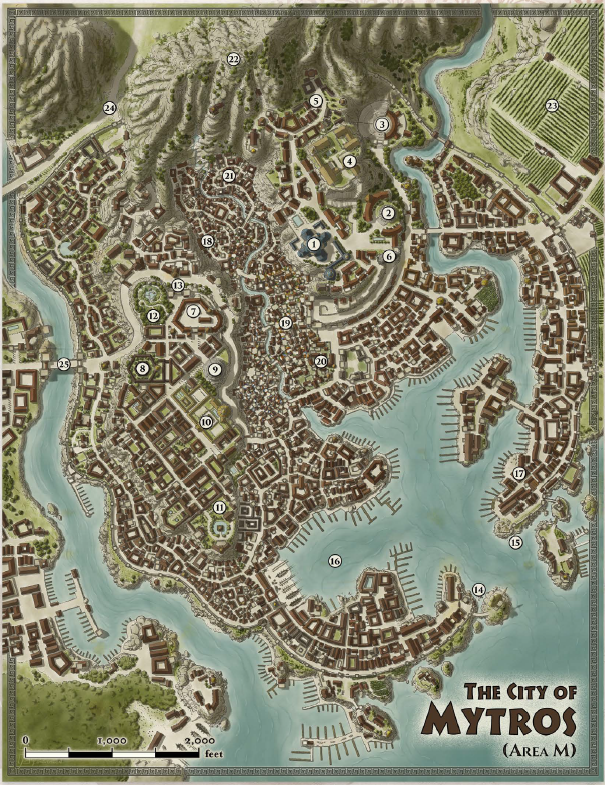
The oldest, largest, and most iconic city of Thylea, the history of Mytros is the history of the Five Gods and the Dragonlords. It is a city with clean streets, hillside burgs commanding great views of the surrounding land, and free healthcare where temple acolytes hand out healing magic to needy citizens as part of their duties. Even though one of its Colossi was destroyed in battle with the Kraken, the remaining Colossus of Pythor stands eternally vigilant over the harbor. Its major blight is Stygian Row, a crime-ridden slum where tieflings are ghettoized, and a thriving slave trade in minotaurs which is encouraged by the Order of Sydon. Queen Vallus hates this, but finds her attempts at abolition thwarted by her husband and various economic interests among the upper class.
 Trope Alert: Main City of Sidequest Attractions: A huge portion of this chapter details the various major locations and optional subplots of the city. We have quite a few minor sidequests, but two are large enough to merit their own entries.
Trope Alert: Main City of Sidequest Attractions: A huge portion of this chapter details the various major locations and optional subplots of the city. We have quite a few minor sidequests, but two are large enough to merit their own entries.While in Mytros, the PCs can…
...culturally oppress some Sydon worshipers who maintain the right to sacrifice a minotaur slave. Said minotaur slave is Bullbug, a pseudo-DMPC party member the PCs can recruit for their eventual voyage during the seafaring portion of the campaign. He’s a jovial sort with a self-deprecating sense of humor.
...offer some centurion investigators or a merchant trafficking in minotaur slaves help in bringing the Lady of Coins to justice. Said Lady of Coins runs the Cult of the Snake, a thieves’ guild whose side hobby is disrupting Mytros’ peculiar institution.
...fuck up said slaver by robbing his estate with sample stats and DCs for guards and locked doors and treasure chests.
...get into a bar brawl in the roughest tavern while investigating the Lady of Coins.
...get petitioned by either Queen Vallus or a sex worker to look into the local Cult of Lutheria by gathering evidence against their misdeeds. Freeing the kidnapped children from their temple basement will do much to delegitimize them in the eyes of the public.
...meet the brother-sister/husband-wife high priests of said cult, who will seek to buy the Horn of Balmytria off of the PCs. Otherwise they will try to ambush and kill them if they refuse. But before that, they may hire the party to take care of some satyrs and bandits who stole their wine shipment. Said satyr will make a counter-offer to the PCs to kill the cultists, and give them the Harp but smash it before giving it to them. He is kind of a dick even if he hates the Cult.
...meet a homeless philosopher in the public gardens, who can give oddly-useful advice in the form of a divination spell should the PCs win him over with free food and alcohol.
...debate some philosophers at the Academy, who challenge them with Ancient Greek paradoxes (Ship of Theseus, Achilles and the Tortoise, etc) but with setting-specific character replacements. PCs who manage to give a convincing explanation (these questions don’t have a binary yes/no solution) can get signed copies of the philosophers’ greatest works, which grant proficiency in Arcana to those who read them.
...help a young nobleman smitten with Queen Vallus to get senpai to notice him. The tables are turned when Vallus asks him to bring a mortal of unsurpassed beauty and wisdom to her audience. The nobleman chooses an appropriate PC, and after extolling their virtues he gets over Vallus and falls for them instead.
...buy actual magical items at shops. And not just consumables like potions, but actual permanent items too!
Colossus of Pythor
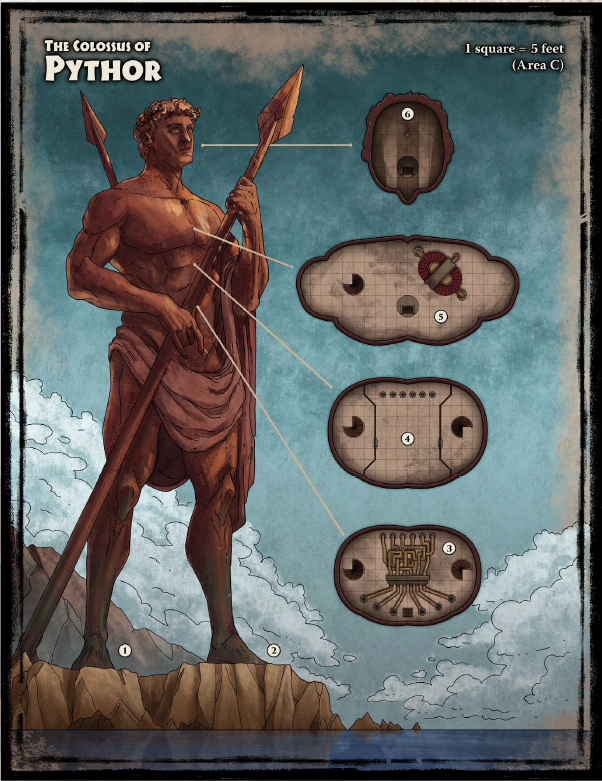
The Cult of the Snake is one of the bigger subplots in this chapter, and the Lady of Coins’ secret headquarters is in the Colossus of Pythor. This is a vertical six-room mini-dungeon guarded by human thugs, minotaurs, and a pair of marble golems. Two of the rooms’ foundations for powering the Colossus serve as traps in a pinch: a series of tubes which can pump gas and vapors of various poisons into the room, and the statue’s “heart” contains a great furnace which can shoot out a jet of flame.
The Colossus’ head is home to Moxena, the Lady of Coins. The sister to the current Queen of the Amazons, she was exiled after attempting a coup when the leaders of the Island of Themis turned to worshipping Lutheria. Moxena is also a medusa, and is using her talents to gain power and resources in hopes of starting a second revolution in her island home. Her abolitionism of minotaur slaves is not entirely altruistic, for she seeks to use their gratitude as soldiers for her cause. She herself dabbles in the slave trade by selling petrified bards of no small talent to the dragon Hexia on the Island of the Dragon.
The PCs can kill or capture Moxena, but they can also make an ally of her: she knows of a legendary sword, Titansbane, upon the Amazons’ Island of Themis which can prove useful against Sydon and Lutheria’s forces.
The
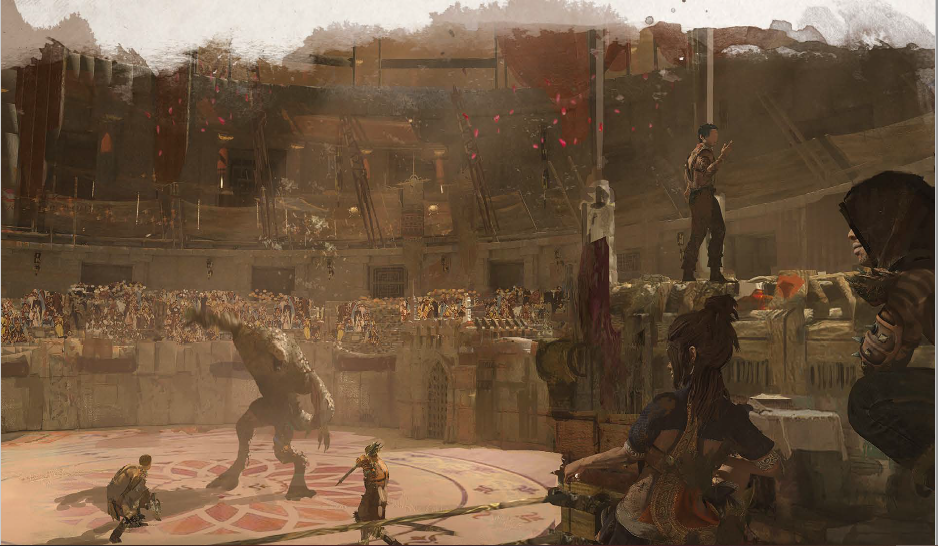
This is the other big sidequest in Mytros, one with some fancy rewards and bragging rights. The Great Games are a supposedly apolitical annual event where the greatest athletes from across Thylea come to win fame and glory for themselves and their respective cultures. The PCs are encouraged to participate should they show interest. In addition to fancy medals, the grand prize is a Crown of Laurels, a magic item which grants +2 to Wisdom saving throws to the attuned wearer.
The Great Games are a week-long event with one competition per day. Contestants can choose one (and only one) spellcaster to magically enhance them (and only them), and the judges are spellcasters who employ divination to ensure a fair game. The PCs will compete against eight other gladiators, who all have their own names, relevant stats, and brief descriptions of their personalities and homelands. Some interesting examples include an arrogant Aresian who has a ‘heel’ reputation in Mytros, a stylish bard with a crowd of lovestruck fans, and an aloof Amazon who is the first of her tribe to compete in the Games. The Great Games traditionally open up with an animal sacrifice, but ever since the Order of Sydon sponsored events they began sacrificing minotaur slaves in ritual combat. The PCs can totally throw a wrench in their bloodthirsty rites by offering to fight the minotaur to a non-lethal standoff, or even alongside the minotaur. If Bullbug has not been rescued or purchased, he may be the sacrificial victim and will call out to the PCs to fight him instead. Queen Vallus will honor such unorthodox suggestions, if only to piss off the Order.
You can tell that Bullbug is a bit of a fan-favorite for the writers.
The individual games include long jumping, a short-distance sprint, javelin throwing, discus throwing, wrestling, and boxing, all with their own rules and die rolls for completion. Each has a ‘trial event’ to weed out the wheat from the chaff, and the wrestling and boxing trial events involve going up against black bears named Crusher and Smasher (the latter one wears bronze-plated boxing gloves). The final competition, the Great Relay, is a five-part marathon and the highlight of the Games. Each segment has its own trials and skill checks: outrunning lions on the beach, swimming beneath a magically-frozen lake and resurfacing in holes cut in the ice, climbing up cliffs, dashing across a bed of hot coals filled with fire snakes, and running across a beach full of caged harpies whose songs can veer athletes off-course.
A lucky PC who wins first place in even one event will be approached by tavern owners to sponsor their establishments in exchange for money in the form of a bidding war.
The Ghost Ship Ultros
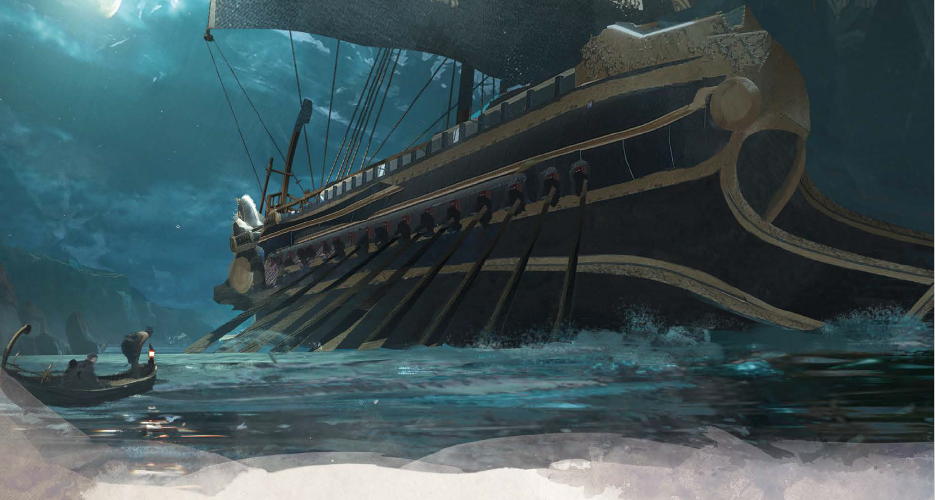
But enough of the side attractions! What of the main plot? Well, King Acastus’ information is genuine, and the map will lead the PCs to the ghost ship’s current location. The bad news is that Acastus intentionally forgot to tell them of the dangers of the area. The Dead Falls are dangerous rapids whose waters are said to lead to the underworld, and the imposing cliff’s rock formations are in the shape of screaming mouths. Rock formations who can come to life and either crush people to death or push them off into the deadly surf below.
The Ultros itself is a spooky two-level ghost ship haunted by spectres. The PCs can find a journal of a crewman which elucidates on some non-public historical knowledge of the setting: Estor Arkelander was a ruthless Dragonlord who sought to reduce the native Thylean races into servitude, and he was a total Blood Knight who got off on sowing pain and fear. He also spearheaded the near-genocide of the gygan people to the protests of his bronze dragon mount, who in turn abandoned him. It was Arkelander’s actions which caused Lutheria to petition Sydon for aid and abandon his vow not to harm the settlers.* He joined her in raising an army, thus beginning the First War.
*a bit of a plot hole, as the consequences for oathbreaking by a god are far greater than if a mortal does it, as we’ll find out much later in the adventure path.
PCs exploring the ship will undertake a trippy dream sequence where the Ultros seemingly dives beneath the waves, passing by many wonders and horrors of the deep but keeping the water out. During this time they come face to face with the ghostly visage of Estor Arkelander, who promises to pass the mantle of captain to the party if they track down and kill the traitors among his crew. Only after doing so will they be released from the dreamlike state. The three crew members can be encountered elsewhere in the ship as ghosts and fought as such.
Once the PCs have done so, he will transfer ownership of the Ultros to them, but also offers them the honor of being his ‘successor.’ He words the phrasing so as to make it seem like it’s part of them becoming captain, so PCs can still refuse but get ownership of the Ultros. A PC who accepts will be possessed by him for an hour, but the consequences are longer-term. Their alignment will permanently shift to Neutral Evil, they become crueler in disposition, and have an obsessive need to become immortal. Estor Arkelander can hijack the PC’s body once per day with no saving throw, and will try to bargain for longer periods by offering various knowledge and advice to the party. If nobody accepts Estor’s offer, he’ll remain as an angry (yet harmless) ghost on the ship for the duration of its days.
quote:
Eventually, Estor's control over the hero may become permanent (which forces the character to retire as an NPC), but this should only happen if the player's behavior has become too disruptive to the rest of the party.
I’m not exactly a fan of this. Permanent changes to a character’s personality, along with the implication that this can lead to disruptive gameplay, and how the GM has free reign to foster PC on PC violence, leaves a rather bad taste in my mouth.
The Ultros will sail into the harbor of Mytros on its own, to the shock of everyone present. King Acastus will view this as a personal affront and fly in on his dragon Icarus, talking about how “we need ships and not dragons to fight the Titans” and backhandedly compliment the intent of their efforts if not the result. But the people of Mytros have grown used to seeing the king’s dragon by now and are still much more impressed by the ghost ship.
Thoughts So Far: There’s an awful lot of stuff to do in Mytros, and many of the side treks have notable rewards and alternative outcomes. The pseudo-Olympics Great Games is a killer concept, and I like how they didn’t make all the events predictable “gladiator combat” affairs. Even so, a few of the quests and encounters feel that they have a ‘strong push’ a certain way: the Boreal Harp solution to Sydon’s storm would be the kind of thing you’d find on multiple playthroughs were this a video game, and there’s little indication for how to gain an audience with the Lady of Coins without cutting your way through the Colossus beyond what the DM improvises. Given that there’s been a lot of foreshadowing that Estor Arkelander is one bad dude, I’m a bit disappointed that the adventure presumes the PCs would go along with hunting down supposedly traitorous crew members rather than alternatives like starting an undead mutiny.
Even so, the open-ended nature of Mytros, combined with the prior chapters, shows that Odyssey of the Dragonlords’ default adventure path can be played many different ways even within the context of its prewritten material.
Join us next time as we head on to the next big portion of the campaign, an open-ended seafaring island crawl in Chapters 4 & 5: Voyage of the Ultros and the Cerulean Gulf!
Chapter 4 is hardly a chapter at all
Original SA post
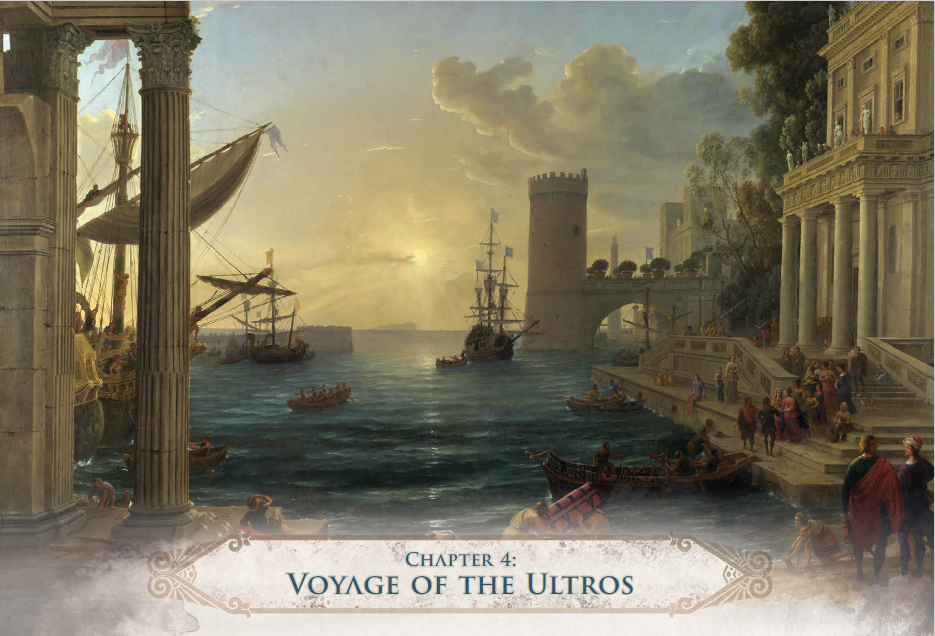
Chapter 4 is hardly a chapter at all. It covers the initial scenes for the heroes readying themselves for the voyage, and a list of Thylea’s constellations and to which islands they’re attuned.
The PCs are presumed to have some time making preparations for their journey, but Kyrah encourages them to set sail quickly. They will not have to sail alone or on a tight budget: various citizens from prior areas in the adventure path approach to give the party farm animals and minor consumable magic items as thanks for their earlier deeds. Queen Vallus presents them with the Antikythera, a magical artifact-compass which can manipulate time and space to ensure a speedy passage between maritime destinations. The compass is attuned to the constellations in the night sky, which in turn represent the various islands off the coast of Thylea. Unfortunately a missing gear was stolen, preventing it from charting course to the more remote areas including the domains of Sydon and Lutheria. Vallus believes that Commander Gaius is responsible, and tells the party that he recently departed for the Order’s headquarters at the Island of Yonder.
So how does the Antikythera work? Well it allows a ship to sail to any attuned constellation destination in 3 days, 2 if proper wind-based magic is used (Boreal Harp, summoned air elementals, etc) or 100 gp of livestock sacrifices to Sydon are made. This time-based shortening is not for flavor: the Oath of Peace will come to its 500-year end in 60 days time when the PCs first set sail. Presuming the Uparty visits each of the 17 islands and stays less than a day on each, they’ll have a window of 9 days before the Doom of Thylea begins. This is not counting any 3-day voyages made back to the mainland.
Finding recruits is trivial for the PCs. A crew of 50 oarsmen minimum is needed to row the Ultros, but 100 sailors will sign up due to the party’s reputation alone. For named NPCs, the deities Kyrah and Pythor will come along as guidance (albeit Pythor is often too drunk to be useful) along with Versi the Oracle. But some optional followers include the satyr fanboy from the Mossy Temple, Bullbug the Minotaur, and Moxena the Lady of Coins if the PCs resolved their respective role-play interactions in a manner earning their trust.
Bioware Trope Alert: Token Evil Party Member: The Ghost of Estor Arkelander will manifest on the ship at night. Should the PCs ask him for advice regarding a dilemma, he’ll invariably suggest options that result in the most fear and bloodshed.
Epic Paths: Versi will experience a vision of a lost dragon egg and tell the Vanished One that it can be found on Fire Island. Queen Vallus will approach the Gifted One before they depart, telling them that the ancient fortress of the Dragonlords can be recovered in the Garden of Helios, but it is now under the dominion of a dragon. She will also tell the Lost One that the few remaining skilled gygan artisans can modify the Antikythera to allow a ship to sail to destinations beyond Thylea’s waters.
Estor Arkelander will tell the Lost One that he buried the treasure of the Dragonlords in the Nether Sea,* sealed in a prison housing the greatest threats and weapons of the gods. He offers to show them the way, but only if the Lost One swears a vow to allow him first pick of the treasure.
*Thylea’s Hades equivalent.
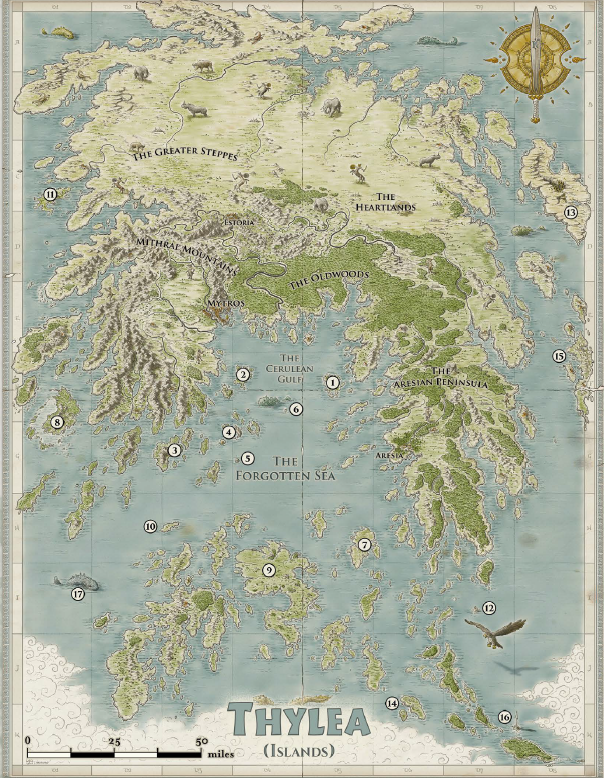
So an interesting thing I noticed about this map. The various numbered locations are split between two chapters, but said chapter titles are misleading. Quite a few locations in Chapter 5, the Cerulean Gulf, are south of the Forgotten Sea such as the Island of Themis. Furthermore, the islands which an Antikythera with its missing gear restored are the geographical outliers (11-17) in Chapter 6, the Forgotten Sea. This confused me a bit, but mapwise it makes sense as the farther options need the missing gear.
Generic Video Game Trope Alert: Aquatic Border Patrol: If you’re wondering what’s preventing the PCs from setting sail early...well, the Ultros is a magically-reinforced ship that even Sydon cannot sink. Any other ship the PCs set sail on would be destroyed by his relentless torrential weather.
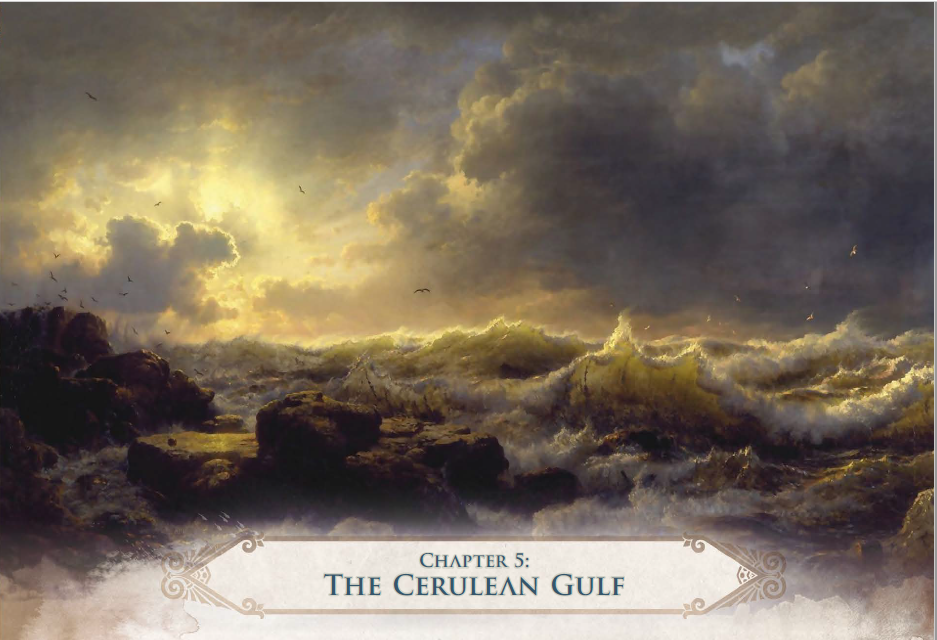
There are 10 islands open initially to the PCs to visit as they will. Sometime after visiting a few, Sydon and Lutheria will menace the party yet again. The Lord of Storms will summon a hellish hurricane that will sink the ship unless the PCs use any clever combination of magic and skill checks at their perusal to get out.* All the while the Titan will issue his booming voice down to the Ultros, speaking of how he’ll kill all who resist him in the end. As for Lutheria, she will send the party a nightmare of their ship’s crew cannibalizing each other. PCs who fail a Wisdom saving throw will enter a violent rage and attack anyone they see for 10 rounds. Although the text mentions that it’s a great opportunity for PCs to fight each other “without guilt or hard feelings,” the relative power level of PCs in comparison to the average crewmen, and the amount of mayhem that can be inflicted in 10 combat rounds, likely means that several people are gonna die.
*or make a hefty sacrifice to him of 500 gp worth of livestock.
Island of the Golden Heart: This bountiful island is blessed with magically-fertile life. A massive tree in the center is the only place where mortals can speak with Thylea: PCs she deems worthy she can answer questions with the strength of a divination spell, and anyone stupid enough to attack the tree will get squashed by a summoned Kentimane who is a CR 29 legendary foe. PCs can hunt golden-manned animals such as a lion and ram whose fleece and fur can be valuable crafting components at the Mithral Forge. The Ram is intelligent and will let the PCs shear it if they ask nicely. Apples and olives harvested can mimic minor potions, and a pegasus can join the party’s cause as an allied mount should a good-aligned rider who has never committed an evil deed in their life respectfully approach. Which depending on how broad we’re defining ‘evil,’ may make said pegasus incredibly easy or incredibly difficult to recruit.
Island of the Chimera: This island is home to a very strong chimera (max HP per Hit Dice) who’s been preying on Thylea’s shipping trade for decades. There’s a thousand gold bounty on whoever can show proof of its death, and its lair is full of stolen treasures.
Island of the Fates: A trio of hags known as the Fates live here, weaving tapestries that foretell the destinies of all. Various monsters guard their lair, and they’re responsible for finding and giving metallic dragon eggs over to Sydon to brainwash and corrupt (and have a copper dragon egg in their possession). The hags can offer their magical services to the PCs, but in exchange they demand some utterly evil actions: kill the Oracle Versi, kidnap a baby to bring to them to turn into a hag, and/or kidnap a nymph for them to torture and eat. There’s also a tunnel leading into a huge pit overlooking the Nether Sea. Said Sea is the dominion of Lutheria, and if you’re wondering if PCs with flight (siren, pegasus, etc) can use this to circumvent a good portion of the AP...well they can, but will likely be very underleveled for dealing with the horrors in the depths.
Epic Paths: The Fates can tell the destinies of the Doomed One, the Haunted One, and the Dragonslayer. For the Doomed and Haunted Ones they explain the divine origin of their respective misfortunes. Their loom can also be used to craft one of the wish list magic items for the Doomed One, but the party must bargain with or kill the Fates in order to use it. For the Haunted One they will explain how breaking Lutheria’s crystal scythe shall free their family’s souls. For the Dragonslayer, they will tell them to seek the Sun God’s wisdom in the Garden of Helios but leave out the fact that said sun god is the dragon that brought misfortune upon them.
They may be near-omniscient, but they’re still evil.
Island of the Exiles: This is a prison colony the Mytrosian government sends its most dangerous and irredeemable criminals. The island is barren save for a few shrubs, preventing any ships from being built, and ships from Mytros occasionally sail here to deliver food rations. The islands’ 25 inhabitants are overwhelmingly evil and guilty of some rather major crimes, but one of the women is actually Acastus’ mother who was exiled here by her son for political purposes. Recently one of the inhabitants was murdered, and the exiles will call upon the PCs as a neutral party to find the culprit. Should they do so, they will be given a rare white ox that makes for 5 voyages’ worth of sacrifices for sailing, and can take on the exiles as crew members to replace any fallen sailors.
Scorpion Island: A group of centaurs living on this island suffer a peculiar curse: those who cannot find a rider to bond with when they come of age turn into giant scorpions. As a result, the tribes here are mostly made up of children and adolescents who spend most of their days partying and avoiding their unfortunate transformed companions. Aresian warrior-monks use the island as a training ground, and both they and the centaurs can tell the PCs about the Lotus Witch: a sphinx who cursed the centaurs to be such and now lives in a magical tower.
Said tower is filled with babies and toddlers, originally adults cursed to be eternally youthful by the sphinx to use as slaves in harvesting fields of lotus flowers. PCs must either kill the Lotus Witch or beat her in a game of riddles in order to undo her curses. PCs who lose against her in a fight will become children, and Pythor or one of the Five Gods will negotiate their release unless the GM wants to end the campaign then and there.
Whether by bonding with them or ending their curse, each PC can potentially gain a loyal centaur mount to ride into battle.
Epic Paths: the Lotus Witch will tell the Cursed One that the magic of their misfortune is on Typhon Island. They must dive into the volcano there in order to end it, but need an appropriate wish list magic item in order to survive the fall. The Witch possesses said item, but will only relinquish it if they answer her riddles (or kill her).
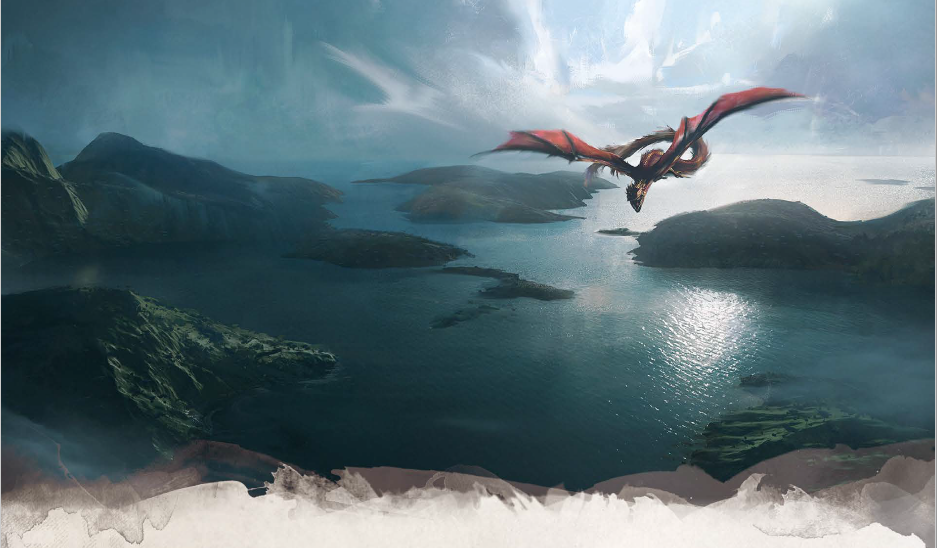
Indigo Island: This forested isle is home to various tribes of barbarians who are the best seabound navigators in all of Thylea, but regard their talents as sacred and not to be taught to outsiders. PCs who visit can prove their mettle in mock combat with some warriors and be invited to a feast. But an evil copper dragon raised by and loyal to Sydon will disrupt the festivities. PCs who hunt down and kill the dragon can earn the gratitude of the tribes, and loot said dragon’s treasure hoard if found.
Titan’s Folly: In times when the Titans numbered a respectable pantheon, the most industrious of their number created the myrmekes. This antlike race was capable of learning even complicated concepts and magic in an astoundingly short amount of time. They used their talents to nearly take over the world, and it took the efforts of Kentimane to seal them away in a tiny island. The islands’ true nature has long been forgotten even by the gods, but is known to hold something dangerous. Titan’s Folly is covered by a transparent dome of magical force, and the native races among the Ultros’ crew will warn the PCs to stay away and forget all memory of the place. However, the PCs will gain strong dreamlike visions of some sought-after magic item being beyond the barrier, the result of the myrmekes’ telepathy.
PCs who manage to magically bypass the dome will find an island of perfectly-sculpted hills home to the myrmekes, who are more curious and hospitable than suspicious. They will ask the PCs all manner of questions about the outside world.
So, what makes myrmekes so dangerous? Well, as part of their monster description they are fast learners: just about any spell, proficiency, or physically-oriented class feature can be learned by them by merely observing its use in action for 1 round. They can then telepathically share this learned knowledge with others of their kind.
The myrmekes will monitor how the PCs get back to the Ultros, and thus replicate the means to escape themselves. For some unfathomable reason they’ll decide that conquering the world by killing off all other races is the only reasonable course of action, and in a manner of weeks will begin construction of Bronze Age-level technology and fleets of trireme ships. Said advanced myrmekes can be encountered as a warship in a future encounter, but the book says that their existential threat is beyond the scope of the campaign…
...even though the adventure path easily covers over one in-game year, which is enough for the myrmekes to exponentially grow and conquer a lot of territory. Not having material on how Thylea will change should they be released is a missed opportunity. Particularly since another colony can be encountered as prisoners in Sydon’s tower-fortress of Praxys.
Fire Island: This is a medium-sized dungeon crawl, with a lizardfolk tribe of Sydon loyalists as the main antagonist. The PCs can gain the aid of lesser tribes, including one led by a rebel lizard queen whose people originally worshiped the god in the volcano. Said volcano god is actually the sole surviving sister of Sydon and Lutheria who was trapped beneath the earth by them. The Lord of Storms has a vested interest in ensuring that the lizardfolk do not end up finding a way to free her, thus sponsoring a regime change loyal to him.
The Sydon loyalists have come upon a pair of brass dragon eggs, one of which they hatched and raised and another still unhatched (and which is the one referenced in the Vanished One’s Epic Path). There’s also a cyclops blacksmith by the name of Steros who crafts magic items for them, but can come to the PCs’ aid (and build stuff for them too) if they promise to find his father who is very likely prisoner on the Island of Themis.
Steros is a Jancan, a subrace of cyclops gifted with enhanced intelligence and skill at the forge. Although he does want to free his father from the Amazons, he also secretly hopes to betray the party and offer them to Sydon to gain the gods’ respect. The book says to role-play him like an incompetent cartoon villain, twirling his mustache and announcing his evil plans within earshot of the PCs when he thinks nobody’s listening.
This guy...is not gonna last long in most gaming groups.
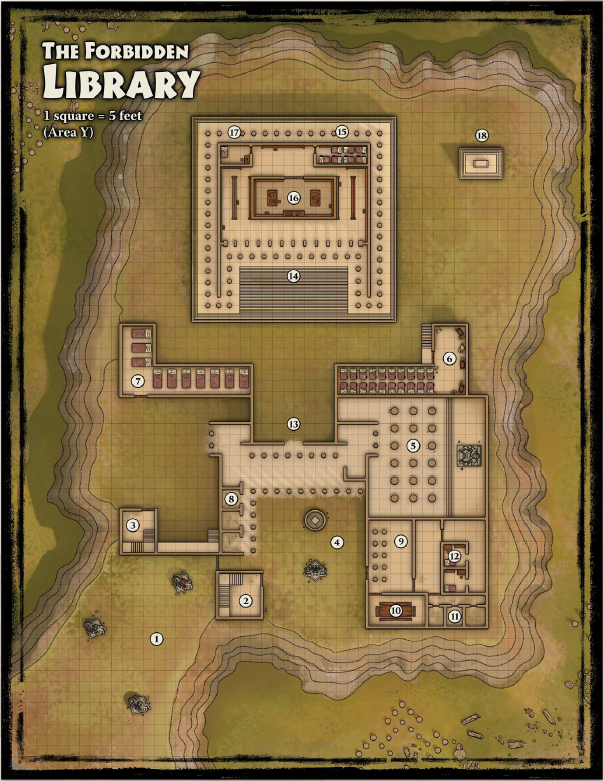
Island of Yonder: The headquarters of the Order of Sydon took advantage of this islands’ natural features for defensive purposes. The soldiers converted the ruins of a gygan library into a fortress and living space, and an inland bay leading to a natural pass in a ring of mountains is the only land-based route to it that doesn’t involve a treacherous climb. Commander Gaius and his silver dragon mount are here by the time the PCs arrive, and he’s in charge of a small army of human soldiers, spellcasters, gygans, harpies, a few guardian golems, and gorgons* who serve as mounts. It goes without saying that they’re hostile to visiting PCs, meaning that either stealth or combat is necessary to retrieve the Antikythera’s missing gear and any other treasures within.
*the metal bull kind, not the medusa kind.
Unlike the inhabitants of previous dungeons, the Order are made up of hardened soldiers and act the part. The fey in the Mossy Temple were drunk and overconfident, the Mithral Mines’ troglodytes left portions of the dungeon untouched due to the presence of other monsters, and Moxena’s minions in the Colossus were guardians of a linear ascent. Every room has a list of differences depending on whether the complex is at rest or on alert, and if the PCs manage to retreat or escape then Gaius will attack their ship with his dragon mount and attempt to kill everyone onboard in order to deny the party a naval retreat.
Beyond the typical gold and magic items, other treasures here are of a more intangible nature. The ruins’ library contains much in the way of forgotten lore, and between that and Gaius’ personal notes can compile information on the dragons who disappeared during the First War. Several theories that they transformed into something else in order to hide. There’s also information regarding much of Thylea’s history beyond public knowledge, which is referenced in an Appendix of its own that I’ll cover later.
In order to retrieve the Antikythera’s missing gear,* the party must deal with its current keeper: Chondrus, the high priest of Lutheria. He’s a wizard of no small skill specializing in AoE damaging spells and some defensive ones like Wall of Force and Stoneskin. He’ll try to bargain for his life if it seems he won’t win, promising to help guide them to his goddess’ realm in the Nether Sea. He will turn on them at the next convenient opportunity. Chondrus has a magical bronze bowl which allows for two-way scrying communication with a yugoloth** in the Nether Sea, who is oddly talkative to any PCs with questions.
*and the book calls out that the DM should ensure the PCs don’t miss it.
**funnily enough these monsters are not OGL. As to why WotC hasn’t slapped a Cease & Desist on Arcanum Studios, well…they’re now actually developing video games for them!
Epic Paths: Chondrus has one of the Dragonslayer’s wish list magic items. He will give it up voluntarily if the PCs offer to spare him, but as usual they can make the smart choice and kill him for it instead.
As the Antikythera’s location is known island-wise to the party before they set sail, it’s quite possible that many gaming groups may heed Queen Vallus’ advice and head to Yonder ASAP. While they’ll likely visit other islands to fulfill their Epic Paths, the 60 day countdown and 3 day interim periods may encourage parties to skip over much of the seabound islands. But they’ll likely be underleveled if they do this too much, which the experience and treasure for island exploration is meant to discourage. But this works more from a metagame perspective, as unless the party heard about a particular island’s features elsewhere they very well may pass it up if they don’t know the risk/reward factor.
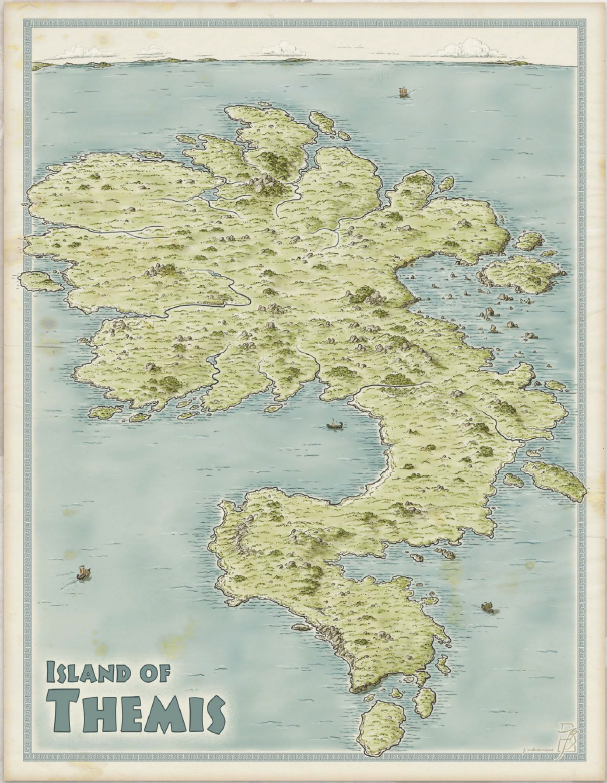
Island of Themis: The Island of the Amazons is the largest landmass off Thylea’s mainland. Its position is subtropical and includes animals unseen elsewhere in the region such as giraffes, rhinos, and hyenas. Most of Themis’ land is open plains, and the Amazon tribes travel across it in semi-nomadic bands fighting each other in ritual combat to determine land rights and in settling disputes. Every Amazon is trained in the arts of war from an early age alongside another warrior who becomes their ‘lifemate.’ They’re made up of various races both settler and native, and their martial prowess is famous throughout the rest of Thylea.
If Moxena is part of the crew she will highly encourage the PCs to take her during their foray. Same for Steros, who wishes to find his imprisoned father.
Thirteen years ago the Amazonian government underwent a violent coup as Queen Thesilea seized the throne in the name of Lutheria. She and her two sisters wear magical platinum helmets which disguise their true natures as medusae, and the next most legitimate heirs to the throne have been imprisoned in their secret dungeon, or exiled in the case of Moxena. PCs have the chance to sense things are amiss via some encounters on the island, including a roving band of maenads, goatlings, and pervy men. They’re drinking, gambling, and having sex in a wild party, loudly announcing that the island is part of Lutheria’s domain now. Bands of Amazon warriors encountered separately will be hostile unless the party is all-female, believing them spies. Otherwise they’re escorted to have an audience with their queen
Men are permitted on the island only under strict supervision and in small numbers for the purposes of procreation and then sent their way, although in some cases male prisoners of war from elsewhere are kept as sex slaves. Queen Thesilea/the writers decided that they could be EVEN EDGIER and began construction of an underwater temple where young boys are raised and brainwashed to view themselves as sacred sons of Lutheria to be used as eventual breeding stock. But on their eighteenth birthday they’re killed via petrification and serve as decorative statues.
Irregardless of the terrible nature of sexual slavery, having a strict cut-off point of 18 makes it seem less like they’re being productive in keeping up their numbers and more that Queen Thesilea has a thing for underage boys.

The Queen’s lair is in a sacred temple which also serves as Themis’ only prison. It is a multi-level dungeon crawl descent beneath the surface, guarded only by the Queen’s most trusted hand-picked Amazons so others encountered on the island cannot tell the party its specifics. The complex has a mixture of normal Amazon warriors, their war-trained basilisk and stimfay companions, and goatlings as major opposition. Places of interest here include a set of natural tunnels guarded by a Hydra, who ate the sword Titansbane after Queen Thesilea tossed it out; the cyclops prisoner Bront, who can tell the PCs the current location of said sword and will be eager to return to Fire Island because the lizardfolk there treated him better; and a magically soundless prison cell containing Darien, the legitimate heir to the Amazon throne. She was kept alive for 13 years as part of an oath by the Queen not to harm the children of the losing side, and is eager to help the PCs in taking revenge against the usurpers. There’s two squicky encounters where the PCs can walk in on Amazons and goatlings having sex with their brainwashed male slaves, including one where one of the medusa rulers seems too preoccupied to attend to a crying baby in a cradle in the same room...which is actually a goatling in disguise, thank God.
It is possible that the PCs can determine who next sits on the throne after killing the Queen. Darien, an Amazon PC, and Moxena are the likeliest candidates, although Moxena will do everything she can to undermine Darien if she’s chosen. If the PCs treated Moxena poorly overall, then she’ll order the Amazons to slay the party if she becomes queen.
Epic Paths: Queen Thesilea carries the Haunted One’s other wish list magic item containing their family’s memories. The item will whisper that the Fates know of how to free the rest of their kin...which may be superfluous if the party dealt with the Fates before coming to Themis.
Thoughts So Far: I love the concept of an island-hopping sandbox with enough adventure hooks to encourage some exploration between them. Only a few qualify as true adventures/dungeon crawls, with most of them being one to three encounters at most. But I feel that they’re overall the right length so as to prevent the island-crawl from feeling too long. I do feel that the shorter island encounters may produce unbalanced results in favor of long rest-focused classes, given that by the time you complete a shorter island like Golden Heart or Chimera you’ll have 2-3 days (and one sea-based encounter) before stepping foot on to the next island.
There are a few weak points, namely what happens if the PCs screw up big time and lose either the Ultros proper (Sydon sinks it) or their crew numbers get too low (Gaius and his dragon killing the crew). Given that it’s possible at least one PC may have a Divine Boon to rescue them from certain death, the adventure path has no suggestions on how to resume back on trail for lone survivor PCs. There’s also the fact that the PCs can get an awful lot of DMPC allies fighting on their side which may unbalance encounters. The pegasus mount is a cool concept, but the centaur mounts may potentially double the party number.
The Island of Themis is one that requires the most work: there’s a fair chance that the party will have anywhere from 3 to 7 DMPC allies fighting alongside them for the dungeon crawl. The creepy sex stuff, combined with the possibility of an all-women party bypassing much of the dungeon (the other Amazons revolt and converge on the temple-prison once the medusae are killed) are other things that will have to be rekindled for most gaming groups.
Join us next time as we move on to Thylea’s far reaches in Chapter 6: the Forgotten Sea!
While there’s technically seven new locations
Original SA post
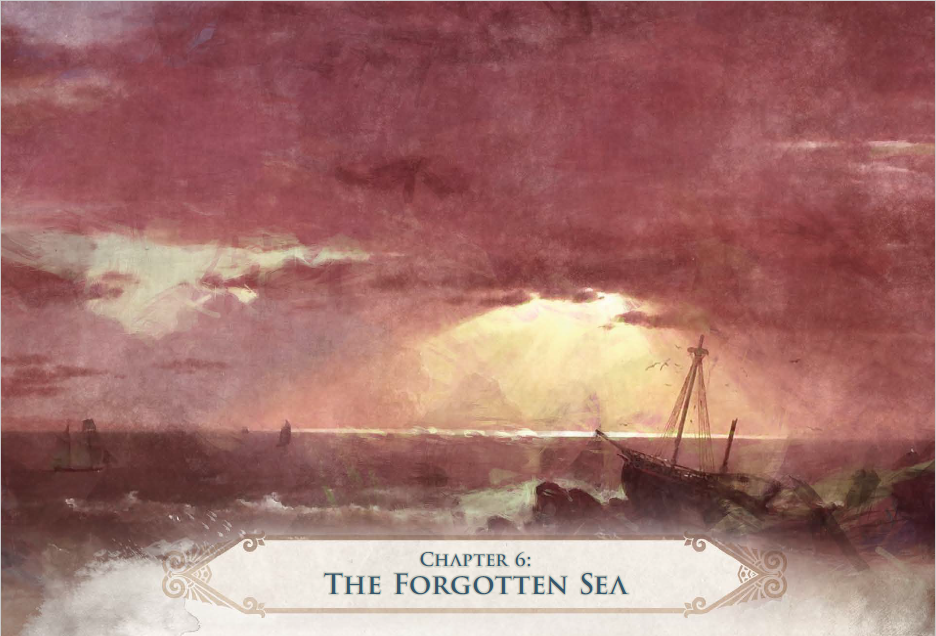
While there’s technically seven new locations the missing gear unlocks, two of them are detailed as chapters in their own right: Sydon’s tower of Praxys, and Charybdis whose abyssal maw serves as a portal to the Nether Sea. The wide open oceans extend over a thousand miles around Thylea in all directions, which is where Sydon’s power is strongest. Few sailors dare go farther and risk the sea god’s wrath. The Lord of Storms’ presence is felt during voyages to and from the islands in this chapter, with powerful waves and frequent rain storms that never seem to end.
Bioware Trope Alert: Mobile Base of Operations: A big thank you to Weiley31 of EN World for pointing out one I somehow bypassed. In the Star Wars and Mass Effect series, you had a starship which was used to sail between planets. Your various allies and party members lived on it when not going on missions with you, and who you can talk with to pass the time. In some cases you had to defend said starship from attacks by aliens, space pirates, and other such threats. You also did not get said starships at the beginning, instead having to earn their use after completing a quest in the main plot.
Aerie of the Roc: By far the shortest entry in a relatively short chapter, this pillar-like island sports a roc’s nest on top. The mighty bird is rarely home, flying across the land to abduct food to feed to its hatchlings. The nest itself is home to six baby rocs who are dangerous in their own right, with treasure randomly-generated from the DMG table to PCs who search through the nest for the birds’ prior victims.
The Garden of Helios: This verdant island is a sheer plateau with no natural harbor, forcing the party to fly or climb in order to reach its surface. About 100 cyclops live simple lives herding elephants on the island, overseen by a self-proclaimed Sun God known as Helios. He’s made a deal with Sydon to turn the cyclops into soldiers for the eventual war, but Helios is regretting this decision as he’s come to view the cyclops as his own children.
Helios is in fact a gold dragon polymorphed into human form, and unlike others of his kind is of evil alignment. He’ll be courteous to visiting PCs, inviting them to dinner at his castle before growing bored of their conversation and deciding to have them for dinner. As this is a violation of Guest Hospitality, the Furies will dispatch three erinyes to fight alongside the party and take him to the Island of Oathbreakers unless the PCs kill him quickly enough.
Amusingly the text discusses how Helios is in fact a false god, using a magical flying chariot in his treasure hoard to add to the illusion. But in the Introduction chapter we see him listed as a god who can grant the Wealth domain to Clerics. The book never elaborates on how he’s able to do this.
Epic Path: Helios’ treasure hoard contains Daern’s Instant Fortress, which is what the Order of Dragonlords used as a mobile base of operations. Appropriately enough it has dragon-themed artwork and motifs in its construction.
This is also the “endgame” portion of the Dragonslayer’s quest. Helios will gleefully tell said PC of how a prophecy foretold that someone among the PC’s village would kill them. He focuses all of his attacks on the Dragonslayer during the battle.
Island of the Dragon: This tropical island is covered in thick jungle and lagoons. The green dragon Hexia is its uncontested ruler, and several tribes of elves live in fear of her. The dragon’s nature-themed spells turn the very wildlife into her spies, and unless the PCs take pains to mask their every move she will soon learn of the Ultros’ docking. She used to be one of Pythor’s lovers, but grew jealous that she could not have him to herself and so killed many of his trysts over the years. While the PCs are exploring the island, she’ll kidnap Pythor to take back to her cave.
The Kraken also makes its lair in a cave deep beneath the island and is home to many treasures. PCs can find an Orb of Dragonkind, 1 million gold pieces worth of minable silver, and randomly-determined DMG loot from one of the higher tables (CR 11 to 16), but there’s a greater chance the Kraken will return the longer the PCs linger. The pressure this deep is so great that only magic such as Freedom of Movement or dive suits built by the God of the Forge can protect against constant bludgeoning damage.
Epic Paths: This is the Demi-God’s ‘endgame’ quest for the purposes of gaining the Divine Blessing, although thematically their plot truly comes to an end when they save Thylea and/or become the new God of War. Their mother is a prisoner in the cave, who only managed to survive by entertaining Hexia with stores that appeal to her ego. The Demi-God’s mother knows some details of all the other islands in the Forgotten Sea, and implores the PC to “succeed where their father failed and save Thylea from the Titans.”
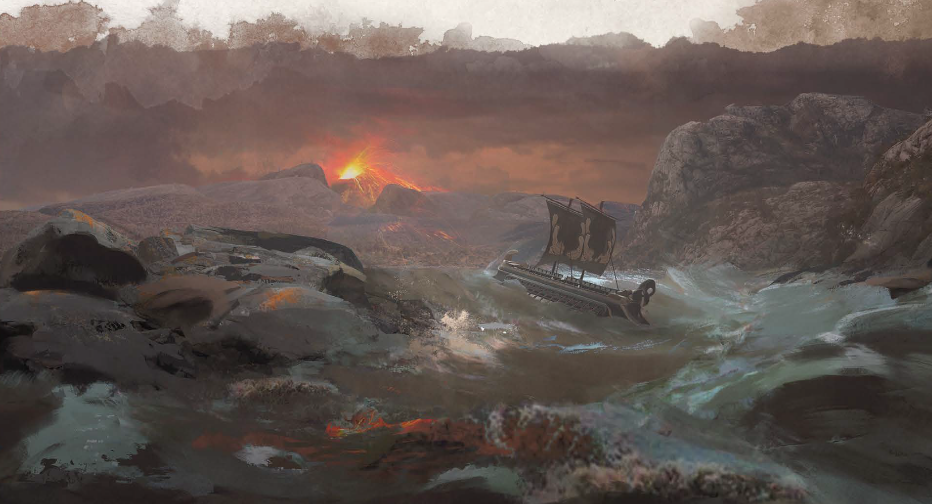
Typhon, the Maw: This desolate volcanic island has jagged rock surrounding its shores, and sailors rightly avoid it for its reputation of being the original home of many of the world’s monsters. A volcano known as the Maw is the central feature, and in order to get there the PCs must pass through several monster-filled caves. Most of said monsters are fiends and nothing special, although one encounter is a very blatant case of the writers being Horny on Main:
TW: Sexual Assault
Quote: Moans and screams can be heard from within this cave mouth, growing louder as you move inside.
After a few minutes of walking, you come to a large, dimly-lit cavern. There, a man with the legs of a goat and great black curved horns reclines on a rocky throne. In his hands he holds an ornate gold scepter, which he fondles as he gazes at the spectacle at his feet: a wine-soaked bacchanal of revelers indulging their carnal passions.
The scepter-bearing satyr is actually an incubus using a Rod of Rulership to force captives to have sex with each other and to fight the PCs if they try to put a stop to things. Said people are quite aware that they’re being violated; if the mental hold is broken, or they’re freed from the cages they’re kept in when the incubus is away, they will help the PCs take revenge against the incubus.
The Maw itself is a platform overlooking a deep, deep fall into the volcano’s heart. There’s a portal to Hades beneath the lava, and those who survive its deadly heat will be sucked into this dread realm. Whispers from innumerable souls fill the Maw, and PCs who manage to persist for 4 rounds by making several Wisdom saves to avoid insanity gain a randomly-determined Charm or Blessing from the Dungeon Master’s Guide.
Epic Paths: This is the endgame for the Cursed One’s quest. Using the magic item from the Lotus Witch to guard against the volcano’s damage, they leap into the Maw and emerge in Hades. There they meet the ancestor responsible for their family curse, watched over by Cerberus who explains that killing them is the only way to end the curse. A PC who follows through with this ends the curse on themselves and the rest of their family/tribe/etc, awakening back on Typhon Island.
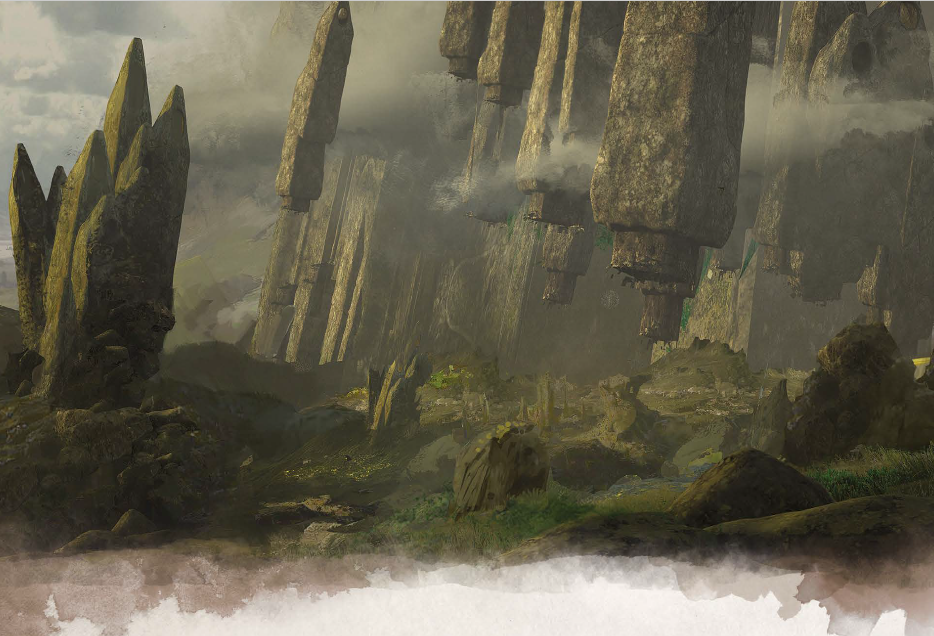
Island of Time: Everything gets trippy as the PCs approach this island. The sky above rapidly cycles between night and day, although no time is passing in the wider world beyond. The stars in the night sky wink out of existence while others take their place just as rapidly, and those exploring the island experience several fugue states where they experience encounters as a series of montage events. The Island is the home of sphinxes, who have a special relationship with the concept of time in this setting. An androsphinx rules the island, and will roar once for every encounter area the PCs visit. By the third roar they are no longer welcome on the island and he will arrive to fight them; the warning roars are explained by a gynosphinx resident, so the PCs know they have a limit.
While here, the PCs can find a treasure vault containing Arrows of Empyrean* Slaying which are keyed to be effective against gods, Titans, and their children. A dinner party of long-haired old figures who’ve been here for eternity and can only be awakened by the androsphinx. There’s also a telescope which shows the future of the City of Mytros by a magnitude of ten each time it’s viewed, showing a world less familiar and more alien every time until it goes dark by a million years.
*Empyreans in Odyssey are different than their Monster Manual counterparts. Their alignment can differ more, they are explicitly the children of a god, and have use of said parent’s divine Domain.
Should the PCs risk the androsphinx’s wrath, he’ll teleport them to the Far Realm, an alien expanse of gigantic stretched faces making up the landscape while a black moon in the sky bleeds waterfalls of blood. The sphinx will spare the PCs should they answer one correct riddle per party member if they lose or surrender, and invite them to the dinner party where they gain the benefits of a Heroes’ Feast.
Thoughts So Far: This was a pretty short section, although it’s quite clear that the locations are meant to serve as endgames for several Epic Paths. I feel that Helios’ actions in violating guest hospitality are a bit too stupid for what should be a PC’s archenemy, and unlike other villains or notable NPCs they don’t really have prior interactions with the party to build a kind of proper relationship. I really liked the ambient creepiness of the Island of Time, but I felt that the Island of Typhon and its Cursed One resolution to be underwhelming. To say nothing of the incubus’ magically-coerced orgy.
Join us next time as we sail into Charybdis’ maw and enter the Nether Sea!
Continuing our nautical chapter themes
Original SA post
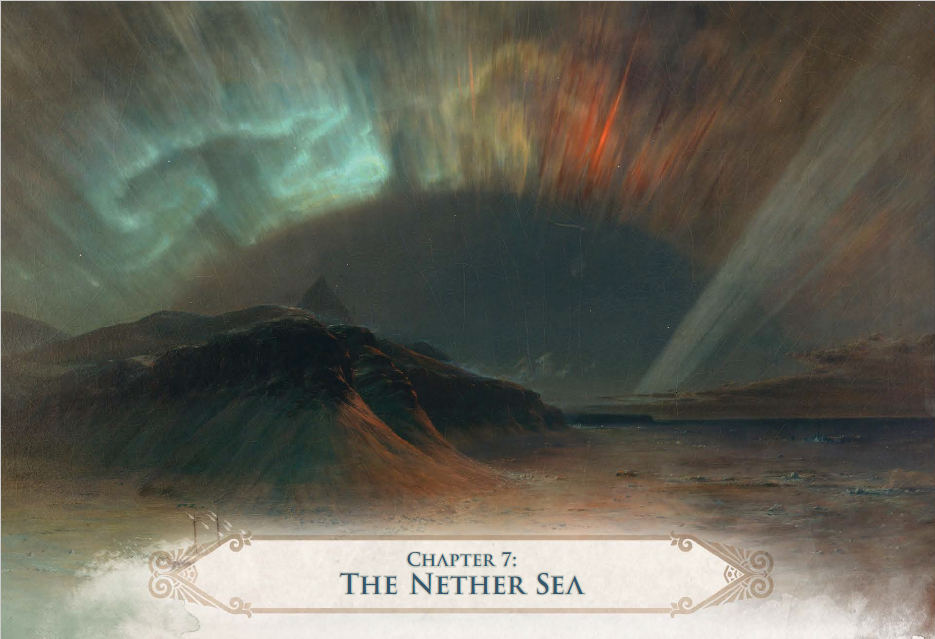
Continuing our nautical chapter themes, the Nether Sea is one of the two realms of the titans who the PCs must visit in order to avert the Doom of Thylea. It is accessed via Charybdis, who much like in the mythological source material is a giant whirlpool. The one of this setting is in fact a portal kept open by two of Kentimane’s hands, and the mixing of the two oceans is what results in the whirlpool. A ship which ends up in it will sink, but instead of a watery grave will spin down to what very well looks like a subterranean ocean.
The Nether Sea is in perpetual night, and has its own pseudo-sky and constellations which are mithril veins in the cavernous ceiling. The waters are highly acidic and can quickly eat through the hull of most ships (but the Ultros’ is highly resistant), and those who become submerged or drink the water end up having their very forms changed. There’s a d100 table with a list of effects, and the durations get longer the more times one is exposed to the waters; you may get lucky and turn into an elemental, treant, or merely get an increased ability score, but at worst you may turn into a statue or lighter-than-air gas. Scattered through the plane are iron prison cubes impenetrable even to the efforts of the gods, holding unknown monsters from the world’s earliest days. Massive evil-aligned whale-like things swim about and ignore the party unless attacked. These monsters have no names, for their existence is unknown to the mortal world. I actually like this touch of unknown horrors.
The Nether Sea is vast, but the adventure details 7 places of note. There’s a Charybdis-clone which can shoot the Ultros back up into the air so the PCs can leave, and the River Lethe pours from a high-above tunnel in the form of a rainstorm. An island containing Lutheria’s petrified titan siblings can tell the PCs of their sister’s weaknesses, where and how to find her, and the properties of the Nether Sea as a plane of existence. The Island of the Oathbreakers is a prison managed by yugoloths and erinyes devils, and one of the prisoners can give both similar and new information as the titans.
Epic Paths: One of the prison cubes has already fallen and broke apart. It once housed the Kraken, but now it’s home to Hezzebal, a former brass mount of a Dragonlord driven insane from his time in this forlorn realm. He blames the Vanished One for being left behind, and will treat the PCs as an enemy unless they magically heal his shattered mind. The fabled treasure hoard of the Dragonlords is here, and the Lost One can find one of their wish list magic items among the loot. Estor will claim the Xiphos of Slaughter as part of the oath, a cursed item which drives the user murderously insane. Which is a good deal as such a mentality is superfluous when it comes to the wicked ghost.
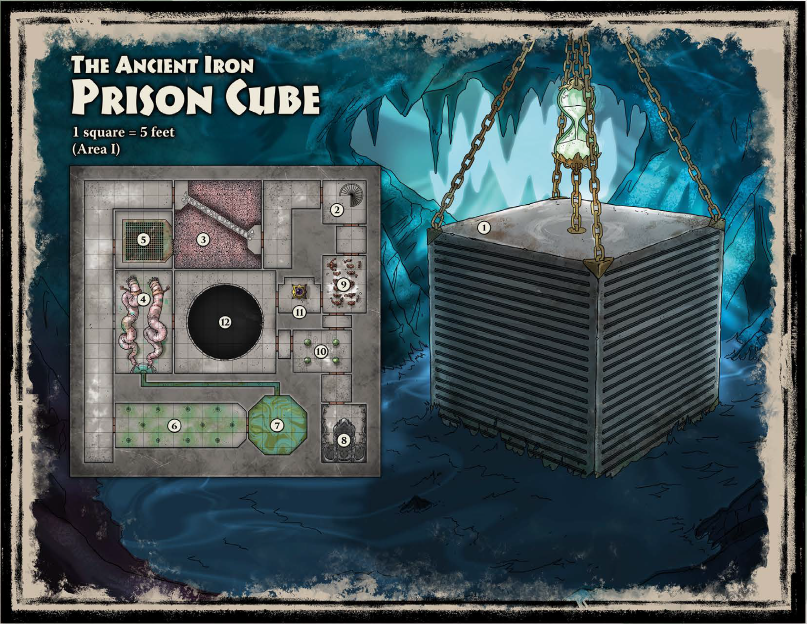
Prison of the Tarrasque: The only other cube the PCs can infiltrate is a mini-dungeon which houses perhaps one of the most infamous entries in the Monster Manual. An impossibly slow sand hourglass hangs above the cube, counting down to 300 years until the cubes open and the beast and rest of its kin are free to terrorize Thylea once more.
 Trope Alert: Time-Sensitive Unsealed Evil: The cubes unlock early during the final chapter of the adventure path. Additionally, the overall concept of these monsters is not unlike the Old Gods of Dragon Age Origins. Said beings are dragons corrupted by Darkspawn blood who slumber deep beneath the earth and rise every few generations to make war upon the surface. Mass Effect’s Reapers are the same in that they lair in the dark reaches of space before coming to destroy galactic civilization every 50,000 years or so.
Trope Alert: Time-Sensitive Unsealed Evil: The cubes unlock early during the final chapter of the adventure path. Additionally, the overall concept of these monsters is not unlike the Old Gods of Dragon Age Origins. Said beings are dragons corrupted by Darkspawn blood who slumber deep beneath the earth and rise every few generations to make war upon the surface. Mass Effect’s Reapers are the same in that they lair in the dark reaches of space before coming to destroy galactic civilization every 50,000 years or so.The dungeon is a one-level, 12 room jaunt, and all of its inhabitants are geared towards the care and feeding of the tarrasque. Golems forged out of primordial clay act as stewards and caretakers, feeding and breeding a pair of chained purple worms for their larvae. Said grubs are thrown off a bridge into a massive chamber full of thousands of the squirming things. An ultraloth is the cube’s ‘warden,’ tasked with guarding the tarrasque as part of an oath with Lutheria. He has no love for the god and will offer to show them how to find the goddess by awakening the tarrasque which sleeps at the bottom of a deep pit in the cube. A secret he will share if the party swears an oath to kill the goddess and bring back her crystal scythe to him. Fortunately by ‘awaken’ he means merely raising it from its slumber as opposed to freeing it: the beast will angrily ram against the cube’s sides, attracting Lutheria’s attention and summoning her barge into nearby waters.
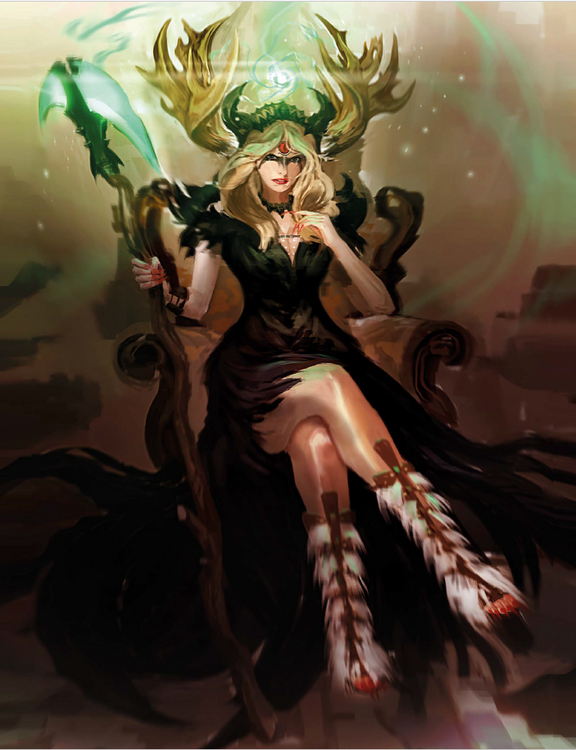
Hypnos, the Throne of Dreams: Lutheria’s residence of choice is a garden-barge towed by her enslaved sibling Talieus, who confusingly shares the same name as one of Sydon’s sons encountered in Praxys. His eyes and mouth are sewn shut by indestructible thread, but the sword Titansbane can cut through them. This frees him from service, and he gives the party a hearty thanks by leaving Lutheria’s base of operations high, dry, and immobile. The barge’s magic and floral scents create a dreamlike sensation of those who board: the PCs will lose their overall sense of time and distance.
 Trope Alert: Impassive Enemies: The barge’s inhabitants act irrationally and do not notice or react to fights and other disturbances outside their rooms no matter how loud things get.
Trope Alert: Impassive Enemies: The barge’s inhabitants act irrationally and do not notice or react to fights and other disturbances outside their rooms no matter how loud things get.A fair portion of enemy monsters have deception, fey, and shapechanging themes. Jackalweres and lamia are the most common monsters and take various forms: beautiful people who attend who tempt the party with sleep-inducing drugs,* children who seem eager to show them a gallery of strange art and treasure, and drooling madmen who attack if the PCs try to steal any treasure as but a few examples. The barge’s armory is full of cursed weapons and armor forged by Sydon, their magic wrought from Lutheria’s own mind in a failed attempt to cure her insanity. The equipment causes the goddess to gain disadvantage on attack rolls and/or suffer the Confusion spell effect when she attacks those bearing such an item. Even better, the equipment will immediately be rid of their curses if this happens during combat.
*they won’t kill sleeping PCs. They will bind them in the kitchen quarters to later cook them alive.
Lutheria herself holds court in the very last, very large room. A group of goatlings along with a pair of lamia and satyr minstrels* are drinking and partying. The PCs are being judged by the goddess as soon as they set foot here, and if they piss her off too much she’ll abandon any attempts at mercy, negotiation, or chatter and attempt to kill the party. It is possible to bargain with Lutheria and renew the Oath of Peace, although the adventure path at large leans heavily in favor of going Kratos on her ass given that her demands are both unpalatable and create a minor plot hole: in the very next chapter, she ends up attacking Mytros despite this explicitly being forbidden, thereby making her an oathbreaker.
*like satyrs, but with some bardic abilities.
What are the 3 things that change Lutheria’s reaction one way or the other? First, choosing to join in or refuse the attendant drunken party (which will deal psychic damage until a Wisdom save is made); laughing or not laughing, however insincerely, at Lutheria’s terrible comedy routine where she only knows jokes about torturing children; and finally, challenging her to a game of Twenty Squares in which the Three Furies will act as neutral judges.
Twenty Squares is a very popular fictional board game of strategy and skill, and the boards are magically enchanted to make players honorbound to the conditions set should a player win or lose. The PCs must be the ones to request the game, and part of the game’s rules means that the challenged person sets the terms of winning/losing. Lutheria summons seven crew members along with seven of her goatlings, where the losers’ side will die at the hands of her crystal scythe.
Twenty Squares has no fancy mini-game rules. It is a series of seven opposed skill checks where the first person to roll higher in four of them wins the game. Each check is a specific skill in order, with a focus on strategy-minded and social ones such as Deception, History, Insight, etc. Lutheria, being whatever the womanly equivalent of an immature manchild is, cannot stand the thought of losing and will resort to cheating by spending one of her Legendary Resistances* to automatically win a check. This is a weakness the PCs can learn on the Island of Oathbreakers. It says that the PCs can catch Lutheria cheating with a high enough Perception check, but does not explain how/if the Furies punish her if caught red-handed. Which, given that Twenty Squares’ rules has magical foundations, begs the question of to what extent cheating counts as oathbreaking.
*A common 5th Edition “boss battle” ability where they can automatically succeed on a saving throw should they fail it.
Renewing the Oath of Peace: The only terms Lutheria agrees to are:
1. The party as a whole must swear an indefinite Oath of Service to her where she can ask them to do anything for the rest of their lives upon pain of death (Geas). This will not be enforced until the PCs render Sydon dead or defanged of being a threat.
2. She will promise not to harm the mortal cities of Thylea, with the implication that smaller settlements will receive no such protection.
3. Lutheria’s temples will remain standing and receive worship and sacrifices. The book says that this will be a continuation of the status quo in regards to her faith and its activities.
4. As Sydon is not present, renewing the Oath here will not ward off the Lord of Storms’ wrath. But she will not aid her brother nor hinder the party in opposing him and his Order.
No halfway-reasonable gaming group is going to find this satisfactory. Not only does it allow for Lutheria to make any number of demands on the PCs, it will not bring peace to Thylea. Her brother Sydon is still a threat, one which she is not obligated to commit any resources on her part in fighting. Furthermore, the promise not to attack Thylea’s cities rings hollow; even discounting the many smaller settlements, Lutheria’s cult is very much a “rot from within” type of cult and doesn't have standing armies. One could argue that individual acts of her worshipers (like the cult in Mytros) can violate this, but the mention of continuing the status quo makes it sound like the cult is going to keep being sex pests, murdering children, and transforming teenage girls into monsters (not discounting when she breaks this part of the deal in the chapter of Mytros’ invasion). Furthermore, she will not budge on any issues, no matter how much the PCs got on her good side.
Compounding things, the Doomed and Haunted One’s backgrounds cannot be resolved unless the PCs kill Lutheria, and she has no desire to reverse their ill fortunes.
So what if the PCs end up in combat with Lutheria? Well, it’s going to be a very difficult battle. They should be around 10th to 12th level at this point in the campaign unless they skipped most of the islands, but the goddess herself is a Challenge Rating 23 powerhouse with some impressive stats. She has advantage on saves vs all forms of magical abilities (not just spells), and her lowest saving throw is +5 Dexterity (the rest are in the double-digits). She has 3 legendary actions, and can spend 2 of them to afflict Confusion or dealing 6d6 necrotic damage to a target on a failed Wisdom or Constitution save respectively. Her offensive spells include a mixture of some debilitating options such as at-will Blight and Hideous Laughter, and 1/day Finger of Death, Irresistible Dance, and Animal Shapes among less directly offensive options.
Fortunately the PCs have a few advantages. In addition to the above cursed equipment and draining her legendary saves, she will not immediately take action for 1 round and order her minions to attack the party first. Her servants all have the poisoned condition from their bacchanal and thus have disadvantage on attacks and ability/skill checks. Furthermore, a few of her spells are utility effects which won’t be of immediate use such as Pass Without Trace, Dreams (1 minute casting time), Mirage Arcana (10 minute casting time), and Project Image (which may grant her remote sensing but her Truesight makes this limited in effect). She can cast Animal Shapes which can buff the goatlings into something fiercer, although as it’s concentration that can limit her ability to drop Hideous Laughter and Irresistible Dance. Besides a natural flight speed and her 180 foot Legendary Action Confusion, she doesn’t have any good long-range means of attacking long-range or mobile attack opponents. A canny party might be able to reliably remain out of her range. Scorpion Island centaurs, the pegasus, and Hezzebal the dragon* can all make for reliable allies at this point in the campaign.
*who has 3 permanent levels of exhaustion once cured (disadvantage on pretty much every d20 roll and half speed), but is still a formidable dragon.
Epic Paths: Lutheria will waste an additional round of combat laughing at the Doomed One as she recalls how she made their life a living hell. In the event that the Haunted One is present, she will become fearful of what he represents and focus all of her attacks on them to the exclusion of any other threats.
Much Ado About Oathbreaking: I’ve been going on in the past of how breaking an oath is a much bigger deal for the gods than mortals. And since I’ve been talking about it quite a bit, I may as well spill the beans on what happens. A deity who breaks a sworn oath dissolves out of existence, their form turning into grain-like motes before disappearing entirely. The process is not instantaneous, but it takes effect quickly and manifests in a matter of rounds. This is in fact how Lutheria meets her end at the conclusion of the Adventure Path when she goes crazy enough to try and destroy all of existence. The specifics are that she promises to help some risen empyrean former gods in destroying the PCs, but instead lets them die at the party’s hands so as to fuel a Sphere of Annihilation. Her current actions in this chapter surely beg the question of what makes the time in the Nether Sea different than in the grand finale when she goes back on her word with another group.
Thoughts So Far: The Nether Sea is cool in concept and I adore its creepy Primordial Horrors of the Deep theme. The various means of finding out Lutheria’s weaknesses and follies are great as well, allowing for the party a chance at adequate preparation against what may very well be one of their most difficult fights so far in the adventure path.
The chapter’s weak points revolved around Lutheria herself, be it her plot hole-inducing actions or the sheer one sided nature of her terms for renewing the Oath of Peace. It is the most transparently-unfair Deal with the Devil scenario I’ve seen in a D&D adventure, and that’s saying a lot. Even discounting the fact that it doesn’t stop Sydon, I imagine that precious few players will want to willingly bind themselves for life to a Chaotic Evil Dionysus. Although she is a literal goddess, it seems unreasonable to make her encounter so wildly out of bounds for the average party level when combat against her is such a likely scenario and all but mandatory for 2 out of the 8 Epic Paths.
Join us next time as we climb Praxys, Sydon’s Tower of Power!
Praxys is the tallest building in Thylea
Original SA post
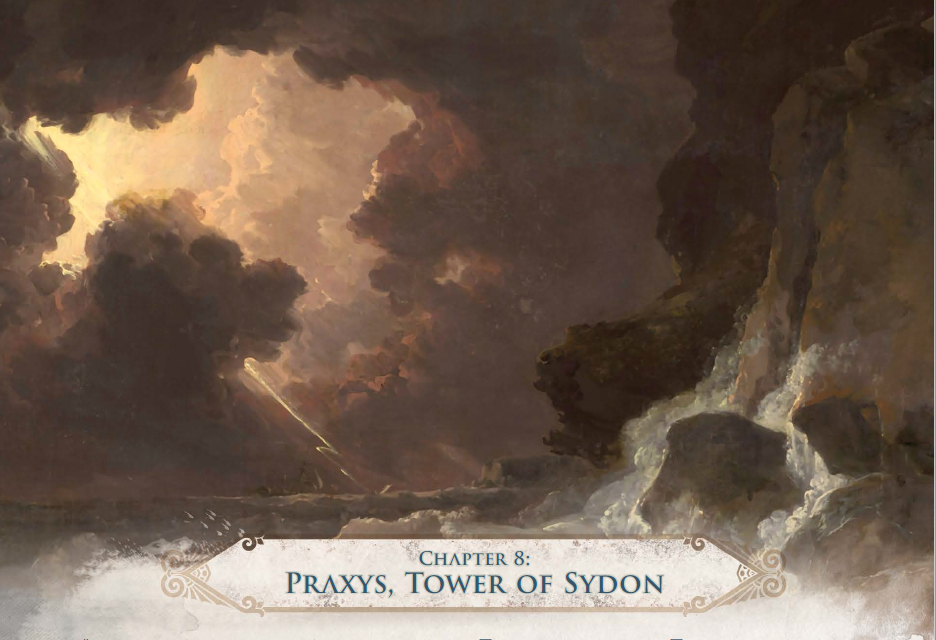
Praxys is the tallest building in Thylea, although we don’t get an actual number. The adamantine doors at the front entrance are 40 feet tall, and judging by this outer tower map it looks to be over 400 feet tall by my ballpark estimate. Or about 60 feet less if we discount the giant shining orb on top.
One does not simply sail to Praxys: the seas are perpetually stormy, and the waters seem to have a mind of their own as the ships of his followers are seemingly unhindered. In fact, the PCs will see 30 warships departing from the Tower, heading in the direction of Mytros. They will not attack the party unless provoked, but there are literally hundreds of enemies between them and given 5th Edition’s bounded accuracy a straight-up fight will not work for most builds.
Sydon’s tower is a 37-room, 8 level dungeon; 9 if we count the lighthouse orb containing an intelligent star enslaved by Sydon. Much like the Island of Yonder, the inhabitants of Praxys have proper military training and there’s a 2-page chart of the make-up and composition of rooms based on different levels of ‘alert’ status. Virtually every room has an entry explaining what NPCs will do in the event that they become aware of infiltration or assault. The party has different means of gaining access to the tower, although Sydon has contingencies for most things possessed by mid-level adventuring parties and conventional armies. The front gate is guarded by cyclops artillerists operating ballista, and the door itself is made out of adamantine and can only be opened either by unbarring the other side or 200 combined Strength. A group of griffons and harpies fly around the towers’ upper levels on the lookout for aerial assaults, while the pipes and plumbing system draining out into the sea has merrow operators. Last but not least, every room of the tower has a permanent Forbiddance spell which blocks teleportation and ethereal travel into or out of Praxys. The monsters are varied, ranging from the martial and giantish races being the most common to less obvious choices such as a cerberus hound, an euryale medusa, and several of Sydon’s empyrean children.
This makes for a dramatically different contrast than Lutheria’s barge, and is even remarked upon by Kyrah and other knowledgeable NPCs in the adventure path who suggest visiting the Nether Sea first for this very reason. The Lady of Dreams is dangerous, but her immaturity and hedonism make for poor organization. The Lord of Storms, on the other hand, is very much the exemplary Lawful Evil Overlord and as such has a much more difficult dungeon.
I’m not going to go over every room, but instead will cover some of the more interesting chambers and subplots:
1. A tribe of myrmekes whose queen is taken hostage by Sydon. They are forced to use their amazing talents to build tools of war, and may help the PCs assault the citadel if their queen is freed.
2. A satyr cook who has had it up to here with Sydon’s dysfunctional family and offers to smuggle the PCs up several levels by hiding them in baked bread loaves sized for Huge creatures.
3. The Heavens, a level connected to the extraplanar realm of Elysium which feels like a veritable paradise. Here Sydon can reward his still-living followers who served him well, while also being able to call upon his spiritual servants from said plane as reinforcements.
4. Nephele, a silver dragon prisoner who is the magical clone of Balmytria, famed heroine of the First War. She is kept as breeding stock to produce dragon eggs for Sydon’s forces, and hates the Lord of Storms so much she’ll be happy to fight Sydon if freed. But only Sydon, she won’t intervene in other fights barring the proper Epic Path.
5. A sparring ground and arena with remote-activated traps and an audience chamber protected by a Wall of Force. One of Sydon’s sons will test the PCs by releasing 3 metallic dragon broodmares to fight the party.
6. A throne room with a sinisterly-appropriate round table whose surface is an accurate map of the Thylean continent and which Sydon is attuned to so he can teleport anywhere accurately on said continent and its seas. There’s a nearby treasure vault containing Sydon’s greatest trophies and possessions, including the original signed copy of the Oath of Peace...which for some reason none of the Five Gods have a copy of. And no, the book does not provide a handout or specifics of said Oath.
7. A telescope-scrying chamber that is the home of the 3 Furies. Oddly enough they’re normal erinyes, but neutral instead of evil. They also are not fond of Sydon and will offer the PCs advice on how to sabotage his plans and/or tower in exchange for 1 magic item per helpful hint.
8. Praxys’ very top, whose giant magical orb holds an imprisoned star which gives off great heat and light. The PCs can free it from its bondage by reuniting it with one of its kin, who can conveniently be found in a pool-portal to the Astral Plane in one of Praxys’ upper level rooms. When reunited (the stars are Medium size, not IRL size) the imprisoned star will break free in a great burst of light, causing the rest of the tower to violently shudder and start collapsing. Needless to say this is one of the 3 options which will summon Sydon to the dungeon to confront the PCs, the other 2 being killing the Cerberus hound or breaking into his treasure vault.
Generic Video Game Trope Alert: Load-Bearing Boss: It is traditional to have a boss battle where the conclusion results in the dungeon violently collapsing, exploding, or otherwise spelling certain death for the party should they not get out in time. In some cases you have to fight the boss while the timer is counting down! The freeing of the star has no set time limit, instead determined by what the DM feels is just enough for their party’s own capabilities for escaping.
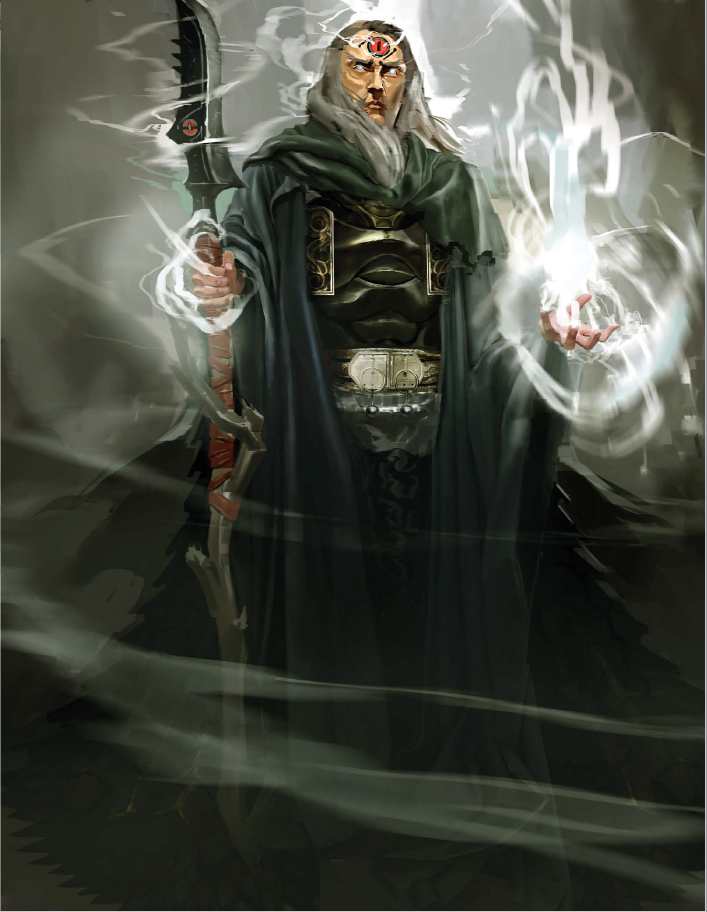
Battle With the Lord of Storms: Sydon does not fight alone: he has one of his favorite empyrean children accompanying him. Instead of immediately fighting the party, he will compliment them for their sheer bravery and give a short yet classic evil speech of “join me or die.” Unlike Lutheria, he has no interest in renewing the Oath of Peace: he spent centuries manipulating events for this eventual war and will look weak to his followers if he suddenly calls it off. Instead his terms are for the PCs to join him, otherthrow the Five Gods, and replace them as mortal kings of Thylea for a new order where he and only he is worshiped. In exchange he will spare Mytros, give divine legitimacy to their ruling status in exchange for sacrifice and tribute, and can give them magic items from his vault but only enough for half the party because he hopes to divide them via selfish greed.
The adventure naturally expects that the PCs will defy him and take up arms against the god, even more so than Lutheria. Joining Sydon and felling the Five Gods is not supported at all in the rest of the adventure path, so it sounds more like a Non-Standard Game Over where the PCs forsake their duties and join the cause of evil.
Sydon has more or less the exact same stats as his sister Lutheria. The major changes are that he’s Lawful Evil instead of Chaotic Evil and has a different load-out of innate spells, legendary actions, and a magic glaive and elemental bolt as his two main attacks. He’ll be a tougher match than Lutheria for several reasons: one, he has more long-range capabilities such as a 600 foot range elemental bolt which can take the form of lightning or any other energy type besides psychic and necrotic. He can create a fusillade of lightning bolts or strike the ground causing tremors as his Legendary Actions alongside the predictable ‘attack again’ option. His innate spells are of more immediate battle use: Greater Restoration can counter most debuffs, while Control Weather, Tsunami, and Storm of Vengeance are highly appropriate and useful in the terrain in which the PCs fight him. His utility spells include Water Breathing (to use on his followers), Water Walk, Pass Without Trace, and Plane Shift which can work only on himself. Only Pass Without Trace doesn’t really fit, given he doesn’t seem the type to be subtle.
However, Sydon will not fight to the death, even should his tower be collapsing. He would much prefer to be leading the siege of Mytros and use the map in the throne room to teleport to the city once he loses enough hit points. His empyrean daughter will fight and hold off the PCs in this case. Still, it is possible for the party to kill him, although the Battle of Mytros will still happen but in different circumstances.
Epic Paths: The Gifted One’s locket-grandmother can offer to spiritually bond with the dragon Nephele, granting it a soul which clones do not apparently have. Said dragon will now be able to speak and be slightly more helpful despite its mind now having warring personalities. The dragons in the arena will focus all of their attacks on the Dragonslayer. If the Gifted One and Sydon meet face-to-face, he will instinctively recognize the PC as their grandchild. The Lord of Storms will cautiously appraise the PC’s capabilities, but inevitably find himself disappointed that his descendant is but a tiny, frail mortal.
Thoughts So Far: I like this chapter much better than the Nether Sea, as it feels appropriately high-stakes for the eventual battle with a god. Sydon’s followers show actual tactical competence unlike Lutheria’s drug and wine-addled minions, and there’s a surprising amount of intrigue and alliances the PCs can take advantage of for a combat-heavy dungeon crawl. The various rooms paint a clear picture of Sydon’s plans and capabilities in a way Lutheria’s barge does not: the giant map-table, the scrying-telescope, the training arena, and even the optional encounter of the fleet sailing for war communicate to the players that this is a god who is taking the end of the Oath of Peace seriously.
While I understand that Lutheria’s psychotic nature and emotionally-stunted personality are tropes which can work for the right villain, I cannot help but feel that she fails in comparison to Sydon who feels like a much more existential threat. Not to mention less potentially problematic and squicky stuff besides the forced breeding of dragons. Which is still just one plot element to change around vs many in Lutheria’s case.
Join us next time as the Doom of Thylea arrives in Chapter 9: the Battle of Mytros!
This chapter happens on the 60th day since the PCs began their voyage
Original SA post
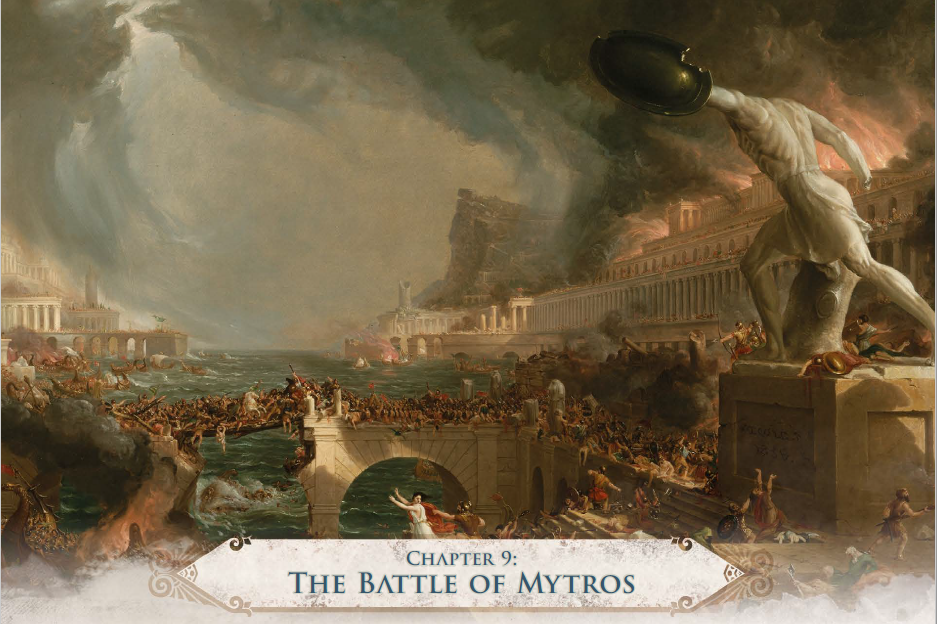
This chapter happens on the 60th day since the PCs began their voyage. 10 days before that Kyrah and the ship’s crew will grow increasingly worried and encourage them to speed up their quest if they have not confronted Sydon and/or Lutheria.
As the 60th day dawns, Kyrah and Pythor will dramatically watch gathering storm clouds on the Ultros’ Deck, grimly announcing that due to the Oath’s conditions they are no longer gods. Slowly they transform into their original forms, beautiful bronze dragons who take flight immediately so as to not weigh down the ship. Everyone present recognizes these dragons as the original ones who came to Thylea with the Dragonlords 500 years ago due to Special God Magic. Kyrah and Pythor will explain how the silver dragon Balmytria tricked the titans into giving up some of their divine power, which was used to turn themselves into the Five Gods. Mytros has since ascended to the celestial planes, with the other 4 watching over the realm left behind.
Of more practical concern, the 4 no-longer-gods have respectable stats as young bronze dragons but are Huge sized. PCs with the appropriate Epic Path or the Oath of the Dragonlord Paladin archetype can bond with them by sacrificing a magic item, although they will aid the PCs in battle regardless. Which seems a bit of a downgrade as said dragons will lose multiattack and have their breath weapons recharge on long rests...which due to the specifics of the battle below means they’ll only ever use it once per dragon the entire chapter!
Mytros is in chaos by the time the PCs arrive. Fleets of Sydon’s ships breached the harbor, and the city’s forces are losing ground to the invaders. King Acastus is holed up somewhere instead of animating the Colossus, while his silver dragon Icarus went insane from being fed too many aging potions and is attacking friend and foe alike around the harbor. Meanwhile Lutheria is taking advantage of the chaos if the PCs did not renew the Oath with her.
In the event that both Sydon and Lutheria are dead (or pactsworn in case of the latter), then Sydon’s forces still attack Mytros albeit serving under mortal leaders of their Order. Instead the PCs’ main threat will be Kentimane, who has come to destroy Mytros for the murder of his son and/or daughter.
Editing Retcon: I made a bit of a mistake in regards to the Nether Sea chapter. Lutheria will not go on her rape and murder spree in Mytros if the PCs swore Oaths of Service to her as part of the Oath of Peace bargain. Which makes what I thought was a major plothole less of one, although there’s still the issue of what happens if she’s called out when cheating at Twenty Squares.
There are 4 major encounters plus a 5th optional one comprising the Battle of Mytros, and the PC don’t even have time for short rests between them. The amount of civilian casualties is an important one, and numbers accrue on a variety of factors. In addition to their various allies the PCs have four of the former gods turned bronze dragons to aid them in all battles, but they can blunt said civilian casualties by dispensing two of said dragons to help evacuate the city and rescue people instead of helping for one encounter. Mytros smiles upon this self-sacrifice, and PCs who command her brethren to do so will receive divine blessings which last until the end of the siege. The encounters can be done in any order, although the fifth one will only activate if Sydon and/or Lutheria are killed.
 Trope Alert: Main City Under Siege! Mass Effect had a Reaper attack the Citadel at the end of the first game. Dragon Age’s epic conclusion took place in the capital of Denerim, while its sequel had the Qunari invade the city of Kirkwall where most of the game takes place. Although not a siege per se, the cult of Bhaal attempted to worsen relations between the city of Baldur’s Gate and Amn to forement a war in the original Baldur’s Gate game.
Trope Alert: Main City Under Siege! Mass Effect had a Reaper attack the Citadel at the end of the first game. Dragon Age’s epic conclusion took place in the capital of Denerim, while its sequel had the Qunari invade the city of Kirkwall where most of the game takes place. Although not a siege per se, the cult of Bhaal attempted to worsen relations between the city of Baldur’s Gate and Amn to forement a war in the original Baldur’s Gate game.The first encounter involves neutralizing Icarus, who is an Ancient Silver Dragon but suffers from disadvantage on rolls every other round due to not being used to his new powers. His massive body and breath weapon will inevitably result in more dead citizens unless the PCs direct his attention to them or otherwise neutralize his floundering maneuvers.
The second encounter involves confronting King Acastus at the Olympics stand. His so-called Order of Dragonlords are ineffectual, and after suffering many losses he figures that a mass human sacrifice along with the PCs will stay the Titans’ wrath. He also holds a Rod of Rulership which is needed to activate the remaining Colossus, which thankfully is still intact. Acastus himself is nothing special (he’s equivalent to a fighter around the PCs’ level) but he has 7 captains and young copper dragon mounts who can be a bother.
And yes, the Colossus of Pythor can be operated by one PC like a giant mecha. Seeing it walk improves morale among Mytros’ inhabitants, who point up to the horizon and shout that the gods have come to save them. The Colossus has a kickass stat block: it has an amazing 620 hit points, golem construct immunities, is impervious to nonmagical physical attacks, and has a giant spear attack and its own set of Legendary actions which includes an AoE stomp.
And before you ask, it has to be Acastus’ specific Rod of Rulership. The one possessed by the incubus on the Isle of Typhon does not count.
The third encounter involves confronting Sydon, and he’s not alone. Two of his empyrean children along with the three best warriors among the centaur, minotaur,* and gygan races make up his personal honor guard. Figuring that even the PCs will be awed by his unstoppable opposition, he’ll pull a Kneel Before Zod on them. Not to spare them, he just wants to humiliate them in public. PCs who play along and make a successful roll to trick him can get in a surprise round. If the PCs made a pact with Lutheria, she’ll show up for three rounds and attack her brother. Sydon has had it up to here with her** and focuses his attacks on her for this duration. Killing Sydon will result in an epic death throe where he looks in horror at his own wounds, unable to comprehend losing before bursting in a wave of power which sends torrential rains to blanket the region for weeks on end.
*which is a surprise, considering that the Order loves sacrificing them and looks down on them like much of Thylean society.
**their strained relationship is more or less offscreen.
If Lutheria is not constrained by the Oath, she’ll...sigh...be casually walking the streets of Mytros, casting spells to make citizens turn into animals and also to rape and/or cannibalize each other. Which is described briefly onscreen for the boxed text encounter. She finds the entire affair funny and will eventually attack the PCs out of boredom if they do not do so first.
The final encounter happens only if one or both Titans were killed, which is very likely as Sydon fights to the death. Gradually earthquakes will shake the region every minute, growing more intense until a giant hand slams down on the mountain range over the horizon. An even larger body connected to the hand will lift itself from a lying position to full height: it is Kentimane the Hundred-Handed, who has come to take revenge upon the PCs for slaying his children by destroying them and the entire city.
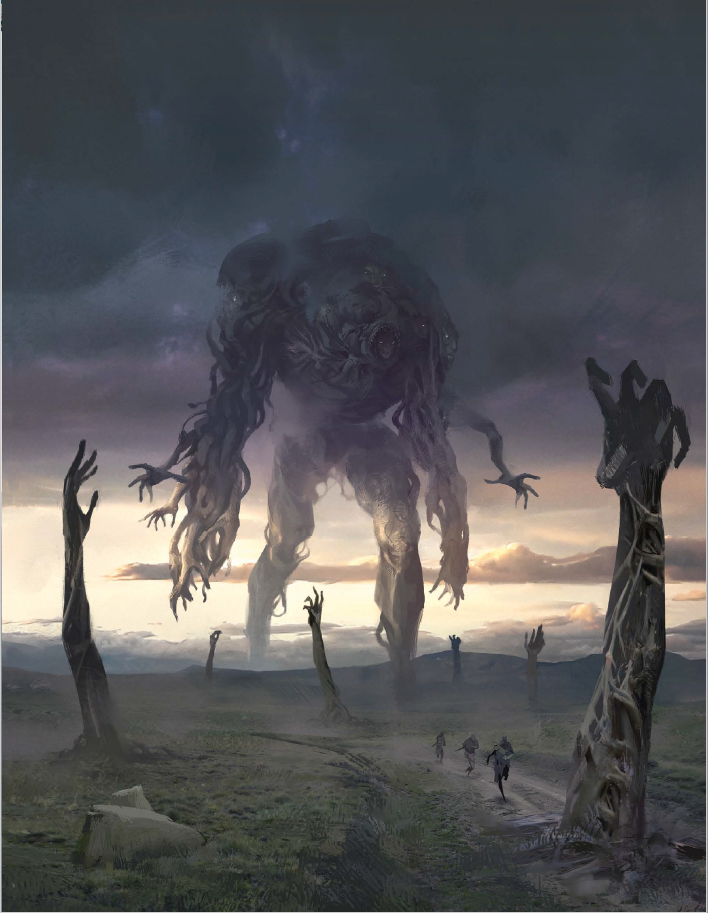
Kentimane is the strongest enemy in this entire adventure path. I’m just going to copy-paste his stat block below:
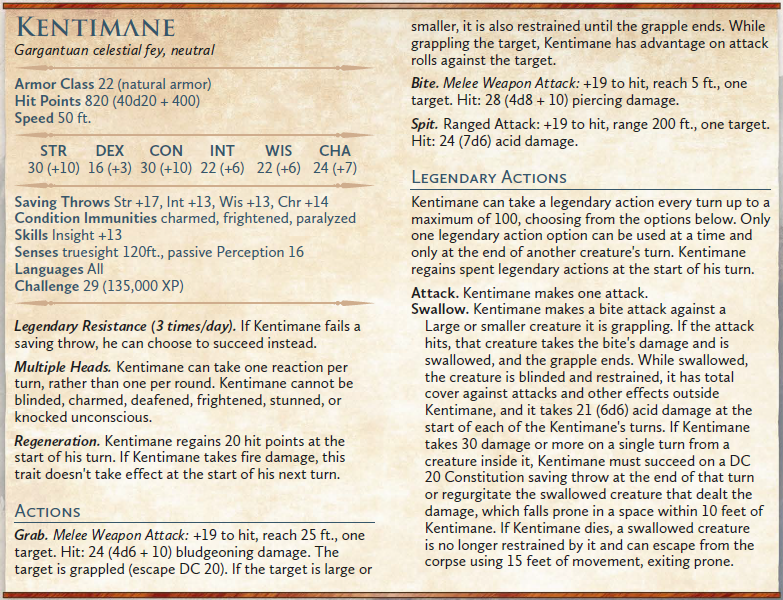
Even worse, the PCs have to defeat him in less than 10 rounds. Every round he deals immense collateral damage, destroying one entire neighborhood or large notable building. By the 10th round the city is in ruins. The PCs can mitigate some of these casualties by luring him away from the city (most likely offshore) or dispatch 2 bronze dragons to rescue 5,000 citizens.
At this point in the adventure path the designers assume that the party will be around 12th level. Not only did they likely fight one or two Titans, but also Sydon’s Empyrean children who are no pushovers themselves. And this is all without any short or long rests. Although they may have action economy on their side and a few NPC allies, chances are the party is in no condition to fight Kentimane at this time: the party warlock is likely reduced to their eldritch blasts, the primary casters’ best spell slots are likely expended, and limited healing resources will be consumed to make up for an inability to spend Hit Dice to heal due to the lack of short rests.
It’s up to the DM whether defeating Kentimane results in his true destruction or merely merging with the earth where he falls.
The battle’s conclusion depends on how many casualties the city as a whole took. The death toll is determined by looking at how many rounds the PCs took to defeat Kentimane* and deduct the values for every encounter where they sent the bronze dragons to rescue citizens. High casualties are a pyrrhic victory where people are in mourning and nobody really celebrates the PCs’ heroism. Medium means that there’s rejoicing at the fall of the Titans; the PCs are valorized and most certainly elevated to positions of political leadership. Low casualties are the same as medium, save that the PCs are viewed as practically gods and end up having many cults springing up dedicated to their worship.
*which makes no sense if he never shows up, as the casualties to defeating him in 1 round (literally impossible barring some 3rd party cheese or a horde of attacking characters with magical weapons and spells) are a mere 200 citizens.
But one thing is certain: there’s a huge power vacuum in Thylea. The old titans are either dead or powerless, the New Gods save Mytros are now but mortals, and the city-states of Estoria and Mytros lost their leaders. The rest of the adventure path focuses on this political/religious upset and the uncertain chaos that follows.
Thoughts So Far: Odyssey of the Dragonlords was originally a shorter adventure path in the initial KickStarter, and I have the feeling that this was its original endpoint. The stakes couldn’t be higher, and given Sydon’s likely retreat in Praxys means he will most certainly be fought here to a last stand. The Kentimane insertion feels like it was meant to be an alternate in case the Lord of Storms was slain beforehand. But it feels both unexpected and robs the PCs of an otherwise climactic encounter against the Titan siblings by throwing him in out of the blue.
The lack of any kinds of rest is meant to simulate desperation, but it really screws with PC resources and hurts the short-rest focused classes like warlock the most. Even should the party have allies beyond the bronze dragons and colossus, the legendary status of pretty much every major encounter besides King Acastus means that they’ll take a lot of special attacks and spells to put down.
Join us next time as the PCs get a strange request to find replacements for the lost gods in Chapter 10: the New Pantheon!
This chapter gives the PCs one year of downtime
Original SA post
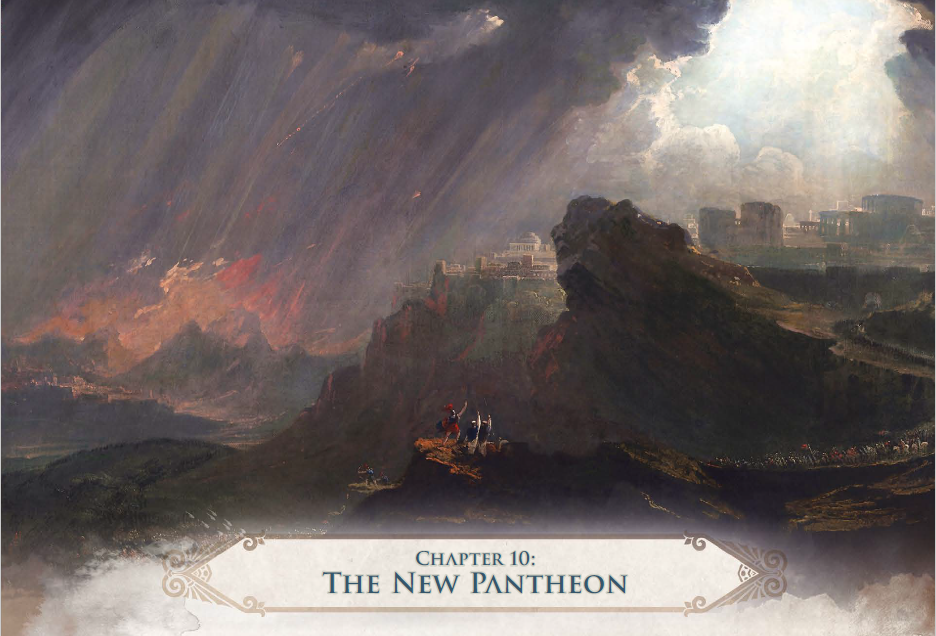
This chapter gives the PCs one year of downtime between it and the resolution of the Battle of Mytros. The details are left vague, but the DM can draw from the existing Fame system as well as one of the Appendices which details what happens when/if a PC builds a new Order of Dragonlords.
The destruction from the Titans’ fall left many refugees and scattered people, and various new settlements named themselves after various heroes who proved themselves during this time. Naturally several are named after the PCs, and there are perks for PCs who patronize and fund said settlements.
The adventure begins when the nymph Ekoh approaches the party with a message. Narsus was once one of the new dragon-turned-gods, but like his brethren he lost that spark at the end of the Oath of Peace. Five hundred years ago he was kidnapped by an obsessed queen of Aresia, and he’s lived as a hostage-guest in said city ever since. Ekoh was once in a contest to win the hand of said god in marriage, but the Aresian Queen cheated her out of it and kidnapped Narsus. Not only that, Ekoh claims that Narsus learned of a means of allowing mortals to ascend to godhood themselves, and that such knowledge is dangerous in the hands of the Aresians while also implying that he’ll give said secrets to whoever frees him. Meeting with knowledgeable NPCs to confirm this story demonstrates that the claim is indeed from Narsus; he’s too prideful to lie about something like this, which...sounds kind of contradictory to me; arrogant people exaggerate and lie all the time!
Aresia is on hostile terms with Mytros, and by extent Estoria, and the Dragonlords are not recognized as a legitimate organization in the city-state’s dominion. This makes the matter of just walking up to the city and asking for an audience unlikely. The adventure also implies that chaos will reign with the loss of the Five Gods and at least two of the Titans, but never goes into detail on the effects. Mytros and Thylea are still around, so it’s not a totally godless world even if the PCs killed Kentimane, Helios, and the twins Sydon and Lutheria. Does the world become a joyless, boring place without the Goddess of Music? Are timeshares and quack doctors making a killing without a replacement God(dess) of Wisdom? The adventure does not say.
The PCs have two major means of dealing with Aresia: they can lead an army to besiege it Trojan War style, or they can infiltrate the city and find a means to rescue Narsus themselves. Negotiation with Queen Helen of Aresia is an option, but the party’s NPC allies will advise against it unless they use the threat of invasion as a big stick in any dealmaking.
The adventure has a few open-ended results in however they proceed, although the siege by far has the most encounters. Instead of using a logistics mini-game in managing thousands of troops, the PCs have to accomplish several tasks during the war on a personal level in order to turn the tide in their army’s favor. In no particular order they must defeat a sapient bronze colossus named Talos defending the city; find and disable the artifact Palladium, which grants resistance against damage and advantage on attack rolls for Aresia’s walls and siege weapons respectively; and press the attack in several set-piece battles at the gates and bridges. There are also two times when the PCs will be approached by figures: the first is a siren messenger from the Queen who wishes to negotiate a ceasefire, and the second is the Shadowmaster who claims to be a servant of the Dragonlords and can help the PCs find the Palladium. The Shadowmaster is actually part of Lutheria’s cult, who still remains loyal to her even should she have been defeated by the heroes. They want to see Aresia fall for their own reasons...although you’d think that getting the PCs one step closer to divinity would make Lutheria’s job harder in the end. Oh well, I’ve learned not to expect any rational long-term plans from that weird sex cult.
If the PCs approach Queen Helen at any point, her terms are surprisingly reasonable: Narsus used to give public appearances in Aresia to adoring fans, but ever since the loss of his divinity they had to put a stop to this along with a rather large loss in morale. She wants to see her city’s divine status symbol return to his old self, and doesn’t even mind the idea of the PCs as a new pantheon, provided they promise not to “steal him away” from her.
The PCs can also find Narsus hidden in an underground chamber beneath one of the Aresian warrior-temples. The former god is here in bronze dragon form, happy that the PCs got his message. He was true about the godhood ritual, but he has no desire to leave Aresia whether for Ekoh or anyone else as all his needs are taken care of and he’s a local celebrity. If the PCs led a siege against the city, he’s entirely nonplussed about the devastation and loss of life, despite Aresia being his home for half a millenium.
This part of the adventure is a very large weak point. Although the grisly specifics are not mentioned, the Aresian siege results in suffering and death for the civilian population as well, and ironically the suggestions by pretty much every NPC advisor results in options that are worse in the long-term. Queen Helen’s demands are surprisingly reasonable and as such the PCs don’t really need to budge or renegotiate on any major matters. Chances are that if the party led a siege, they may feel more than a bit angered at Narsus’ callousness and deception and conclude that such a self-centered god should not have power over mortals. Compound this with the fact that it was one chapter ago that the party saw the effects of an invasion on the defending side, and the whole “we gotta invade ‘em!” encouragement from their allies may result in a loss of respect and trust.
Whether gaining an attendance by force or by word, Narus tells the PCs that they need 3 artifacts in order to perform the godhood ritual: the Caduceus, buried in the cairns of Aresia’s first King who is now a vampire; the Ambrosia, which has come into the hands of a minotaur warlord building up a personal army; and the Promethean Fire, which lies within the submerged former capital of the Siren race. The artifact hunt can be done in any order, although the Promethean Fire is much longer and covered in detail in the next chapter. If the PCs negotiated a peace treaty, then dealing with the vampire king and minotaur warlord are part of their end of the bargain in ensuring Aresia’s safety.
The City of Aresia
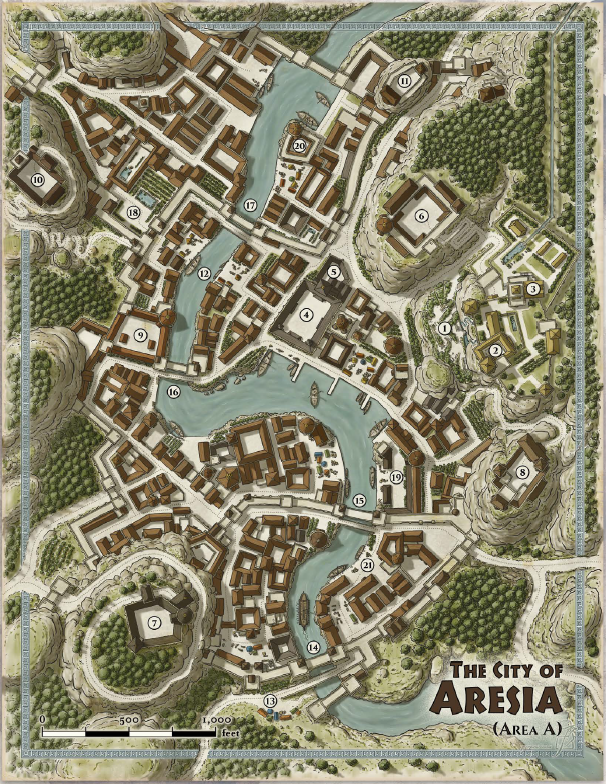
Aresia has a write-up much like Estoria and Mytros, although not to the latter’s extensive level of detail. We have a discussion of its political factions, a brief history, magic item shops, and random encounters and rumors. Sadly much of this will not be relevant during the siege, given that most of the location entries presume the PCs are infiltrating or that the city is not in the middle of war. There’s 21 location write-ups, but to sum up the place in broad strokes…
1. It’s Fantasy Counterpart Sparta. There’s still a civilian class, but pretty much everyone in power is some kind of warrior.
2. Said Spartan warriors are Monks, and every 5th Edition monk subclass in the core rulebook (and a few from Unearthed Arcana and supplements, like Way of Tranquility and a renamed Kensei via Way of the Sword) are represented here. They have a bit of a “rival fighting schools” theme where they compete against each other in tournaments. The Way of Shadow monks are a secret Lutherian cult, while the Way of Elements monks are like Avatar’s benders in that they use their talents for public works in addition to warfare.
3. Queen Helen hand-selects warrior-monks to serve as bodyguards. But she thinks with her vagina and chooses handsome young men over experienced veterans. Said bodyguards have to be abstinent in all other relationships besides those with her.
4. There’s a Sidequest where a woman is in love with one of the senior warriors, but he does not feel worthy of marrying her unless his mithral sword is recovered. Said sword is possessed by the minotaur warlord Zakroth, and the PCs can resolve this love affair by bringing it back.
5. Minotaurs have equal rights here, unlike much of Thylea. Aresia looks down on the rest of the continent for their barbaric practice of enslaving them.
6. Aresia grows the best olives in all of Thylea, and certain high-quality olive oil varieties mixed into potions can give 1 bonus die type to rolls granted by said potion. There’s also a more generic magic item shop run by a philosopher-wizard whose wares are stored in a bag of holding.
7. The Red Lotus restaurant has various NPCs and a bartender who can update the party on interesting goings-on.
8. PCs can get funding for an underwater expedition to the siren city by a merchant house who can give them magic scrolls for deep-sea survival, mundane ships, and sailors in exchange for 10% proceeds of treasure recovered.
Zakroth’s Prison Fort
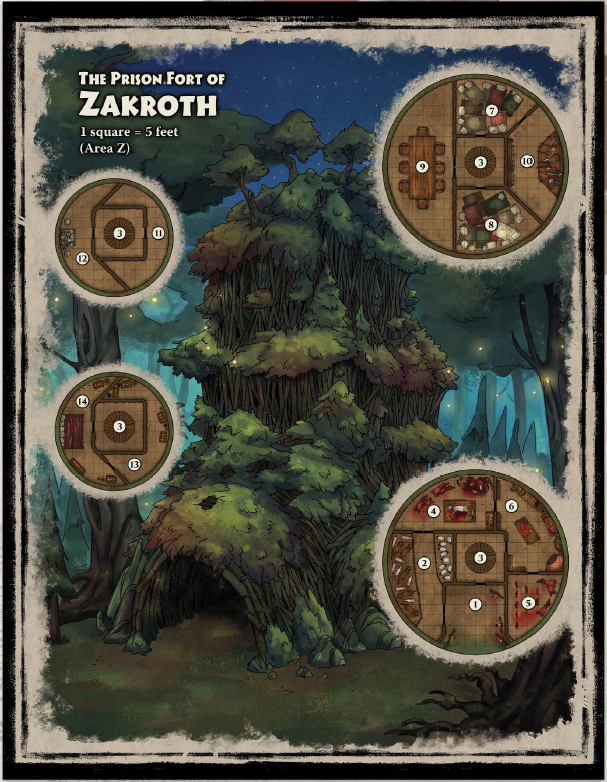
The Ambrosia is a drinkable container that enchants whatever liquid is put in it. It raises the user’s Charisma with every drink while also de-aging them to a minimum of 13 years or early adolescence for non-humans. Given that Zakroth has possessed this artifact for a while, this must mean he’s the most well-spoken and inspiring kid in all of Thylea.
Zakroth served faithfully under Sydon, and although his patron is most likely dead he still wishes to take revenge on the settler races. He’s built up a coalition of centaurs, minotaurs, and even gigantes (who are ugly and antisocial giants) under a unified banner where they intend to make Aresia an example for the start of their war. The fort is a 10 room, 4 level dungeon inside a multi-level treehouse. It would ordinarily be a straightforward crawl save for 2 interesting role-play-worthy encounters: the first one is a group of Maenad cooks will claim that Lutheria still lives (“you cannot kill death”) and that she is angry with the party while taunting them as a premonition of things to come. The other one involves the most powerful centaur chieftains giving their sons and daughters as guest-hostages to Zakroth as a gesture of trust and to ensure the unification of their alliance. Depending on how the PCs handle the hostages, they may determine how the various tribes treat the PCs’ political legacy. Peace between the native and settler races within the party’s lifetime is based on this.
Tomb of Karpathos
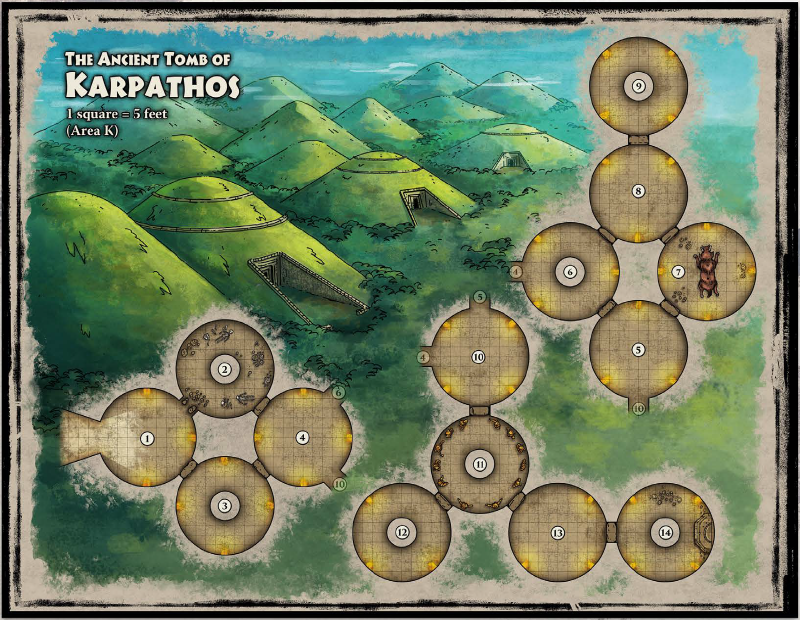
Karpathos was Aresia’s first and only king, and also had the unique title of Thylea’s first and only known vampire after breaking an oath to Lutheria. His own daughter sealed him and his brood in a barrow-mound, which is still watched over to this day by an honor guard of Aresian warriors. The Caduceus can be found in this mound. In the hands of a living creature it can grant powerful healing magic, but in the hands of an undead or a friend it can create powerful undead. Karpathos has been using the artifact to make more vampire spawn, but given that they cannot leave the tomb’s boundaries due to magical wards (Forbiddance and Antipathy/Sympathy in case the PCs wish to dispel it) his army is rather self-contained.
The tomb is a 14 room dungeon with branching pathways, and is rather underwhelming. A fair amount of the encounters are vampire spawn trapped under millstones, and they are incapable of action unless the PCs remove said weights. But as the weights do not block off any pathways or contain visible treasure, there’s nothing preventing the party from destroying the undead while they’re helpless: their torsos are pinned, the rest of their bodies visible. Karpathos’ wife, Queen Nemosyne is also pinned in such a manner, although Karpathos rests in a sarcophagus which holds Caduceus (and him) which makes fighting the head vampire mandatory. However, Karpthos cannot be slain as a typical vampire; a portrait of him at an Aresian art gallery is tied up with his essence, and it must be destroyed in order to kill him for good. The PCs have no means of finding this out save via divination spells, although chances are the PCs may slay him once and take the artifact, thus having no incentive to go back into the tomb as long as the magical wards hold up.
Thoughts So Far: The first adventure of Odyssey’s third act is off to a rather weak start, and I’m sad to report that it doesn’t improve much from here. The motivating hook in helping create a new pantheon requires a specific type of party set-up to jump at this task, and the whole “it’s in the hands of the Aresians” threat feels hollow given that said city-state has not been a visible element save as background dressing during the prior chapts. Although it is possible for the PCs to use another god (such as Thylea or Mytros) to attain godhood, the plot heavily sells them on the necessity of using Narsus to grant divine titles to mortals in the creation of this new pantheon. The idea that the PCs may become gods is appealing, but there’s no mention of what happens should they be humble enough and set out to find NPC replacements: no such candidates are listed for who can follow in the Five Gods’ footsteps, which is a wasted opportunity.
I talked earlier about how the NPC advisors all get unifying opinions in regards to the Aresian invasion, and how this is problematic. The lack of alternative and conflicting opinions seems at odds from what I’d expect to be a motley crew of allies gained during prior adventures. That said advice results in the worst options in terms of loss of life, and that Queen Helen’s demands are more or less what the PCs would want to do anyway, takes a lot of bite out of the entire affair.
Join us next time as we battle Scylla in the lost city of the Sirens in Chapter 11, the Sunken Kingdom!
The major hindrance in venturing to the siren’s forgotten city is that it’s well, forgotten
Original SA post
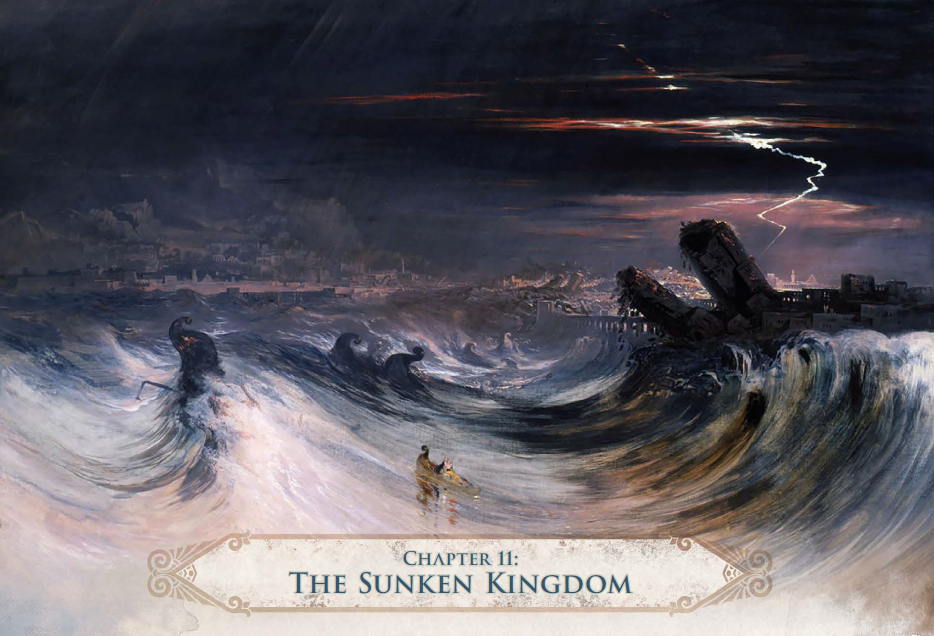
The major hindrance in venturing to the siren’s forgotten city is that it’s well, forgotten. And also several hundred feet below sea level, but prior contacts can help with the latter should they lack the means of breathing water themselves. Fortunately for the former, one of Narsus’ siren attendants has an undersea map to the place! This chapter takes place entirely underwater, and we get a handy repeat of rules for combat changed by this: to sum things up, fire attacks deal half damage and an assload of weapons have disadvantage on attack rolls. The city itself is several hundred feet below sea level, and a civilization of merfolk now live among the ruins. Said merfolk are at war with a group of merrow who came from a nearby abyssal trench known as the Chasm. A great monster known as Scylla lives at its bottom, and the merrow take captives to sink corpses down there for sacrifices. It won’t be long before the merfolk petition the PCs to save their people.
The merfolk worship a group of empyreans as gods, who live within the shrines of the Temple District. They are capable of great feats of might and magic but are unable to leave the confines of their respective temples. The key to their freedom lies with the death of Scylla, a task the merfolk have yet to perform. Said empyreans will be quite helpful to the party, explaining that Scylla ate the artifact in which they seek and will butter up the PCs: they’ll speak of how they were once a lost pantheon, but feel that Thylea’s fate is bright in the party’s capable hands. To better seal the deal, each empyrean has a unique gift for one PC, ranging from a monstrous companion to fight at their side to magic items and boons. Some of the empyreans have higher standards than others, and demand some kind of trial.
The empyreans are liars. You see, there was once a great angel by the name of Phaeros who was exiled by his kind for believing that godhood is a right for all mortals. He sought to find a more worthy pantheon than the reigning titans of Sydon and Lutheria, so he visited the city of the sirens to find those he believed could challenge their reign. From there, he made a new pantheon of empyreans. The titan twins learned of this and asked their father Kentimane to unleash Scylla upon the city. Together with their mortal armies, they sunk the realm beneath the waves while Lutheria tricked the empyreans into being cursed to never leave their sunkern temples. Phaeros and the Promethean Fire were swallowed by Scylla, their only means of breaking the curse of imprisonment. This forgotten pantheon has grown mad in the passing millennia and seek vengeance upon those they believe abandoned them: said criteria includes all mortalkind.
The empyreans are all evil alignment save for one Chaotic Neutral crazy trickster god, and their gifts are twisted such that they will turn against the party: boons and magic items become curses, while companions fly into a rage and attack. However, none of the empyreans have means of magically concealing their alignment, meaning that the PCs may very well spurn their aid and reconsider the whole Scylla-killing business if the party contains...oh, let’s say a Paladin who realizes that empyrean after empyrean is radiating big honking gobs of Evil!
The merrow seized a fortress in the city which has 40 of their rnumber along with a coven of 3 sea hags, and there are various other small locations the PCs can explore in the city itself although most of it is free of danger and mostly role-play.
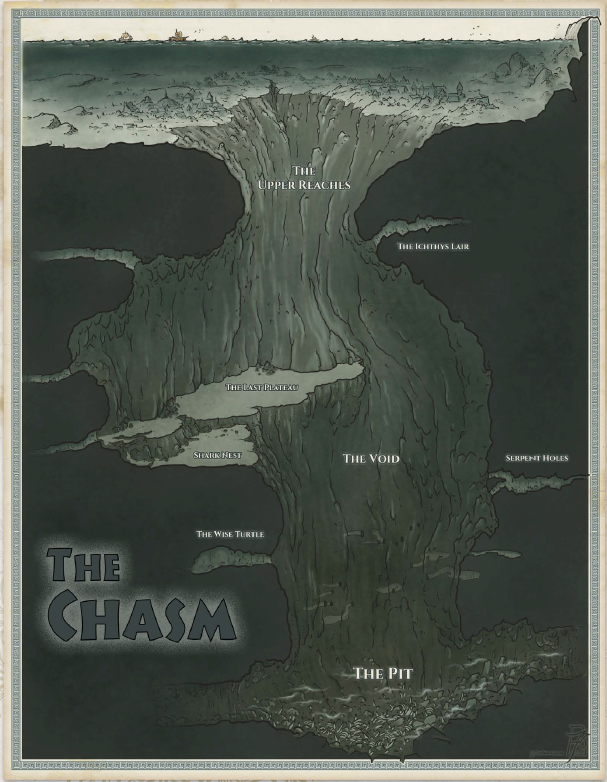
The Chasm is a 2-mile deep pit with three broad layers. The Upper Reaches are barely lit and home to most typical sea life. The Void is halfway down and completely dark, home to gigantic primordial creatures and a tribe of ichthys.* The very bottom of the Chasm is a cavernous floor covered with the corpses of whales, merfolk, and other things that drifted down to the bottom. Tunnels and trenches hold portals to the Nether Sea at this depth.
*like centaurs but evil and with lower halves of lobsters.
One of the set-piece encounters is a nest of 36 sharks of the giant and cetus varieties asleep on a sandy ledge in the Void, and the adventure notes that waking the creatures will be suicidal for the PCs. Now I know that 5th Edition’s bounded accuracy makes it so that hordes of monsters can be dangerous even at the highest of levels, but there’s something...tonally dissonant about the whole affair. In prior chapters the party killed gods, possibly besieged a city of Spartan look-alikes with a Colossus protector, and did many other heroic deeds. But the adventure assumes that a nest of sharks is where they draw the line and decide that discretion is the better part of valor.
Scylla is the Boss Monster of this adventure, and she is a creepy, screaming bloated mass with six canine heads connected by serpentine necks. She is a tough cookie, on par with Sydon and Lutheria statwise but with slightly worse saves and no spells. Her primary means of attacks are her many biting heads and tentacles, and she can sing an AoE dirge that charms those who fail a Wisdom save which can also be done as one of her legendary actions (the others being bonus attacks and movement).
Once the PCs kill her, Phaeros will cut his way out of the corpse, holding a blue orb of fire in one hand: the Promethean Fire. He will praise the PCs for freeing him, and mention that he must now complete his sacred task and ‘restore the rightful pantheon of Thylea.’ What he means is that he will use the Promethean Fire to free the empyreans; he will fly up out of the chasm while ignoring any attacks directed at him. The adventure assumes that the PCs will be unable to catch up to him even though spells like Dimension Door are easily a thing at this part in the plot. When the PCs reach the Sunken City he will suddenly turn on the party once the emypreans are free, proclaiming them to be blasphemers for trying to use the artifacts to become gods themselves. How would he know this unless they spilled the beans to the empyreans? Also, isn't this contradictory to his earlier ideology of spreading the god-wealth around? The adventure says he does this due to fear that he may challenge the empyreans' right to rule, but otherwise makes no mention of how and why he changed his ideals over time.
The PCs can gain the Promethean Fire from Phaeros after killing him, and the empyreans will feign ignorance and claim that the angel must have gone crazy from time spent being digested. They will pretend to leave Thylea forever, but in reality seek to learn of the land and rebuild their strength for the coming time of vengeance.
But at least the PCs have all 3 artifacts now. They should be able to challenge these empyreans as God-to-God for a thrilling climax, right? Wellllll, about that...I took a look at the rules for the Theogenesis ritual and contrasted it with the expected experience levels at certain points in the adventure path:

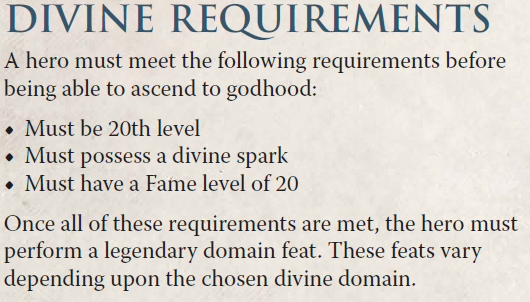

If the PCs didn’t want to strangle Narsus before, they almost certainly will want to do so now.
Thoughts So Far: I’m beginning to see a recurring theme in this third act of the PCs managing to make things worse in their quest for godhood. While the Aresian campaign could be averted, the Sunken Kingdom is far more railroady in its expectations and resolution. It presumes that the PCs will take the empyreans at their word, be unable to intercept Phaeros before he frees said empyreans, and then kill Phaeros anyway after the deed is done. The backstory is something the PCs have no real chance of finding out, so it’s very much in the style of Paizo’s adventure paths which give enemy NPCs detailed write-ups that most players are never going to learn. Contrast this to that of Sydon and Lutheria, or the legacy of the Dragonlords, or even the kidnapping of Narsus and the Aresian Campaigns. Odyssey has been rather good in giving opportunities for the PCs to learn of the world’s past and how that affects their current adventures, but this chapter only works if the party is kept in the dark about as much as possible for as long as possible.
Join us next time as we wrap up the conclusion to this adventure path in Chapter 12, Apokalypsis!